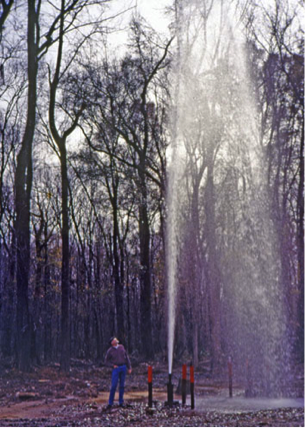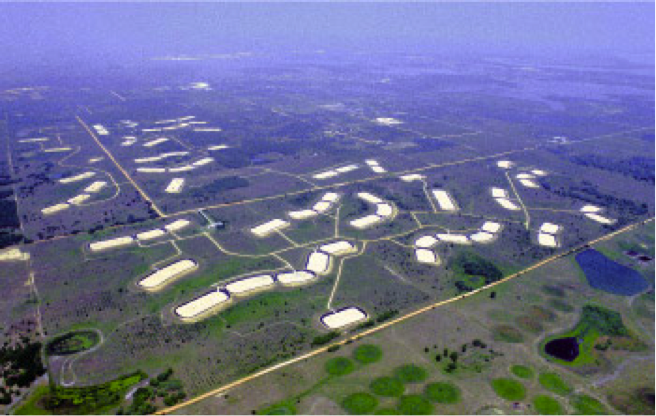Unit 2: Physical Hydrology
Unit 2: Physical Hydrology
Overview
This section of the course outlines the distribution of water on land and its organization into watersheds and major river systems. Rivers are one of the major concentrated sources of fresh water that can be extracted for human use for agriculture, industry, and drinking water, prior to flowing into the oceans. Another potential source of fresh water is so-called "groundwater," which consists of water held in subsurface rock units with varying potential for storage and yield. This helps us explain the distribution and dynamics of water at the surface and in the subsurface of the Earth. At times the water distribution through river systems is either subject to a deficit of water (drought) or surfeit (flood), subject to variations in climate or to unusual meteorological events. Humans attempt to control these variations by constructing dams to regulate river flow and store water for use, particularly in dry regions. However, dams, although providing water and power, have consequences for the environment.
This section provides a more detailed overview of water transport and availability and highlights issues with water storage in reservoirs and in the subsurface. In subsequent modules, we learn how water availability influences civilizations, both past and present.
Modules
- Module 3: Rivers and Watersheds [1]
- Module 4: Flood and Drought [2]
- Module 5: Dam It All! [3]
- Module 6: Groundwater Hydrology [4]
Unit Goals
Upon completion of Unit 2 students will be able to:
- Describe the two-way relationship between water resources and human society.
- Explain the distribution and dynamics of water at the surface and in the subsurface of the Earth.
- Synthesize data and information from multiple reliable sources.
- Interpret graphical representations of scientific data.
- Identify strategies and best practices to decrease water stress and increase water quality
- Thoughtfully evaluate information and policy statements regarding water resources
- Communicate scientific information in terms that can be understood by the general public
Unit Objectives
In order to reach these goals, the instructors have established the following learning objectives for student learning. In working through the modules within unit 1 students will be able to:
- Explain the processes by which precipitation accumulates, moves through, and is transported out of a watershed.
- Describe the physical components of a river channel and floodplain.
- Define the different types of sediment transported in rivers and explain to a first-order the physical processes governing sediment transport.
- Explain the various techniques by which humans attempt to restore hydrologic, geomorphic and ecological functions of rivers and watersheds.
- Explain the role of ‘extreme events’ in the water cycle and distribution of water on Earth’s surface.
- Explain a few basic techniques for organizing and analyzing hydrologic data, including time series plots and histograms.
- Articulate the difference between a forecast and a prediction and provide examples of each.
- Define the term flood, describe the factors that influence the magnitude of a flood, and explain the implications of floods for society and ecosystems.
- Compute the probability that a flood or drought of a given Recurrence Interval might occur (e.g., the 100 year flood).
- List the different types of droughts and be able to explain the basic implications of each for society and ecosystems.
- Define the terms stationarity and non-stationarity and explain the implications for flood predictions.
- Explain the reasons why dams are built, and how these differ in different locations
- Weigh the advantages and drawbacks of large dams
- Consider the causes of conflict and controversy across national borders associated with large dam projects
- Explain the issues caused by sediment trapping behind dams
- Debate the justification for building and rationale for removing dams
- Identify an artesian well and predict where artesian wells will be found
- Distinguish between porosity and permeability
- Associate hydraulic properties with given rock types
- Interpret relative permeability from a well productivity diagram
Module 3: Rivers and Watersheds
Module 3: Rivers and Watersheds
Overview
In this module, we will investigate the processes by which precipitation accumulates in, moves through, and is transported out of a landscape. We will especially focus on flow of water in streams and rivers, including how these important features form and change over time. The goals of the module are to develop an understanding of the water cycle at the watershed scale, as well as to explore the variety of rivers that exist on Earth’s surface, develop an understanding of how those rivers change over time and learn how to measure the amount of water transported by a stream or river. As part of this, you’ll come to understand how water is conveyed to a river, and become familiar with terms such as flow duration, sediment transport, channel and floodplain morphology, and stream and watershed restoration.
Goals and Objectives
Goals and Objectives
Goals
- Explain the distribution and dynamics of water at the surface and in the subsurface of the Earth
- Synthesize data and information from multiple reliable sources
- Interpret graphical representations of scientific data
Learning Objectives
In completing this module, you will:
- Identify and describe the processes by which precipitation accumulates, moves through, and is transported out of a watershed
- Describe the physical differences between terrestrial and stream systems
- Qualitatively evaluate stream gage data
- Visually identify various common channel morphologies in Google Earth
- Describe physical characteristics of a river channel, including stream order, number of channels, and sinuosity
- Analyze how topography influences water movement over land
Water Moves Through the Landscape
Water Moves Through the Landscape
The most obvious way water moves through a landscape is via stream and river channels. There is no formal definition to distinguish between brooks, creeks, streams, and rivers, but generally speaking, the former terms refer to smaller waterways and the latter refer to larger waterways. The terms stream and river are often used interchangeably. There are over 3.5 million miles (5.6 million kilometers) of streams and rivers in the US. If all the streams and rivers throughout the US were lined up one after the next, they would extend the distance from Earth to the moon and back...seven times! That is an incredible length of streams to be monitored, protected, regulated, and (occasionally) repaired by federal, state and local agencies, as well as industry and non-profit organizations and individuals. In addition, streams sculpt much of the surface of the Earth, forming a multitude of beautiful patterns and awe-inspiring features, as shown in Figure 1.
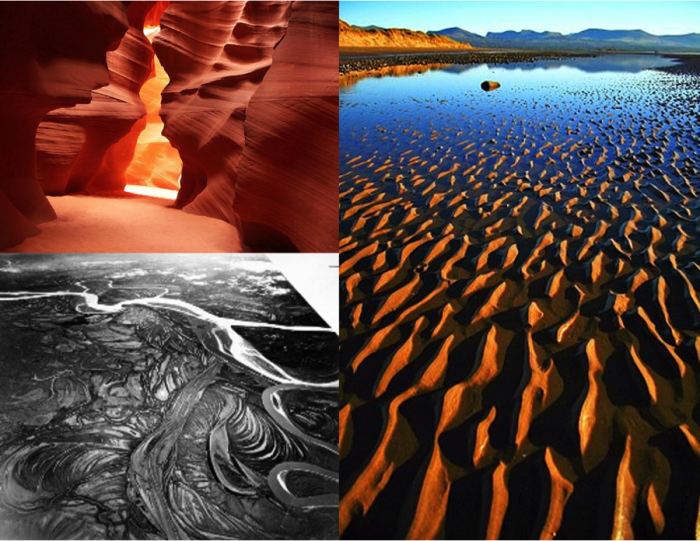
Channel Networks and Watersheds
Channel Networks and Watersheds
Streams naturally assemble themselves into surprisingly well-organized (quasi-fractal) networks. Figure 2 shows a typical channel network where many small streams converge to make progressively larger streams. The smallest streams in the network, which have no other streams flowing into them, are referred to as first order streams. When two first order streams meet, a second order stream is formed. When two second order streams meet, they form a third order stream, and so on. According to this conventional stream ordering system, first developed by Horton (1945) and refined by Strahler (1957), when a smaller order stream (e.g., first order) meets a larger order stream (e.g., second order), the resulting stream retains the order of the larger stream (in this case, second order).
Each stream has a watershed, also known as a ‘river basin’ or ‘catchment’ because it is the land that ‘catches’ precipitation and funnels it towards the stream. The watersheds of two first order streams are outlined with grey dashed lines in Figure 2. The watershed of a second order stream is outlined in black dashed lines and encompasses the two first order watersheds. The solid black outline in Figure 2 shows the watershed boundary for the fourth order watershed, which encompasses all other watersheds nested within it. The right side of Figure 2 shows the Mississippi River watershed highlighted in green, with the Missouri River watershed nested within it, highlighted in orange. By the time the Mississippi River reaches New Orleans, it is a tenth order stream (though only a few of its largest tributaries are shown in Figure 2), and drains more than one-third of the contiguous US.
The concept of connectivity between rivers and their watersheds will come up again towards the end of this module in the context of restoration. If a particular stretch of stream is impaired for one function or another (e.g., fish habitat has been degraded), in some cases it makes sense to ‘fix’ that specific stretch of river, while in other cases the impairment is simply a symptom of problems higher up in the watershed, so the ‘fix’ may need to be applied at that location in the watershed before human intervention or natural processes can begin to repair the impaired stream. Such is the way that watersheds and streams are connected.
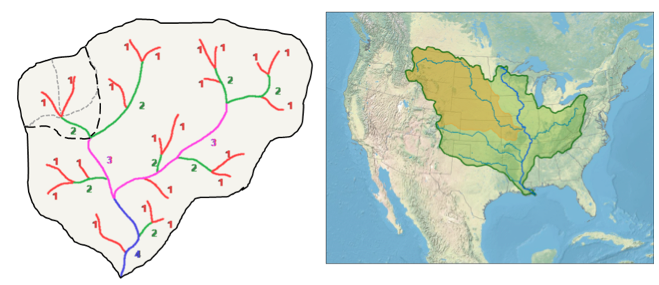
Watersheds are Complex Systems
Watersheds are Complex Systems
When you look around, you see that the world is full of systems…assemblages or combinations of things that form a functional unit. Some systems are human-made, others are made by nature. Some systems are simple, meaning the way they work is straightforward and the outputs from the system are easily predictable. Other systems are complex, meaning they often have many parts that interact, often in non-linear ways, making the outputs from those systems more difficult to predict.
For example, a coffee maker is a pretty simple system. You put in 8 cups of water and two cups of coffee grounds and (assuming you put them in the right places), you turn the machine on and get ~8 cups of coffee. If you change the amounts of either of the inputs, it is pretty easy to predict the impacts on the coffee you brew.
Watersheds are not such a simple system. They are incredibly complex. One example can be seen in how the relationship between rainfall and runoff changes throughout the year. In a simple system, you would expect a constant relationship between incoming rainfall and outgoing flow. For example, a 1-inch rain event should translate to a stormflow hydrograph that might last 2 days and peak at 1000 cfs. But this isn’t what we see. Figure 3 shows streamflow (blue line, values on the left axis) and precipitation (orange bars, values on the right axis) from March through September 2008 for the Maple River near Rapidan, Minnesota. Precipitation is relatively evenly distributed throughout the year. As you can see, in April and May, rainfall events that are 0.5 to 1 inch result in relatively high flows (1000 to 1500 cfs). However, in July, August, and September, similar rainfall events hardly elicit any flow response whatsoever! Why do we see such non-linear behavior?
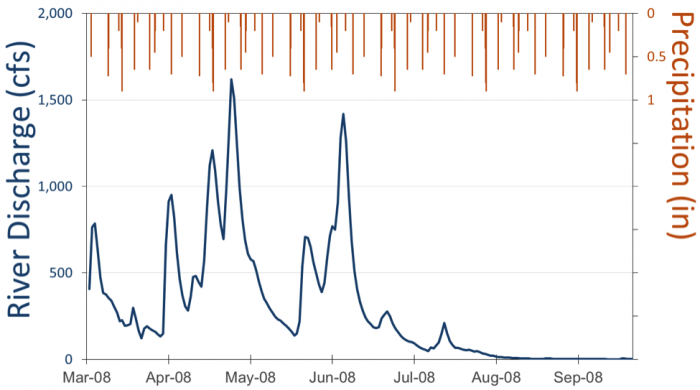
Activate Your Learning
The Maple River example above is a relatively extreme example of changes in rainfall-runoff relationships because soils are relatively wet (and therefore can’t absorb much of the incoming rainfall) in the spring and there is very little vegetation to intercept or evapotranspire water (the watershed is covered in row crops that don’t grow much before mid-June). In contrast, the row crops are in full effect by mid-summer and early fall and therefore they dry out the soil, intercept some incoming rainfall and evapotranspire most of the rest of the incoming rainfall…so it never gets to the channel! But similar phenomena can be seen in other watersheds. Find precipitation and streamflow data for a watershed of interest to you (from the USGS website, NRCS SNOTEL website, or NWS website). Plot them as shown in Figure 3. How well does flow correlate with precipitation? Are there seasonal differences? Differences from year to year?
ANSWER - NEED ANSWER OR TALKING POINTS.
Watersheds comprise many interacting parts. Figure 4 (top panel) is one way to represent various ‘parts’ that might be considered to comprise the watershed. While this is clearly a very simple view of this complex system, it is useful to take a “crude look at the whole”, a term coined by Nobel Prize-winning Physicist Murray Gell-Mann, as a starting point. When one component of the system is systematically changed, it may have direct as well as indirect impacts that propagate through the system. For example, changes in precipitation, snowmelt regime, or water storage may change streamflow. This altered streamflow has direct effects on river channel morphology, sediment transport, riparian vegetation, water quality, nutrient processing, and biodiversity, as indicated by the yellow arrows in the middle panel of Figure 4. But there are other interactions within the system, feedbacks that are indicated by purple arrows in the bottom panel of Figure 4. So to predict impacts of the changes in flow on aquatic biodiversity you would have to take into account not only the direct effects (yellow arrow between flow and aquatic biodiversity, but also the indirect effects associated with changes in channel morphology. This concept is also relevant in the context of watershed ‘restoration’. If a particular stretch of stream is impaired for one function or another (e.g., fish habitat has been degraded), in some cases it makes sense to ‘fix’ that specific stretch of river, while in other cases the impairment is simply a symptom of problems higher up in the watershed, so the ‘fix’ may need to be applied at that distant location in the watershed before human intervention or natural processes can begin to repair the impaired stretch of stream.
These notions of complex feedbacks and cascading effects greatly complicate the process of predicting what impacts human activities or natural disturbances within a watershed might have downstream. We’ll come back to this theme of system dynamics and complexity throughout the course.
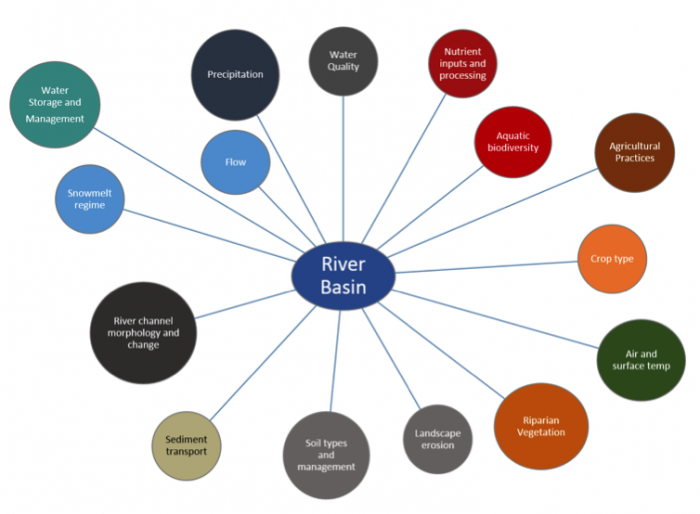
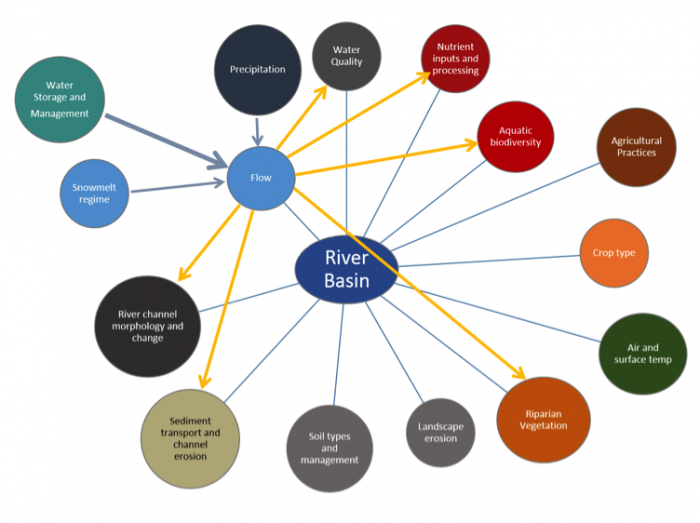
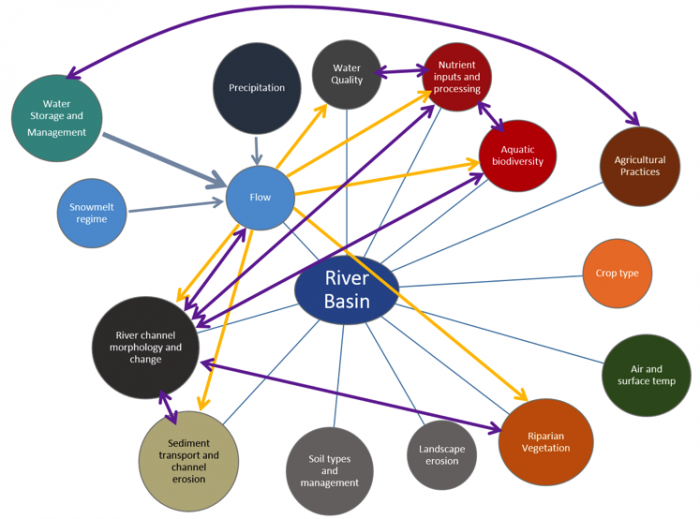
Streams
Streams
Streams are the most obvious way that water is moved through a watershed because we see them all over. But there are many other means by which water moves, as discussed in module 2. Figure 5 illustrates the various stocks (places were water is stored, even if only temporarily) and fluxes (mechanisms by which water moves) of water that may exist within any given watershed. For example, one raindrop might fall onto vegetation (called interception) and subsequently be evaporated back up into the atmosphere. Another raindrop might fall onto the soil surface and then runoff the surface into the stream channel or it might infiltrate down into the soil. Once in the soil, the water might further percolate down into the groundwater, where the soil or rock is saturated with water. Alternatively, once in the soil, the water might travel downhill within the soil and runoff into the stream or it might be taken up by vegetation and transpired back into the atmosphere. Estimating and predicting which, and to what extent, water travels through these pathways is an active field of hydrologic research and is also vitally important for environmental management and policymaking, as certain pathways may be more or less prone to filtering or polluting water along its journey to the place where you might want to use it for drinking, irrigating, fishing, swimming or the myriad other purposes for which we need water.

River Flow Changes Over Time
River Flow Changes Over Time
The amount of water moving down a river at a given time and place is referred to as its discharge, or flow, and is measured as a volume of water per unit time, typically cubic feet per second or cubic meters per second. The discharge at any given point in a river can be calculated as the product of the width (in ft or m) times the average depth (in ft or m) times average velocity (in ft/s or m/s).
The vast majority of rivers are known to exhibit considerable variability in flow over time because inputs from the watershed, in the form of rain events, snowmelt, groundwater seepage, etc., vary over time. Some rivers respond quickly to rainfall runoff or snowmelt, while others respond more slowly depending on the size of the watershed, steepness of the hillslopes, the ability of the soils to (at least temporarily) absorb and retain water, and the amount of storage in lakes and wetlands.
Video: How to Measure a River (8:35)
Good morning. I'm Barry, I'm Ben. We're the Geography Men.
Ben: Now today I'm going to be showing you how to measure the discharge of a river. Now for this what you're going to need is a tape measure, a meter stick, a flowmeter, a couple of stakes to help you out, and a recording sheet to record your data.
So the first thing you're going to want to measure is the width of the river. Now as I said before, for this you're going to need a tape measure, preferably let's say a 30-meter tape measure. Now from the left-hand bank, you want to have your 0-end of your tape measure. The easiest way to do this is to tie it to something or to use a stake in the ground. Now here I'm going to tie it to this root just to help me out. Now you want to stretch the tape measure across the river, making sure that it is tight across the surface of the water. You do not want to allow it to go slack, otherwise, that tape is going to get carried off by the river and you are going to get a false measurement of the width of your river.
Now that you have your tape set across your river, you want to record where the river begins, where the water meets the bank. Record on the other edge, on the other bank, where the water meets the bank, and then work out that distance from one bank to the other.
With this river here, our left-hand bank starts at 1 meter 60 and our right-hand bank ends at 5 meter 60, giving us a width of our river of 4 meters. Now the next thing we need to do with that width is we need to divide it by 11, in order to work out the intervals at which we need to work out the depths of our river. The reason we divide it by 11 is because we're going to take a measurement at each of the banks. This will give us 10 intervals across our river to take our depth.
Now for our depth, we're going to want to use a meter stick. Now with the meter stick, there's some very simple things that you need to remember. Number one, make sure the zero end of the stick is at the bottom of the river. You don't want to have it upside down and be getting readings of 80 or 90 centimeters. You want to turn the meter stick parallel to the flow of the water, so as that meter stick does not block that flow of the water giving you two false values on either side. Starting at the bank, place that meter stick into the water until it reaches the bed of the river. Now you want to take a reading and you want to convert that reading straight into meters, as you want the same units for each of your measurements. So here we have 25 centimeters, so we have naught .25 meters. Find your next interval on the tape and do exactly the same again. We have naught .21. Naught .24. And you would then follow that across the river until you reach the right-hand bank.
Now the final measurement you want to take at your site, to work out the discharge of the river, is a flow reading. You want to work out how fast that water is rushing past your feet. Now for this, the flow meter is the best option. However, if you do not have a flow meter, you can use a float and a tape measure and work out how fast that float flows down 10 meters of your stream. You can then convert that into a speed. With the flow meter, the propeller on the end spins as the water rushes past it and you get a reading in meters per second. As we take three readings across our river, you want to do it a quarter of the way across, a half of the way across, and three-quarters of the way across channel, making sure that you or anyone else in the group are with you, are not stood directly in front or behind the flow. You want to place the flow meter into the river 1/3 of the way down and record the flow in meters per second from the electronic box, every 10 seconds for one minute you. So here our first reading is naught .94 meters per second. Now we leave it another 10 seconds. Our next is naught .78. And you would then repeat this every 10 seconds for one minute, giving you six readings for the left-hand bank, one-quarter of the way across the river. You then repeat this at the halfway mark. So you're halfway across your river again, you want to place that flow meter a third of the way down into the channel. And again, every ten seconds for one minute record how fast that water is flowing in meters per second. You then repeat that on the right hand back three-quarters of the way across the river.
Now that you've got your measurements done, the next step is to work out some calculations. The first calculation you're going to need to work out is your cross-sectional area. For your cross-sectional area, you need to times your width by your mean depth. For our calculations, we got a width of 4 meters and our average depth worked out at 0.2 meters. Now this gives us a cross-sectional area of naught .8 meters square. Now with our cross-sectional area we can now use our velocities and work out a mean velocity from our six at the left bank, our six in the middle, and our six at the right bank, and used both of those calculations to work out the discharge of our river in meters cubed per second or cumecs. Now we know that our cross-sectional area is 0.8. And we've worked out that our average velocity, our mean velocity, is one meter per second. This quite simply gives us a discharge of 0.8 cumecs or meters cubed per second.
Hydrograph
Hydrograph
A hydrograph is a graph of discharge over time. The time period shown could be short, for example, the flow resulting from an individual rain storm, or it could be long, for example, a continuous record of flow over many decades. While numerous federal and state agencies, corporations, and individuals monitor discharge in streams throughout the country, the US Geological Survey is the chief entity charged with monitoring streamflow, maintaining over 9,000 stream gages, most of which record water discharge in 15 minute intervals and many of which also include water quality data. Visit the USGS Water Resource webpage (water.usgs.gov) and peruse the wealth of information compiled to assess water resources. Exercises utilizing these data are included below in module 3 as well as module 4.
The Figure 4 shows example hydrographs from the Logan River, near Logan, Utah for two different water years (2006 and 2012). The water year begins October 1 and ends September 30. Hydrologists often prefer to conduct analyses based on the water year rather than the calendar year to facilitate comparison of incoming precipitation and outgoing streamflow, and specifically to ensure that snow delivered in October, November, or December is accounted for in the same time period that it is likely to melt, which may be in spring or summer of the following calendar year.
The Logan River hydrograph shows a long (about 5 month) prominent peak in discharge, primarily driven by snowmelt, with many other smaller peaks superimposed (from accelerated snowmelt during warm periods or rain events). The hydrograph of the Logan River over a 50 year time period (Figure 6) shows the prominent peak from snowmelt each year, but provides little information about the smaller scale variability that is visible on the annual timescale. Note the non-linear y-axis of the plots. Such axes can be useful for visualizing detail in both high and low flow conditions, whereas the detail in low flows would not be visible on (typical) linear axes. The apparent shift in low flows circa 1970 on the Logan River was caused by removal of a water diversion upstream from the gauge. Note that there is a considerable amount of ‘noise’ (i.e., variability) in streamflow over the past 50 years. This variability is not random, but rather has some ‘structure’ to it, some of which is visibly obvious (annual peaks) and other portions that can only be quantified using advanced analytical or statistical techniques, which are beyond the scope of this course, but currently represent a vibrant facet of hydrologic research.
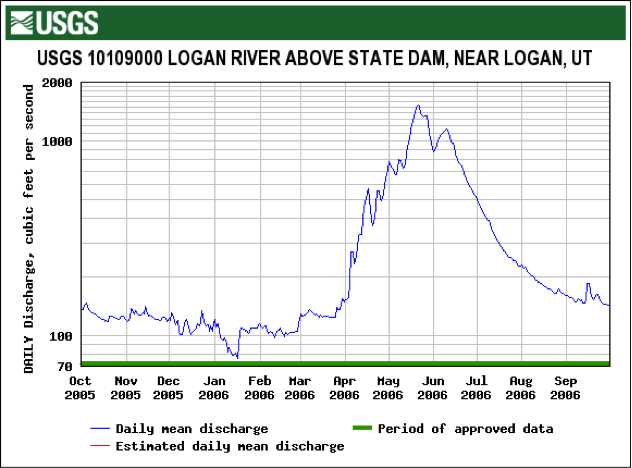
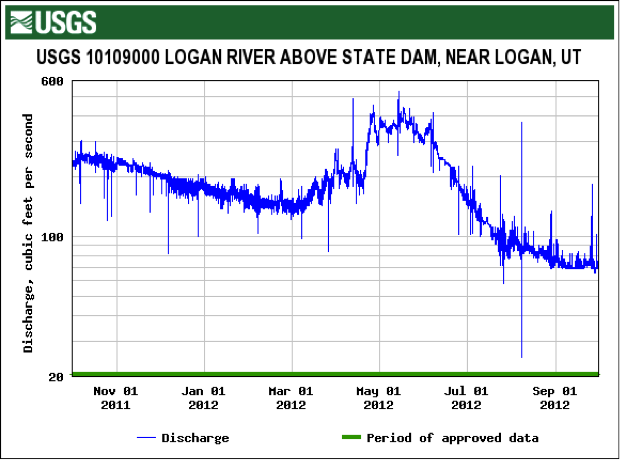
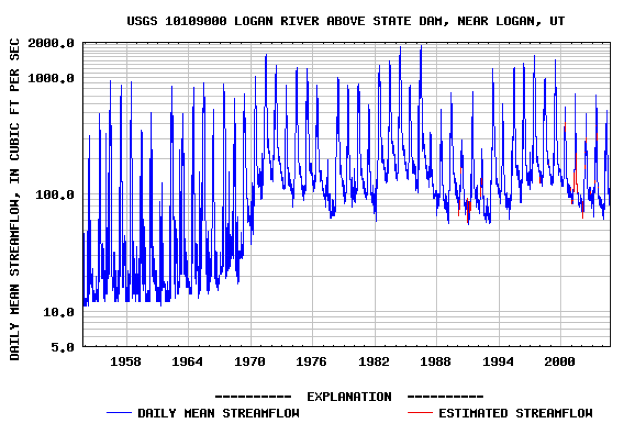
Examples of Logan River Hydrographs 2008-2009
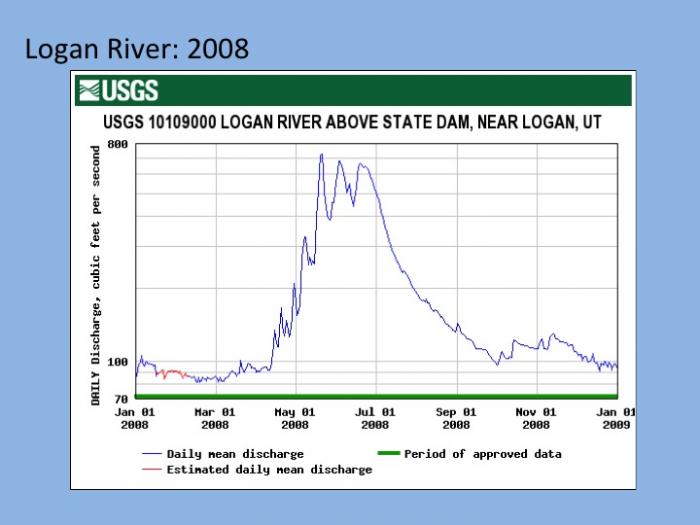
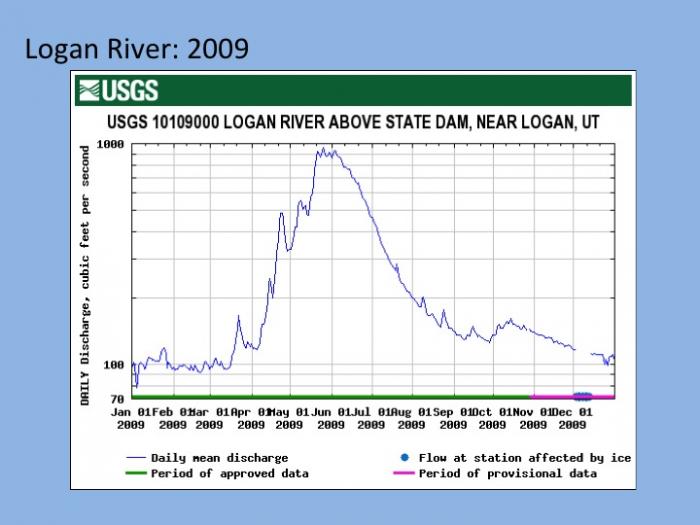
River Flow Regimes
River Flow Regimes
The temporal patterns of high and low flows are referred to collectively as a river’s flow regime. The flow regime plays a key role in regulating geomorphic processes that shape river channels and floodplains, ecological processes that govern the life history of aquatic organisms, and is a major determinant of the biodiversity found in river ecosystems. There are five components that characterize the flow regime:
- Magnitude: the total amount of flow at any given time
- Frequency: how often flow exceeds or is below a given magnitude
- Duration: how long flow exceeds or is below a given magnitude
- Predictability: regularity of occurrence of different flow events
- Rate of change or flashiness: how quickly flow changes from one magnitude to another
River in regions with similar climate, geology, and topography tend to have similar flow regimes. For example, rivers draining high mountains, such as the Logan River, tend to have relatively infrequent, high magnitude, long duration, and predictable flood events that have a slow rate of change (Figure 6 on the previous page). Rivers in many tropical climates have similar flow regime characteristics as mountain rivers, due to predictable rainy and dry seasons. In contrast, rivers in arid regions are often characterized by high magnitude, short duration floods of low predictability and high flashiness (e.g., Figure 11 on the next page).
Within regions of similar climate, local factors such as soil type, soil depth, vegetation cover, and watershed size influence the natural flow regime. For example, watersheds with deep, permeable soils will be able to absorb more precipitation than watersheds with thin, impermeable soils, and will thus tend to have less flashy floods of lower magnitude and longer duration. Large rivers tend to be less flashy than small streams, which respond more quickly to individual precipitation events. Thus, natural flow regimes can be somewhat variable between nearby watersheds. Also, although general patterns in flow regime can be determined from watershed characteristics, yearly variation in precipitation patterns means that many years of flow monitoring will be required to fully characterize the flow regime of individual rivers.
Temporary vs. Perennial Streams
Temporary vs. Perennial Streams
Most large rivers are perennial, meaning they maintain flow throughout the year. However, many headwater streams or streams in arid regions sometimes run dry. A stream is considered temporary if surface flow ceases during dry periods. Temporary streams are often classified further as intermittent and ephemeral. An intermittent stream becomes seasonally dry when the groundwater table drops below the elevation of the streambed during dry periods. A spatially intermittent stream may maintain flow over some sections or surface water in deep pools even during dry periods due to locally elevated water tables or perched aquifers. An ephemeral stream only flows in direct response to precipitation such as thunderstorms. Thus, the flow variability of an intermittent stream is much more predictable than in an ephemeral stream.
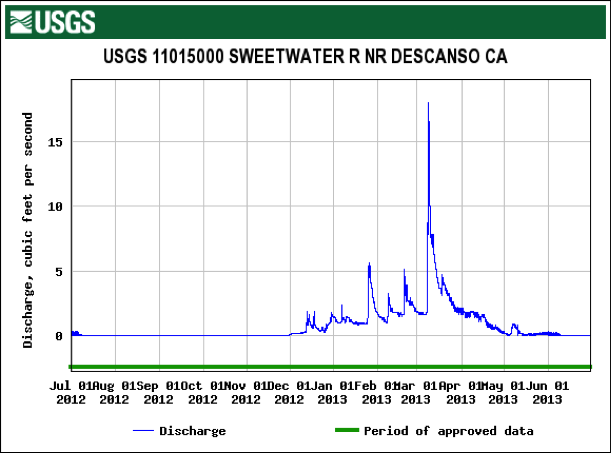
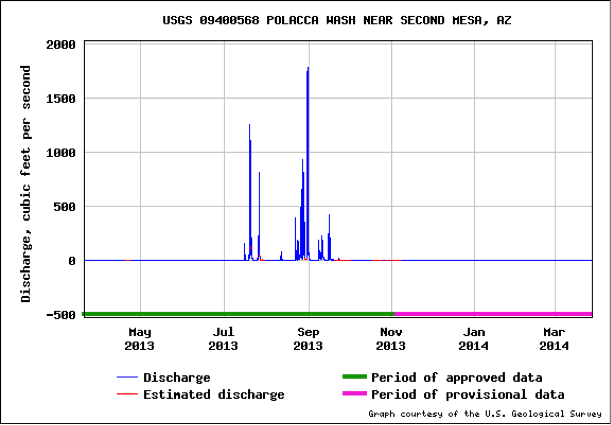
In many parts of the world, such as the desert southwest, temporary streams may comprise a majority of the river network, >80% in some areas. However, even in wet regions, temporary streams at the head of river networks can account for >50% of the total stream network. Thus, river networks can be considered dynamic systems, with total miles of surface flow expanding and contracting in response to precipitation events.
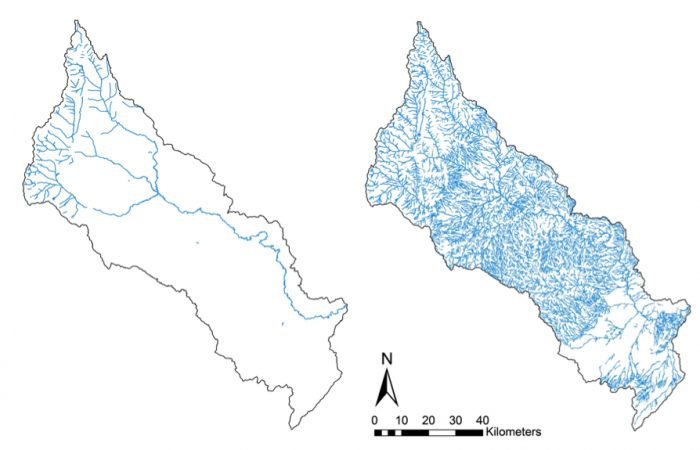
Why would we still call a channel that goes dry for much of the year a stream? In other words, how can we distinguish between a temporary stream and an upland terrestrial ecosystem? In short, a stream has characteristic hydrological, geomorphological, and ecological processes. However, as with many topics in environmental science, the distinction between stream channels and uplands and between perennial streams and temporary streams is often fuzzy and scale-dependent. Individual stream channels may hold water for decades and then become dry during exceptional droughts that occur infrequently (once every 50-100 years). Similarly, small gullies on hillsides may flow only a few days of the year and may transport sediment but not be resident to aquatic life. Are such systems part of the river network?
What is a Stream?
What is a Stream?
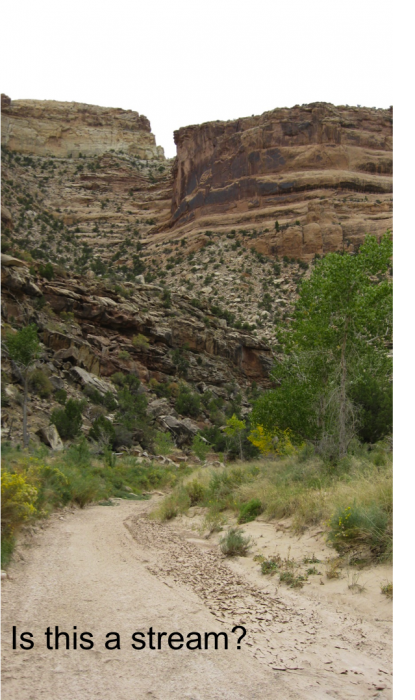
A channel is generally classified as a stream based on the occurrence of several processes including Hydrological Processes, Geomorphological Processes, and Ecological Processes.
Hydrological Process
Hydrological Process
Definition
A proper stream generally consists of concentrated, channelized flow, even if it only carries water for a few days of the year. In contrast, an upland system may have surface water flow, but the flow is more akin to sheet flow and typically not concentrated into channels.
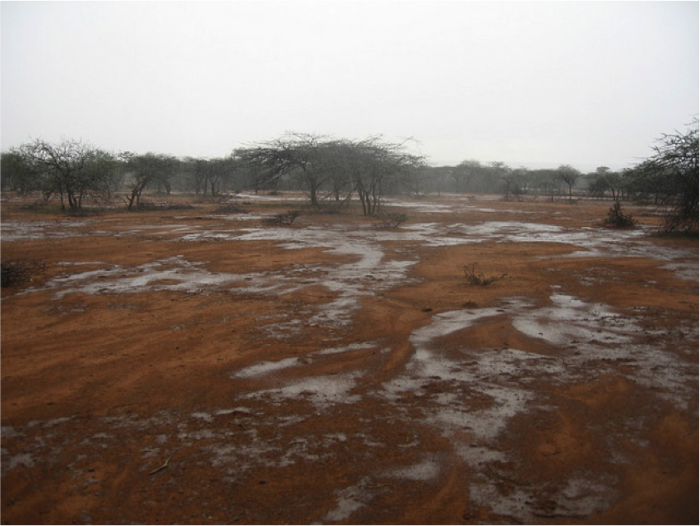
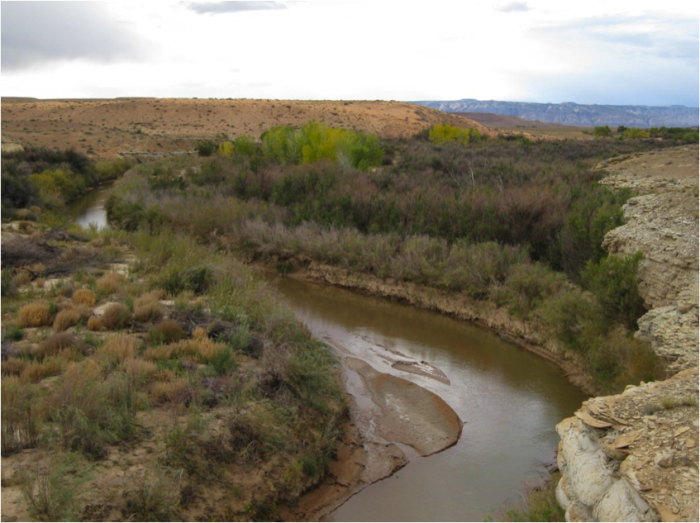
Geomorphological
Geomorphological
Definition
A stream channel is an area of rapid conveyance of sediment and dissolved constituents during periods of flow. However, not all sediment can be transported during all flows, and this provides a mechanism and particular pattern of sediment sorting that is a hallmark of stream channels not found in terrestrial systems.
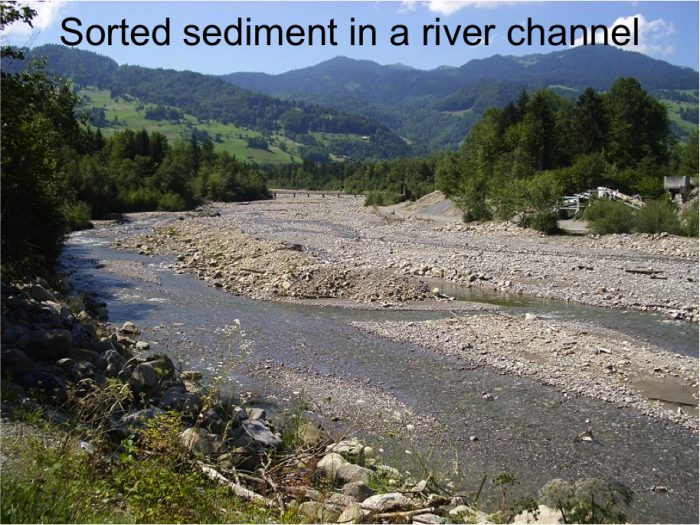
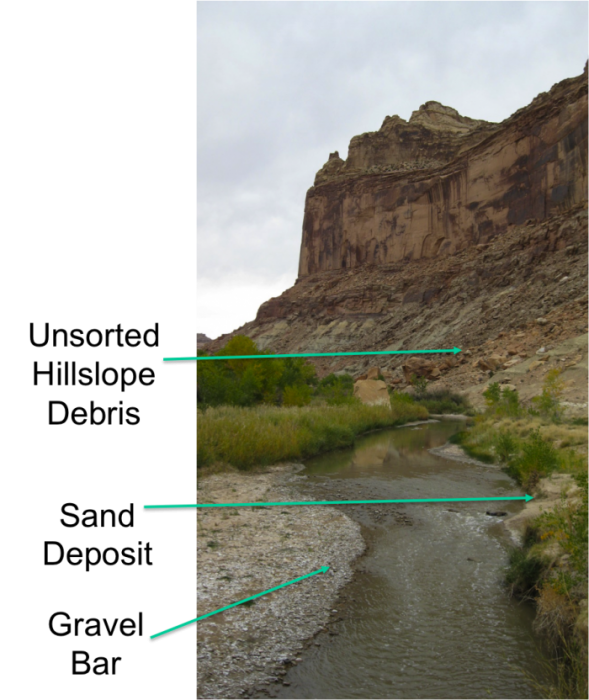
Ecological Processes
Ecological Processes
Definition
A stream channel supports populations of aquatic organisms such as fish and insects. In contrast, upland systems do not provide even temporary habitat for aquatic organisms. Even when stream channels go dry on the surface, fish and other organisms can survive in isolated pools of water or in isolated areas of flow such as springs and perched aquifers.
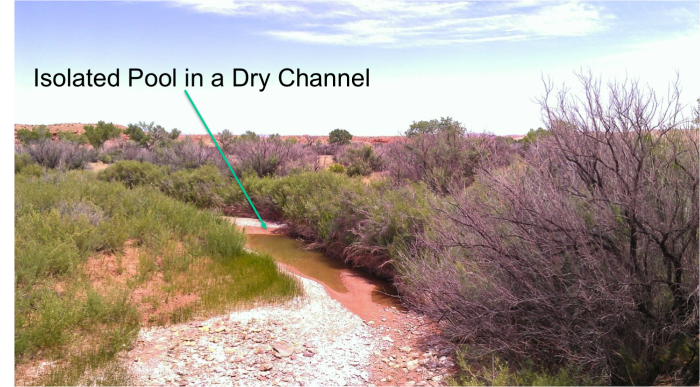
Many organisms can survive in the bed of a stream channel even if the surface is dry, due to hyporheic flow, which is water that flows in the sediments of a stream channel beneath the surface.
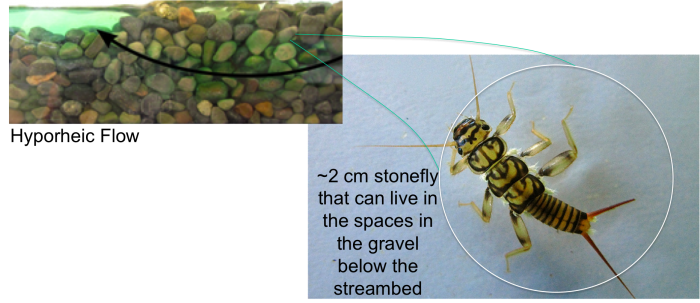
Even if aquatic organisms do not persist in stream channels year-round, temporary flooding can provide productive systems and isolation from predators, favorable for reproduction and development of young organisms, which can then migrate to perennial rivers as the stream dries.
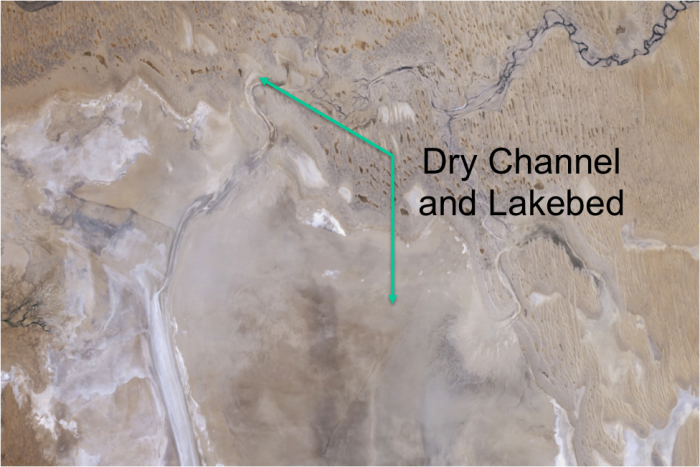
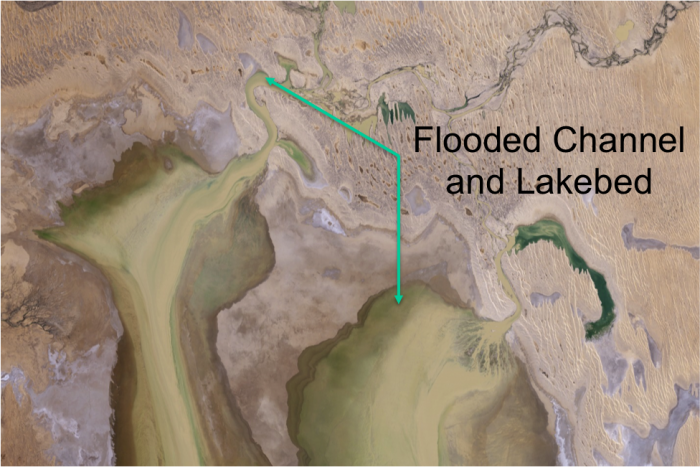
Flow Duration Curve
Flow Duration Curve
While it can be very informative to study hydrographs and the other flow metrics described above, often an important question often asked about rivers is ‘what percentage of time does flow exceed (or not exceed) a given value (e.g., 100 cfs)?’ It might be important to answer that question to determine the percentage of time when the flow is too low to support a particular fish species. Or it may be important to know what percentage of time the river exceeds a certain value known to cause flood damage. The proportion of time any given flow is exceeded can be determined by generating a flow duration curve. Figure 21 shows the flow duration curve for the hydrograph shown in Figure 21 (2006 water year) as well as the three subsequent years. You can immediately see that the mid and lower flows (exceeded about 40% (or 0.4) of the year) are relatively similar in each year, but the larger flows exhibit quite a bit of variability. In 2007 the highest flow of the year was only a bit over 400 cfs, while it was over 1500 cfs in 2006. The flow that was exceeded 20% of the time (0.2 on the x-axis) was approximately 450 cfs in 2005, but only 200 cfs in 2007.
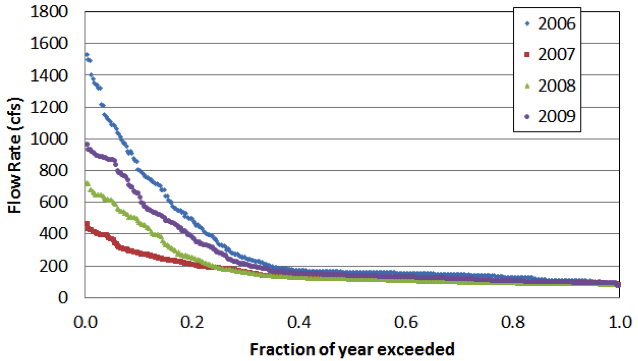
Note that this plot provides detailed information on different parts of the flow duration curve depending on whether you use linear or log scales for the x or y axes (see example from the Stilliguamish River, Washington below in Figures 22-25).
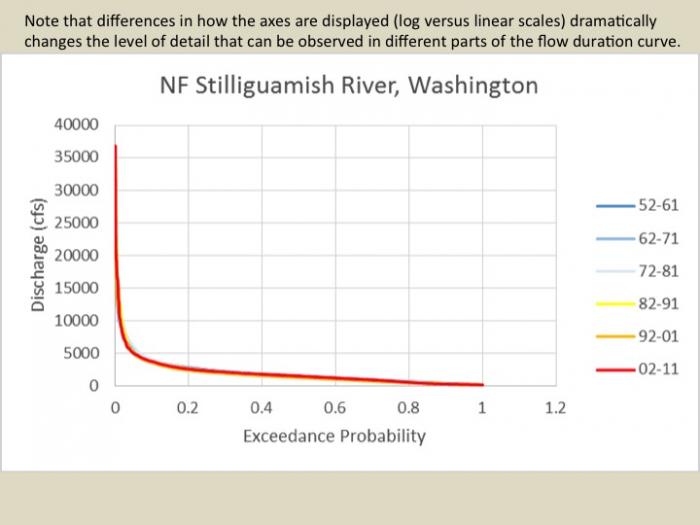
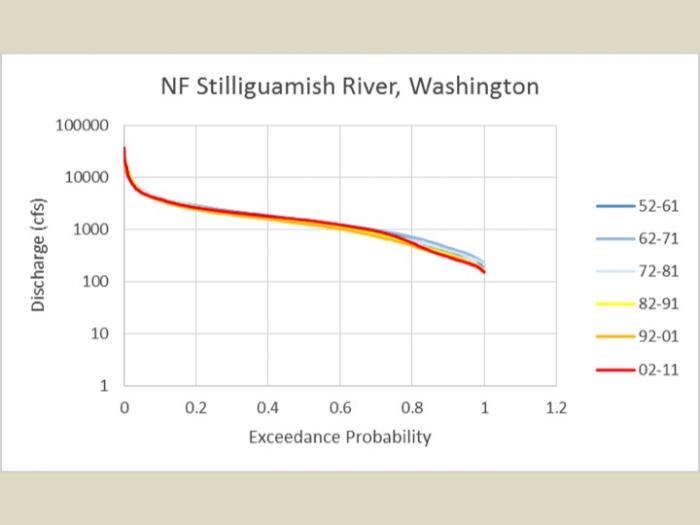
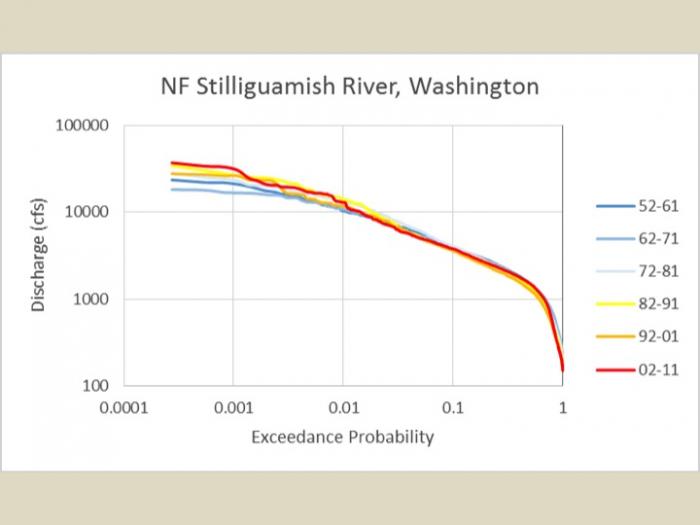
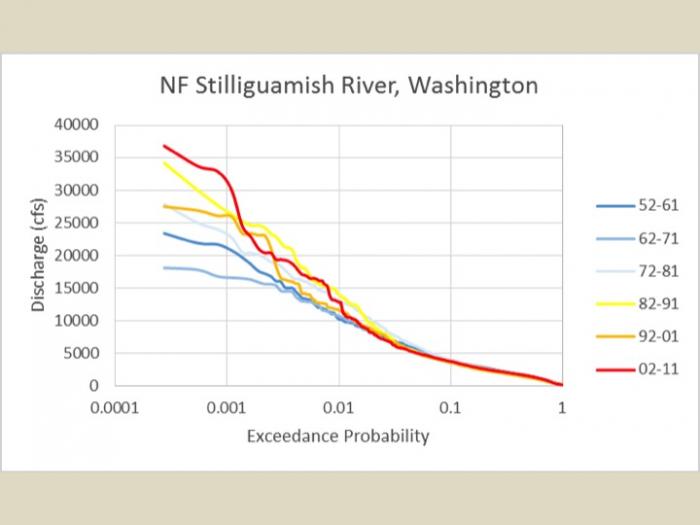
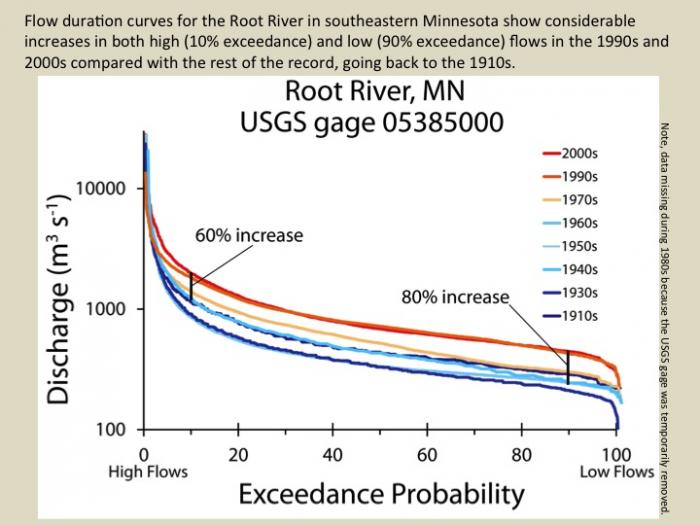
Flow duration curves can be made for a given river over two different time periods to illustrate if/how the range of flows has changed over time. For example, Figure 27 shows flow duration curves for the Le Sueur River in southern Minnesota for two different time periods (1950-1970 in blue, 1990-2010 in red). Note that in these plots the fraction of year exceeded is labeled as ‘exceedance probability’. These two terms are interchangeable, both being computed as:
Where Ep is the exceedance probability or the fraction of the year that a given flow is exceeded, R is the rank, and n is the total number of values (365 if you are using daily-averaged flow values for a non-leap year). High flows (toward the left side of each plot) and low flows (toward the right side of each plot) appear not to have changed in the Elk and Whetstone rivers. In the Blue Earth River, low flows (exceeded more than 85% of the time) have not changed much, but mid-range and high flows all appear to have increased. In the Le Sueur River, the full range of flows appears to have increased. Note that the y-axis is plotted on a log scale, so even the modest difference between the two curves represents a significant increase in high flows (e.g., those that are only exceeded 5-10% of the time). The Root River, in southeastern Minnesota, has experienced significant increases in high and low flows within the past two decades, see example above.
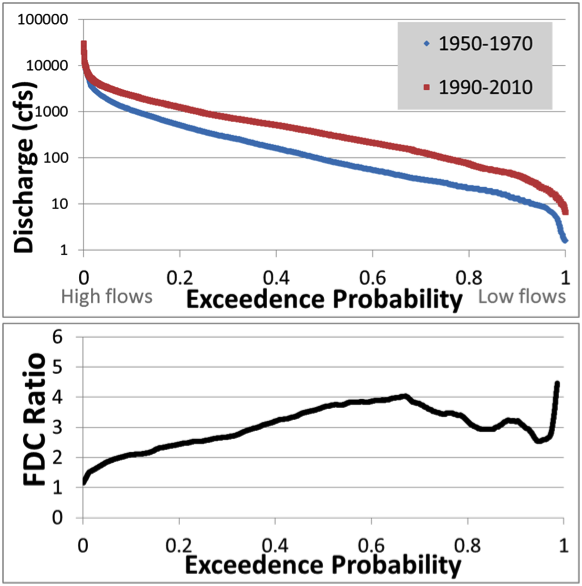
Learning Checkpoint
1. What percentage of an average river network is made up of temporary streams:
(a) 0%
(b) 100%
(c) 10%
(d) 50%
ANSWER: d. 50%
2. What percentage of an average river network is made up of temporary streams:
(a) 0%
(b) 100%
(c) 10%
(d) 50%
ANSWER: b. 0.25
3. Given your answer to the previous question, how many days of the year was flow of the Logan River above 400 cfs in 2006?
(a) 37
(b) 91
(c) 256
(d) 329
ANSWER: b. 91
4. In Figure 21, what fraction of the year did flow of the Logan River exceed 400 cfs in 2007? Click to see Figure 21. [9]
(a) 0.01
(b) 0.1
(c) 0.9
(d) 0.99
ANSWER: a. 0.01
5. Given your answer to the previous question, how many days of the year was flow of the Logan River above 400 cfs in 2007?
(a) 4
(b) 37
(c) 329
(d) 361
ANSWER: a. 4
6. According to Figure 27, how much did the median (i.e., 50% exceedance) flow change in the Le Sueur River between the two time periods represented. Click to see Figure 27 [10]
(a) by a factor of 0.5
(b) by a factor of 2
(c) by a factor of 3.5
(d) by a factor of 10
ANSWER: c. by a factor of 3.5
Rivers Come in Many Shapes and Sizes
Rivers Come in Many Shapes and Sizes
If you take a tour through any given landscape, via car or virtually through Google Earth, you are very likely to see a variety of different river types. At first glance, they may not appear so different (just a bunch of long tracks of flowing water), but if you look closer you will see that each river is, in a sense, unique, with some having a single channel while others may flow in multiple, interweaving channels. You’ll see that each river has a different pattern of sinuosity (i.e., the frequency and amplitude of ‘wiggles’), and each has their own variations of width and depth, differences in the material composing the channel bed and banks, and differences in the vegetation lining the channel. Figure 28 shows a few examples of different channel types.
The shape and size of a river depend on a multitude of factors that vary over time and space. A comprehensive discussion of these factors and the interactions between them is beyond the scope of this course, but it is useful to discuss how rivers are self-formed dynamic systems. To a large extent, water ‘designs’ the channels through which it flows and, in the process, acts as the primary factor sculpting the features that comprise a landscape. Understanding how river channels form and change over time is a very active research topic in the fields of hydrology and geomorphology. Recent breakthroughs in numerical modeling (including computational fluid dynamics models that can resolve the complex structures of turbulence and fluid flow as well as morphodynamic models that can simulate interactions between flow, sediment and vegetation) and increasing availability of high resolution topography data (aerial light detection and ranging (lidar) data, terrestrial lidar, and high resolution surveying and 3-D photography techniques) have greatly enhanced our ability to study the form and dynamics of river channels in great detail, over vast areas. In the broadest sense, river channel form is controlled by a) the amount of water (especially the size of ‘common’ floods that occur once every few years, as discussed below), b) the underlying geology (the type of rock and variability within the rock structure), c) the amount and type of sediment supplied to the channel (coarse material such as sand and gravel as well as fine material such as silt and clay), and d) the type of riparian vegetation along the channel.
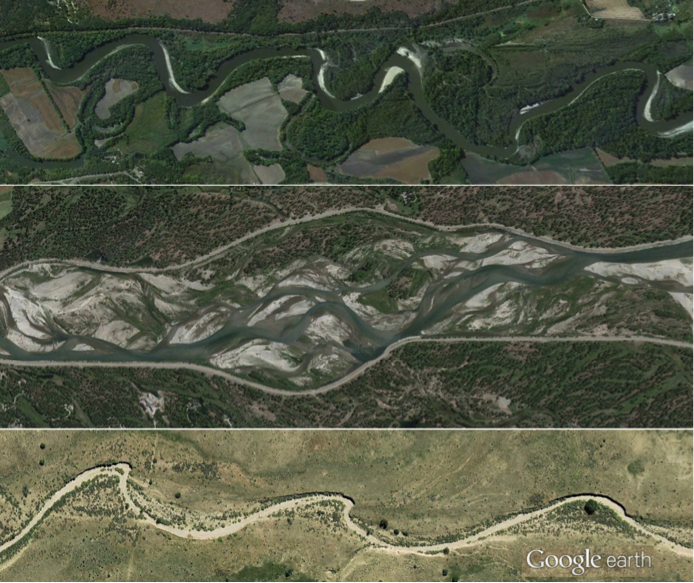
Video: Why do Rivers Curve? (2:47)
Compared to the white water streams that tumble down mountainsides, the meandering rivers of the plains may seem tame and lazy. But mountain streams are corralled by the steep-walled valleys they carve. Their courses are literally set in stone. Out on the open plains, those stony walls give way to soft soil, allowing rivers to shift their banks and set their own ever-changing courses to the sea, courses that almost never run straight, at least not for long. Because all it takes to turn a straight stretch of river into a bendy one is a little disturbance and a lot of time. And in nature, there's plenty of both.
Say for example then a muskrat burrows herself a den in one bank of a stream. Her tunnels make for a cozy home but they also weaken the bank, which eventually begins to crumble and slump into the stream. Water rushes into the newly formed hollow, sweeping away loose dirt and making the hollow even hollower, which lets the water rush a little faster and sweep away a little more dirt, and so on, and so on. As more of the streams flow is diverted into the deepening hole on one bank, and away from the other side of the channel, the flow there weakens and slows. And since slow-moving water can't carry the sand-sized particles that fast-moving water can, the dirt drops to the bottom and builds up to make the water there even shallower and slower, and then keeps accumulating until it becomes new land on the inside bank. Meanwhile, the fast-moving water near the outside bank sweeps out of the curve with enough momentum to carry it across the channel and slam it into the other side, where it starts to carve another curve, and then another, and then another, and then another. The wider the stream the longer it takes the slingshotting current to reach the other side and the greater the downstream distance to the next curve. In fact, measurements of meandering streams all over the world reveal a strikingly regular pattern. The length of one S-shaped meander tends to be about six times the width of the channel. So little tiny meandering streams tend to look just like miniature versions of their bigger relatives.
As long as nothing gets in the way of our rivers meandering its curves will continue to grow curvier and curvier until they loop around and bumble into themselves. When that happens, the rivers channel follows the straighter path downhill, leaving behind a crescent-shaped remnant called an oxbow lake, or a billabong, or un lago en herradura, or bras mort. We have lots of names for these lakes, since they can occur pretty much anywhere liquid flows or used to. Which brings up an interesting question, what do the Martians call them?
This Minute Earth video is brought to you by you if you want to because we've started a new crowdfunding campaign on the website patreon.com to help remove banner ads and support Minute Earth going forward. And we'd be honored if you considered helping us out by going to patreon.com/minuteearth.
Number of Channels and Sinuosity
Number of Channels and Sinuosity
While the variety of river types is best thought of as a continuum, rather than a bunch of discrete boxes, it is often useful in science to create a taxonomy to classify items for the purpose of description and communication. Figure 30 illustrates some of the most common characteristics by which rivers can be classified (see Brierley and Fryirs, 2005 or Montgomery and Buffington, 1997 for detailed discussions of channel classification). At the most basic level it is useful to classify rivers according to the number of channels they contain, from single-threaded to braided (with more than three interweaving channels that are frequently reorganized) to anastomosing (which typically have somewhat stable, vegetated islands between channel threads), to discontinuous streams that have un-channelized reaches). Wandering rivers are those that alternate between single-threaded and slightly braided reaches. Another useful metric, particularly for single-threaded channels is sinuosity, which is calculated as the length along the river divided by the straight-line distance along the river valley. Rivers can have sinuosity ranging from one up to three (i.e., the river length is three times longer than the valley). Bends in rivers are called meanders. Meanders can exhibit a variety of forms with some in nature being remarkably regular (see the Fall River in Rocky Mountain National Park in Google Earth) and others being irregular or tortuous (frequently folding back on itself).
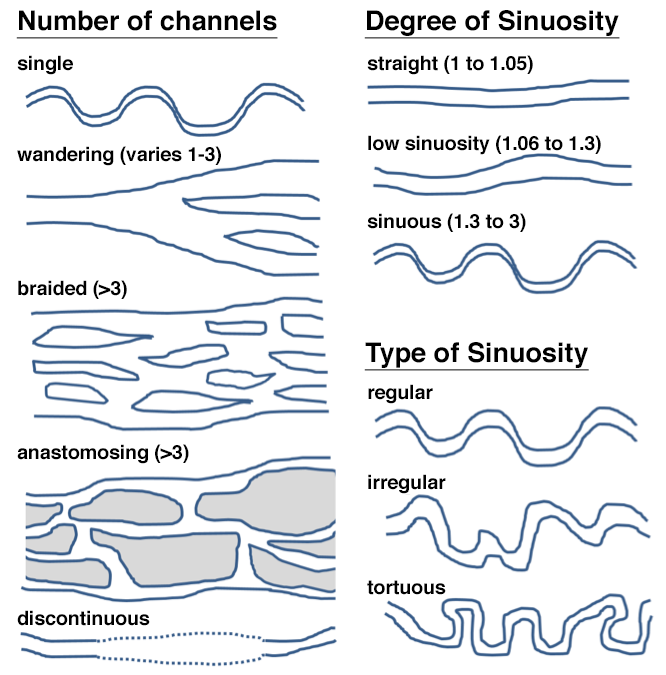
Stream Power
Stream Power
While there is currently no generalizable equation or universal law describing what a river channel should look like, a vast array of field data and modeling has culminated in some useful generalities. Stream power, defined as the product of water density (about 1000 kg/m3), gravitational acceleration (9.8 m/s2), discharge (m3/s), and channel slope (m/m), is one useful predictor of channel form and dynamics because it quantifies the amount of ‘work’ that can be done by a stream, such as moving sediment on the bed or in the banks of the river (i.e., erosion or sediment transport). For example, braided rivers tend to have more stream power than single threaded meandering rivers because their channel slope tends to be higher as they often flow closer to mountains (on steeper topography).
Sizes of a River Channel
Sizes of a River Channel
River channels are self-formed. Typically they are only partially filled, the water level is well below the tops of the banks. Sometimes, they are overfilled and water spills out onto the floodplain. These simple observations lead to the fundamental question, ‘what sets the size of a river channel?’ Figure 30 conceptually illustrates the rationale supporting the empirical finding that an ‘effective discharge’, which occurs frequently enough and has sufficient power to do work, ultimately dictates the size of the channel. Specifically, the brown curve illustrates that the frequency distribution of discharge in a river is typically right (positively) skewed, meaning that relatively low discharges are quite common and increasingly higher discharges occur with diminishing frequency. There is some discharge below which sediment does not move on the river bed because there is insufficient power to move the sand or gravel, as indicated by the light orange line starting at some moderate discharge and increasing in a non-linear manner at progressively higher discharge. Multiplying the brown and light orange lines together yields the darker orange line, which has a peak at some relatively high discharge value. This ‘effective discharge’ tends to occur when the river is approximately full up to its naturally formed banks. Even very large floods, which greatly exceed the capacity of the channel, do not necessarily add a proportionate amount of power to the channel because much of the additional water (and therefore the energy to transport sediment) is dissipated on the adjacent floodplain.
As changes in climate alter precipitation patterns or as land and water management modulates the proportion of precipitation that becomes streamflow, the frequency curve in Figure 30 may change and thus change the effective discharge as well as the geometry of the channel. In this way, rivers are dynamic features in the landscape, growing bigger when more water is flowing through the landscape and smaller during extended drier periods.

Module 4: Flood and Drought
Module 4: Flood and Drought
In this module, we will discuss the causes, implications and ways to characterize and predict what are often referred to as ‘extreme events’ in hydrology: floods and droughts. Such events play important roles in natural ecosystems and are a major concern for society, with significant impacts on the economy, ecosystem health and services, as well as human health. To gain a broader perspective, we will discuss floods and droughts within the more general topic of hydrologic variability. We will look beyond simple metrics like average annual rainfall to instead think about the full distribution of ‘events’ that characterize the hydrology of an area. The goals of this module are to expose you to the basic concepts of floods and droughts, develop an understanding of how we characterize ‘normal’ and ‘extreme’ hydrologic events, and gain some perspective on the consequences of floods and droughts for society and ecosystems. As part of this, you will become familiar with terms such as stationary versus non-stationary conditions, return period (a.k.a., recurrence interval), exceedance probability, and probability density function.
Goals and Objectives
Goals and Objectives
Goals
- Describe the two-way relationship between water resources and human society
- Explain the distribution and dynamics of water at the surface and in the subsurface of the Earth
- Synthesize data and information from multiple reliable sources
- Communicate scientific information in terms that can be understood by the general public
- Interpret graphical representations of scientific data
Learning Objectives
In completing this module, you will:
- Distinguish between a forecast and a prediction and provide examples of each
- Interpret flood frequency patterns from a histogram
- Interpret flood risk at various locations using flood risk maps
- Explain the hazards of living in a floodplain and the utility of floodways
- Assess flood risk and flood history in your own hometown
- Articulate the concept of a 2, 10 and 100-year flood
Making Sense of Hydrologic Variability
Making Sense of Hydrologic Variability
Video: Advanced Hydrologic Prediction Service (1:37)
This short video introduces the NWS Advanced Hydrologic Prediction Service that provides alerts for droughts and floods in the United States.
Montra Lockwood - Forecaster, National Weather Service, Lake Charles, LA: Floods are one of nature's deadliest natural disasters. Timely and accurate forecasting of floods is vital to the protection of life and property. The Advanced Hydrologic Prediction Service, also known as AHPS, was created for this purpose.
AHPS is a national weather service program designed to provide improved river and flood forecasting. This service provides a suite of text and graphical products that are available online to assist the public, community officials, and emergency managers, in making better life and cost-saving decisions about evacuations and protection of property before flooding occurs. AHPS provides detailed and accurate answers to such questions as, How high will the river rise? When will the river crest? Where will it flood? How long will the flood last? How certain is the forecast? and What are the impacts of the flood? Additional enhancements to the AHPS pages include multi-sensor precipitation information and flood inundation maps for specific locations. To view AHPS information, please visit the AHPS website at water.weather.gov/AHPS. And for more information on flooding and what you can do to protect yourself and your property, visit the National Weather Service's Flood Safety page at nws.noaa.gov/floodsafety.
Precipitation and streamflow are both incredibly variable aspects of the environment, often changing dramatically over short time scales and small spatial scales. If you look up the precipitation record for a location of interest (data freely available from the National Weather Service, Natural Resource Conservation Service, and many other outlets), you would see that events seem to happen ‘randomly’, often without an obvious pattern in the frequency, magnitude or duration. Take, for example, the precipitation record for Kingston, New York from October 1, 2010, through September 30, 2013 (Figure 1). There is an immense amount of variability from day to day. So what can we really say about precipitation from these data? July and August of 2011 appear to be a very wet time period, with many events clustered and one event reaching over 12 cm (nearly 5 inches)! Do you think that caused a flood? Precipitation was very sparse from mid-December 2011 to mid-February 2012. Do you think that was a drought?
It is essentially impossible to answer the questions posed above about July 2011 being a flood or winter 2011-2012 being a drought from the precipitation data alone because precipitation is not the only factor that causes floods and droughts. Processes of water use and transport occurring in a landscape also matter. For example, an increased impervious surface associated with urbanization is known to dramatically increase runoff, resulting in much higher peak discharge (bigger floods) for any given amount of rainfall. In contrast, a large rain event occurring on dry soil will have a relatively small effect on streamflow compared with the same rainfall event occurring on very wet or saturated soils, because more of the rain would be absorbed by the dry soil. Landscape processes also influence droughts. While a prolonged lack of precipitation can initiate a drought, the severity of the drought is strongly influenced by the water demand, by vegetation and/or humans, throughout the landscape. Landscape processes can amplify or dampen precipitation variability. This greatly complicates the job of forecasting floods and droughts. Hydrologists must account for numerous factors that vary in time and/or space.
Though it is difficult, hydrologists can make remarkably accurate and timely predictions of floods and droughts. For example, the National Weather Service (NWS) uses large amounts of real-time data from precipitation gauges, radar systems, river discharge gages, and satellite imagery. The NWS maintains a network of 13 river forecast centers and 50 hydrologic service areas that provide real-time flood warnings throughout the US, which can greatly reduce loss of life and property damages.
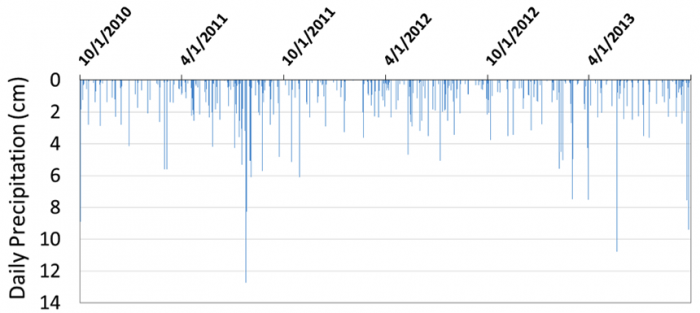
| Date | Daily Precipitation (cm) |
|---|---|
| October 1, 2010 | 3 |
| April 1, 2011 | 2.25 |
| October 1, 2011 | 5 |
| April 1, 2012 | 1.5 |
| October 1, 2012 | 3.75 |
| April 1, 2013 | 7.5 |
Forecasting and Predictions
Forecasting and Predictions
Meteorologists have made excellent progress in the past few decades to improve our abilities to forecast when rain events might occur over the next week or so, which facilitates the short-term forecasting of floods and droughts discussed in the paragraph above. However, complex atmospheric dynamics prevent forecasts beyond more than a few weeks in advance. Nevertheless, we must have some basis for making decisions about development, infrastructure and agriculture (e.g., How big should we build a culvert under a road? What size retention basin is needed next to a new housing development? Which agricultural fields will require artificial drainage and which will require irrigation?).
For these longer-term predictions we can use statistics to determine how likely it is that a given location will experience, for example, more than 10 cm of rain in a day, or less than 5 cm of rain during a given month. Many million- and billion-dollar decisions about development and infrastructure are based on such predictions.
To make these predictions, hydrologists synthesize historical data and use a statistics-based approach to determine the likelihood that a given event might occur. While Figure 1 highlights the ‘messiness’ of precipitation events over time, reorganization of the data provides useful information. Figure 2 shows a histogram of the precipitation data presented in Figure 1. A histogram is a plot showing the number of events that fall within chosen data groups or “bins” (shown on the x axis). From these data you can quickly determine that Kingston, NY experiences no rain about 2 out of every 3 days (731 out of the total 1096 days in this record). Only 10 days in the record had rainfall that exceeded 6 cm, so from these data alone you would expect such large rainfall events to happen 10 days out of 1096, or about 1% of the time. On 210 days during this time period the amount of rainfall was between the minimum measurable (typically 0.025 cm or 0.01 inch) and 1 cm (0.4 inches).
Hydrologists tend to use the term ‘forecast’ when referring to a future projection for which we have a lot of information (and therefore relatively high certainty of when an event might occur and what magnitude it might be). In contrast, hydrologists use the term ‘prediction’ for future projections for which less information is available, and therefore uncertainty is greater.
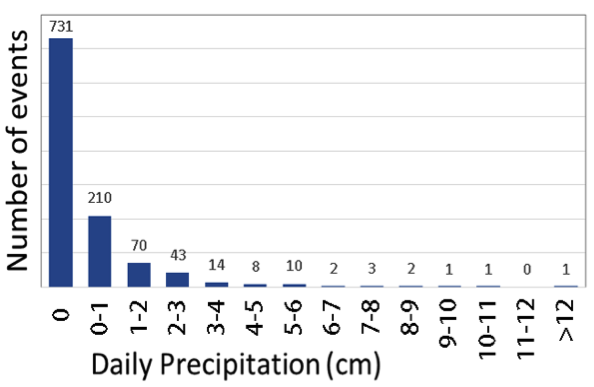
| Daily Precipitation (cm) | Number of events |
|---|---|
| 0 | 731 |
| 0-1 | 210 |
| 1-2 | 70 |
| 2-3 | 43 |
| 3-4 | 14 |
| 4-5 | 8 |
| 5-6 | 10 |
| 6-7 | 2 |
| 7-8 | 3 |
| 8-9 | 2 |
| 9-10 | 1 |
| 10-11 | 1 |
| 11-12 | 0 |
| >12 | 1 |
Learning Checkpoint
The National Weather Service maintains a Precipitation Frequency Data Server (PFDS) website [11] that allows you to look up the frequency of precipitation events of different duration and magnitude for most locations in the US. The PFDS website will open in a new window. Peruse the website and answer the following questions:
Zoom in on Logan, Utah and place the red crosshair directly over Logan. Below the map a table will appear showing the amount of precipitation associated with a range of time periods (durations shown in left column, ranging from 5 minutes to 60 days) and the average frequency with which such an event might happen (the recurrence interval, listed in years).
1. What is the amount of precipitation that you would expect to get in Logan, Utah on an annual basis, within a 24 hour time period?
(a) 0.1 inches
(b) 0.7 inches
(c) 1.2 inches
(d) 2.4 inches
ANSWER: (c) 1.2 inches
2. What is the amount of precipitation that you would expect to get in Logan, Utah on an annual basis, within a 60 minute time period with a frequency of once every 10 years?
(a) 0.1 inches
(b) 0.7 inches
(c) 1.2 inches
(d) 2.4 inches
ANSWER: (b) 0.7 inches
Zoom in on Chickamauga, Georgia and answer the following questions.
(a) 0.1 inches
(b) 1.3 inches
(c) 2.1 inches
(d) 3.3 inches
ANSWER: (d) 3.3 inches
4. What is the amount of precipitation that you would expect to get in Chickamauga on an annual basis, within a 60 minute time period with a frequency of once every 10 years?
(a) 0.1 inches
(b) 1.3 inches
(c) 2.1 inches
(d) 3.3 inches
ANSWER: (c) 2.1 inches
Predicting Frequency and Magnitude
Predicting Frequency and Magnitude
We can do similar calculations to estimate the frequency and magnitude of floods. For example, Figure 3 shows the annual maximum series of flows for the Lehigh River at Bethlehem, PA from 1910 to 2013. The annual maximum series is simply the highest flow value recorded for each year (typically for the water year, October 1 – September 30 as discussed in module 3). The largest flow on record (92,000 cfs) occurred in 1942 (on May 23, to be exact). Note that these are daily flow values which average flow over the course of the entire day, so the actual peak that occurred on May 23 was probably slightly higher. Interestingly, the year that had the smallest peak discharge on record was April 6, 1941 (only 8210 cfs, less than 10% of the whopper flood that came through the following year). But note that we are still talking about the highest flow for that particular year, which is still considerably higher than the average annual flow which is about 1,300 cfs. How can we use this information to predict what might happen in the future to support decisions about development, flood risk, or factors that may influence biota in the river or floodplain (e.g., factors limiting the return of certain fish)?
Similar to the precipitation example above, it helps to reorganize the data. The histogram shown in Figure 4 illustrates the frequency of events in 19 different “bins”. For example, the Lehigh River at Bethlehem, PA has never experienced an annual peak flow less than 5,000 cfs, so there is no orange bar in that bin. But it has experienced 4 peak flows that fall between 5,000 and 10,000 cfs. It has experienced a total of 55 peak flows that fall within the range of 10,000 to 25,000 cfs. These are the most common peak flows for the Lehigh River. And you can see the two outliers at the high end (92,000 cfs in 1942 and 91,300 cfs in 1955).
Typically, hydrologists will approximate the distribution of events that you see in Figure 4 as a probability density function, represented by the smooth, dashed-grey curve superimposed on the plot. This allows them to integrate under the curve above a value of interest to determine the probability that a flood of that magnitude (or larger) will occur. For example, integrating to find the area under the grey dashed curve above 60,000 cfs in Figure 4 would tell you the probability in any given year (in the future) that a flood of that magnitude (or larger) will occur. From that information, you can build your bridge to the appropriate size, or set your flood insurance rates accordingly, etc. Calculating probabilities associated with floods of a given magnitude is discussed in greater detail in the exercise associated with this module.
The same general principles apply to studying droughts. However, as we discuss below, droughts are more difficult to define and quantify because they build up over time and vary immensely over any given area. Nevertheless, similar plots of drought frequency, severity and duration can be developed for droughts, similar to Figure 4, to make sense of all the messy variability we observe in water deficiencies. With this brief introduction hopefully you can appreciate the great challenges in predicting the occurrence and severity of floods and droughts, and you can begin to see the implications for socio-economic systems and ecosystems.
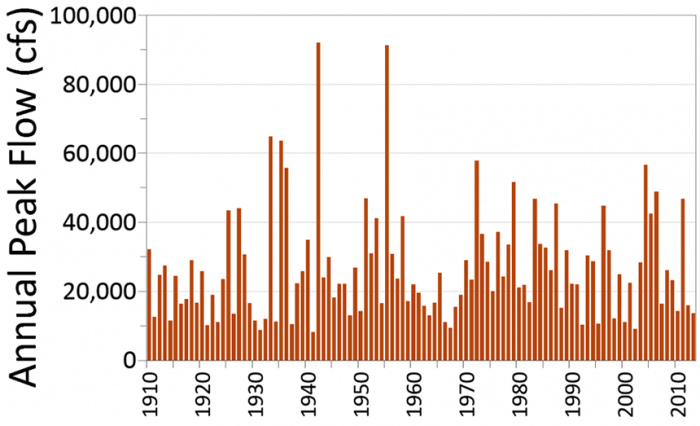
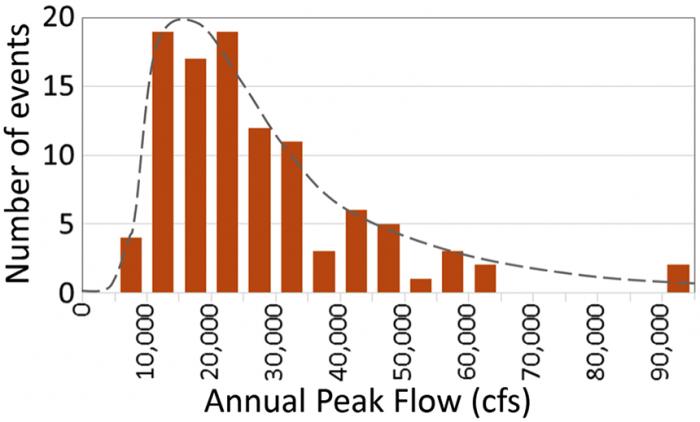
Normal Versus Extreme Hydrologic Events
Normal Versus Extreme Hydrologic Events
The immense variability observed in precipitation and streamflow leads one to wonder what constitutes an ‘extreme’ event. For example, most rivers tend to flood (i.e., water completely fills the channel and spills out onto adjacent floodplain) every one to five years. River discharge during such events is often on the order of 10 times the mean annual flow and often 100 to 1000 times greater than the lowest flows. In that context, perhaps they are extreme. However, considering them within the context of all the floods that occur over a century, we refer to floods that occur every one to five years as ‘common floods’ (e.g., all the events below ~ 25,000 cfs for the Lehigh River in Figure 4 shown earlier). So, labeling an event as ‘extreme’ requires some timescale context. Similarly, what we consider ‘extreme’ varies from place to place. For example, a rainfall event that delivers 5 cm of precipitation is quite rare in Utah but is nearly a daily occurrence in parts of Hawaii.
While there is no formal, universal definition for what hydrologists consider to be ‘extreme’ events, there are numerous ways we can assess precipitation and streamflow events within the appropriate context (timescale and location) to determine how they compare with ‘normal’ conditions.
Notice that the distribution of flood events in Figure 4 (on a previous page) has a strong right (also called positive) skew, meaning a long tail to the right of the graph. This positive skew is common in flood frequency data. It is tempting to label the two events that exceed 90,000 cfs as extreme events, but for many rivers there is no clear cut-off. Instead, hydrologists commonly determine the rarity of an event by calculating the frequency with which the event has occurred in the past. They use that frequency as an estimate of the probability that it will occur in the future, as discussed in the example of the Lehigh River. This is useful way to make predictions, but note that climate change prevents us from using the past to predict the future. If the entire event distribution shifts due to climate change, the event probabilities also change. We will address this issue towards the end of the module.
In any case, terms like ‘extreme’ may be useful for news headlines and catchy titles for scientific presentations, but nature doesn’t easily fit into boxes like ‘extreme’ and ‘normal’. Instead, hydrologists tend to use more well-defined terminology to characterize hydrologic events according to their frequency, duration, and magnitude as well as the spatial extent. Events that occur infrequently (i.e., events of low probability) are the ones to watch out for!
Floods
Floods
Video: Floods 101 | National Geographic (3:27)
This brief video from National Geographic describes the basics of flooding.
Narrator: Over the past hundred years, no other natural disaster in the US has caused more death and destruction than floods. They can happen any place, any day, any time. And they will likely only get worse. As people cluster around coastal regions and flood plains, our growing population will confront the awesome power of water. For thousands of years, farmers have depended on seasonal floods. The waters irrigated their crops and fertilized their lands. Today, excess water is channeled into reservoirs and power hydroelectric dams. But when water levels rise suddenly, far more than the ground can absorb, a flood occurs. Flash floods are a perfect example. Sudden storms unleash a torrential downpour. The runoff moves with surprising force. At a depth of two feet, the water can push aside a car. In fact, half of all deaths from flash floods involve vehicles. But floods occur in many other ways. Heavy rains and thawing snow fall can overwhelm rivers. Storm surge is caused by hurricanes and tsunamis inundate the coastline. Landslides and mudflows can displace large volumes of water. Dams break, levees fail.
In the Great Mississippi Flood of 1993, several of these factors came into play. Over 10,000 square miles of the midwestern United States were overwhelmed with rain. In a cruel twist, the earthen dams known as levees. along the Upper Mississippi River, forced the water to flow downstream faster and stronger. Communities further downriver were hit with the full brunt of the Mississippi. Two-thirds of all the levees were breached. Though towns rallied to protect their lives and livelihoods, the damage was still immense. Over ten billion dollars in damages, 56,000 homes flooded or destroyed, and some 50 people were killed.
At the start of this century, another powerful flood wreaked havoc, this one coming from the sea. The storm surges of Hurricane Katrina submerged 80% of the city of New Orleans. Over 1,800 people died in the floods. The damage has been estimated at over eighty billion dollars. In some ways, the New Orleans disaster was unique. Much of the city lies below sea level and despite years of warning, the city was woefully unprepared to handle a breach of the levees which kept it dry. But we are still vulnerable. Sea levels may rise, coastlines could erode, rain patterns might change, snowpacks could melt, and then the waters would rush in.
Floods are rare events in which a body of water temporarily covers land that is normally dry. Following from module 3, we will mostly restrict our discussion to floods in rivers, but it is important to note that floods also occur around lakes, wetlands, and the sea coast. Indeed, coastal storm surge is among the most dangerous natural disasters expected to result from global warming and sea level rise. River floods occur naturally and in many cases are beneficial for ecosystem functioning because they allow the river to exchange water, sediment, and nutrients with the floodplain and cause scour and deposition that provides habitat for a wide range of aquatic and riparian organisms. However, floods often threaten human infrastructure and livelihoods and can cause severe economic damages.
River floods are typically caused by excessive rainfall and/or sudden melting of snow and ice. Most rivers overflow their banks with small floods about once every two years. Such are the floods that tend to determine the width and depth of a river channel, as discussed in module 3. Moderate floods might occur once every five to ten years and very large floods might only occur once in fifty or a hundred years. The average time period over which a flood of a particular magnitude occurs is called that flood’s recurrence interval, or return period. For example, the very large flood that only occurs, on average, once in a hundred years has a 100-year recurrence interval and is therefore called the 100-year flood. Relating this notion of recurrence interval to the section on probability, above, the recurrence interval is simply the reciprocal of the probability associated with an event (i.e., T = 1/p, where T is the recurrence interval and p is the probability that such an event will occur (or be exceeded), as computed by integrating under the dashed line shown in Figure 4, above the event magnitude of interest). The probability of a 100-year event occurring in any given year is 0.01, or 1%.
We should pay careful attention to our terms here. Note that we are talking about the average time period expected between events. Just because a 100-year event happened last year, there is nothing that says it cannot happen again this year. In fact, the probability of two 100 year floods occurring in back-to-back years is 0.01 times 0.01, or 0.0001. This suggests that, if everything stays the same, the 100-year event should happen in back-to-back years about once every 10,000 years. Of course, over 10,000 year time periods most things don’t stay the same. We’ll discuss this issue, termed non-stationarity, towards the end of the module.
Flash floods are typically caused by heavy rains falling on soils that are already wet or frozen (and therefore have limited capacity to absorb more water), or on land that is covered by snow (in which case the frozen soil has limited capacity to absorb water and the situation is compounded by the fact that melting snow adds to the runoff). Flash floods allow very little time for people downstream to be warned and are therefore especially dangerous. For example, flash floods caused by excessive rainfall from Tropical Storm Washi in the Philippines in December 2011 killed over 1200 people and caused tens of millions of dollars in damages.
Expansion of urban areas can increase the frequency, magnitude, and flashiness of floods. Impervious surfaces (roads, parking lots, and buildings) route precipitation directly to stream channels and prevent draining of water slowly through soils to groundwater (Figure 5). The term flashiness refers to the rate at which the water levels rise and fall with faster rising and falling water levels considered flashier.
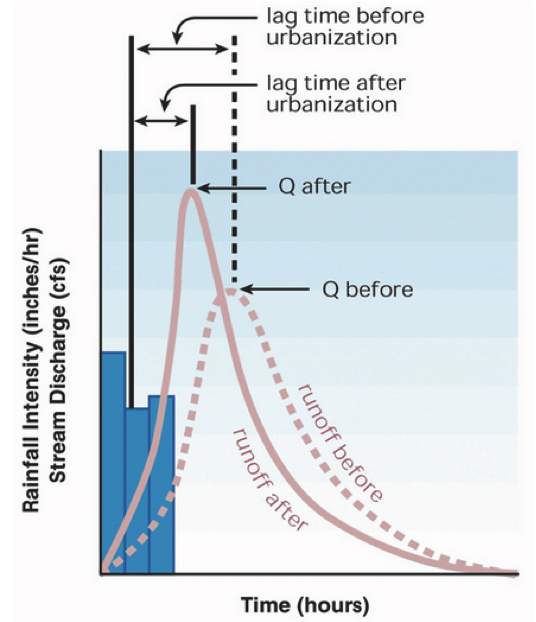
Hydrologic Versus Hydro-Geomorphic Perspectives
Hydrologic Versus Hydro-Geomorphic Perspectives
Scientists tend to think about floods in two different (but related) ways, one being strictly hydrologic and the other requiring an evaluation of the floodplain topography and how different flow regimes might impact the channel and surrounding areas. In module 3, we explored how hydrologic analyses (analyzing the patterns such as the frequency, duration, and magnitude of flood events) could be used to characterize the river flow regime (e.g., how often does the river exceed 800,000 cfs?). However, a hydrologic analysis does not provide information about the extent or duration of flooding across the landscape (e.g., which parts of the natural floodplain or streets will be flooded?). To predict how much of the floodplain might be inundated by a given flow, we need to consider the channel and floodplain topography (a hydro-geomorphic analysis). For example, a river system with low channel banks and a broad, flat floodplain will experience more frequent flooding of greater extent than a river system with tall banks and a narrow floodplain, given the same flow regime.
Because the size of a river channel can change over time, the relationship between the hydrologic flood frequency and hydro-geomorphic mapping of the area inundated may also change, as discussed in the later module section on hydrologic non-stationarity. For example, the Minnesota River (a major tributary of the Mississippi River) has widened by nearly 50% in the past 3-4 decades. Therefore a flood that may have inundated a significant amount of floodplain 50 years ago may now be entirely conveyed within the channel itself. Thinking back to the example of the Lehigh River in Figures 4 and 5 it is very likely that the 1941 flood (the lowest on record) did not fill the channel and inundate the floodplain. 1943 and 1944 had moderately high peak flows, but may also not have gotten out of the channel because the massive 1942 flood would have widened and deepened the channel. Over the following years, the channel would likely have narrowed again, in response to relatively smaller floods. Flood frequency analysis discussed below and in the exercise associated with this module, is strictly a hydrologic analysis. A hydro-geomorphic analysis is needed to estimate the risk of flood damage. Both types of analyses may be important for engineering plans and ecological studies. High-resolution topography data (elevation data with a vertical precision of about 15 cm and horizontal resolution of about 1 m, also known as ‘lidar’ for Light Detection and Ranging) is revolutionizing the way we make flood inundation predictions. Lidar data contains very detailed information about the ground surface, as well as vegetation on the floodplain, which exerts a strong influence on the velocity and depth of the water. Many states are revising their flood risk maps using this new high-resolution data.
Societal and Economic Implications of Floods
Societal and Economic Implications of Floods
Floods are consistently ranked among the most costly natural disasters around the world, with many billions of dollars in damages reported annually. For example, the Centre for Research on the Epidemiology of Disasters International Disaster Database [12] (EM-DAT) reports that floods accounted for four of the ten most deadly natural disasters in 2013, with confirmed global fatalities exceeding 9500 people (EM-DAT, (2013)). The same 2013 report documents $54 billion in damages directly related to river floods.
| Event | Country | Number of Deaths |
|---|---|---|
| Tropical Cyclone (Haiyan), November | Philippines | 7,354 |
| Flood, June | India | 6,054 |
| Heatwave, July | United Kingdom | 760 |
| Heatwave, April-June | India | 557 |
| Earthquake, September | Pakistan | 399 |
| Heatwave, May-September | Japan | 338 |
| Flood, August | Pakistan | 234 |
| Flood, July | China P Rep | 233 |
| Earthquake, October | Philippines | 230 |
| Flood, September-October | Cambodia | 200 |
| Total | 16,359 |
During late spring and summer of 1993 heavy rains all throughout the Midwestern US resulted in flooding along the upper Mississippi and Missouri river systems. The floods were the most costly in US history, causing about $15 billion in damages and forcing about 75,000 people from their homes. Heavy rains from Tropical Storm Irene in August 2011 caused approximately $10 billion in damages throughout the Caribbean and eastern United States (including flooding Kingston, NY during the wet period indicated in Figure 1). Notably, the numbers of fatalities associated with these extreme events were relatively low (~50 deaths each) due to remarkably accurate flood forecasting, highly effective emergency response systems and regulations that limit development in flood-prone areas.
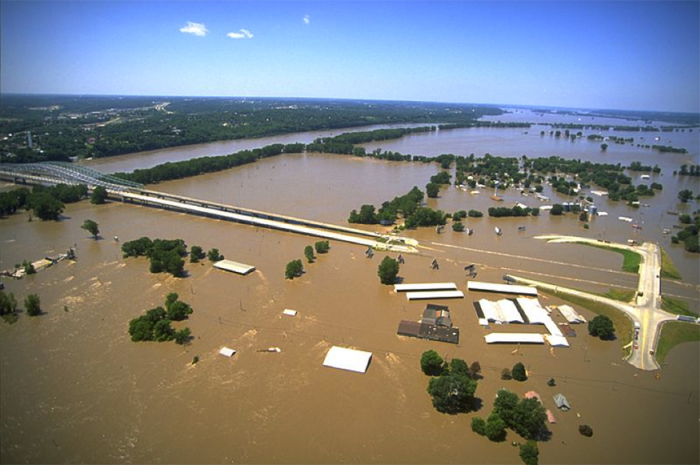
Rivers that cannot transport their sediment load (sand and gravel) are particularly susceptible to flooding because sediment settles out in the river bed, causing the river channel to become shallower relative to its banks, thus increasing the chances of flooding. The Yellow River in China is one example of such a river. While the Yellow River has played a pivotal role in the Chinese economy for thousands of years, sedimentation has repeatedly caused the river channel bed and banks to actually build up higher than the surrounding floodplain. This is an especially dangerous situation that can cause the river to catastrophically flood, breach its banks, abandon its channel altogether, and ultimately form a new channel elsewhere within the floodplain, a process known as an avulsion. The Yellow River has caused many devastating floods, including a flood in 1332-1333 that killed an estimated 7 million people. Another Yellow River flood in September of 1887 inundated an estimated 130,000 km2 (50,000 square miles, an area approximately the size of Alabama!) and killed an estimated million people. Yet another flood in 1931 is estimated to have killed 1-4 million. Such catastrophic disasters have earned the Yellow River its nickname, ‘China’s Sorrow.’
Humans have made extraordinary efforts to reduce flood damages. In some cases, these efforts involve limiting development in flood-prone areas. In other cases, these efforts involve building structures meant to control the floodwaters. Flood control structures include dams and retention basins that store water and/or building levees, dikes, and floodwalls that attempt to keep floodwaters confined. Some of the most extensive flood control systems in the world include the floodway diversions on the Red River, which runs between Minnesota and the Dakotas and crosses the US-Canada border into Manitoba.
While we typically think of floods as dangerous and costly natural hazards, they can also provide benefits to society. For example, floods naturally deliver fresh, nutrient-rich sediments to their floodplains, which have historically benefited farmers in many places throughout the world. Yearly floods of the Nile River allowed the early Egyptian people to grow crops, which helped them thrive as a civilization for thousands of years. However, the severity of the floods was unpredictable and floods that were too large caused significant damage. Therefore, in the mid-1900s the Egyptians constructed a flood-control dam on the Nile River. The dam eliminated both the risks and benefits of annual flooding and therefore agricultural practices have had to adapt by using irrigation and petroleum-based fertilizers to replace the water and nutrients that are no longer delivered to the floodplain by the river.
Flood control is not always feasible, given the unpredictable nature of these events as well as geographic or economic constraints. Nor is flood control necessarily desirable in many situations, given the potential environmental benefits for the river and floodplain discussed at the beginning of this section and discussed in greater detail towards the end of this section. In such cases, efforts can be made to reduce economic losses from floods. For example, in many places regulations limit the construction of permanent buildings on floodplains. Emergency response programs, such as the National Weather Service and Federal Emergency Management Agency (FEMA) help flood victims by improving methods to warn and evacuate people from flood-prone areas and to provide relief aid. In an alternative approach, communities in Tonle Sap, Cambodia have constructed their houses on floats and stilts to deal with the annual flooding of 8-9 m (26-30 ft) from the Mekong River.
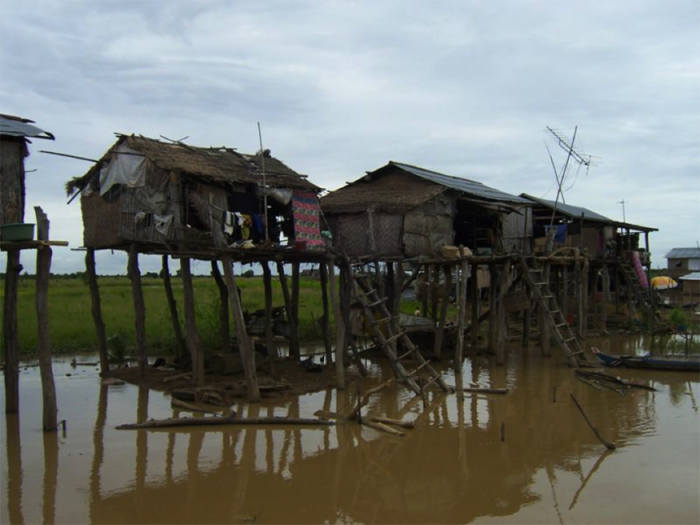
In many places, flood insurance can be purchased to help cover costs associated with residential and commercial flood damages. However, the private insurance industry is somewhat limited because the number of potential claimants far exceeds the number of people who wish to ensure their property against flooding. As a result, the US Congress created the National Flood Insurance Program in 1968. The program is an effort to provide flood insurance to protect homeowners, renters, and business owners as well as an effort to encourage communities to adopt flood risk management policies established by FEMA.
Droughts
Droughts
Video: California's Extreme Drought, Explained (3:33)
This short video from the New York Times describes the economic and environmental impacts of the severe drought that occurred in California in 2014.
Narrator: Right now 100% of California faces severe drought. This is the San Luis Reservoir near Fresno.
Jennifer Morgan, Tour Guide: You're looking at the largest off-stream reservoir in the United States and it should be twice as full at this date and time. Normally you can see the water line where it's eroded on the hills and along the dam. And usually, we fill up every year except when there's a drought and this is the third year of a major drought.
Narrator: Here's what the reservoir looks like when it's full. Currently, it's only at half capacity. So far this year, California's had only 20% of its normal rainfall and the state's snowpack, another crucial water source, is only 18 percent. Here's a satellite picture of the state from January 2013. And this is from January of this year.
Greg Gustafson, Resident, Lake of the Woods, CA: How can you flush your toilets? How can you take a shower? How can you brush your teeth in the morning?
Narrator: The results of this historic drought are already being felt nationwide.
Bill Diedrich, Farmer, Fresno, CA: A grower like myself, fourth-generation, who has so much emotion and so much of his passion tied up in dirt and production and making things grow, this is a heartbreaker.
Narrator: California produces 90% of the nation's tomatoes, 95% of its broccoli, and 99% of its almonds. That's what Bill Dietrich farms here in Fresno County. For the first time ever, the state has stopped providing water to farmers in some areas.
Bill Diedrich: Our water allocation in this area is zero. Apparently, these trees haven't received any water at all this year.
Narrator: California's agricultural output could fall by three and a half billion dollars this year. Costs across the nation are already up, attributed at least partly to the drought, with more increases expected down the line as crop yields come in this fall. The price for a single avocado could jump by 28 percent. The lack of water also means fire. California officials are bracing for a summer that could be the worst ever. A million acres could potentially burn, with costs that could surpass a billion dollars.
President Obama: Weather-related disasters, like droughts, wildfires, storms, floods, are potentially going to be costlier and they're going to be harsher.
Narrator: So how will California escape this cycle of drought? Governor Jerry Brown has called on Californians to lessen water usage by 20%.
Governor Jerry Brown, CA: And I'm calling for a collaborative effort to restrain our water use.
Narrator: But so far there's only been a five percent reduction. There are also much-needed infrastructure improvements. Converting seawater is one highly costly option. There's also the need to expand California's reservoir system, like the San Luis, for more backup during the dry spells.
Jennifer Morgan: It's going to be tough for everyone because of the drought.
Narrator: But for now drought may be the new norm across California.
California Resident: Instead of just using the dishwasher and wasting the water, might as well do it by hand and fill up the bucket and use it for the plants.
How do you know when you’re in a drought?
Identifying an area as ‘in drought’ is different from identifying it as ‘arid’. While the two may seem related, the subtle difference is important. Aridity is defined as the “degree to which a climate lacks effective, life-promoting moisture” (Glossary of Meteorology, American Meteorological Society). Drought, on the other hand, is ‘a prolonged period of abnormally dry conditions.’ Thus, aridity is a quasi-permanent condition (persistent over human timescales), while drought is a temporary condition (which may persist for weeks, years, or in some cases, decades). The Sahara Desert is an arid environment. The Hoh rainforest in western Washington State is a very humid place that occasionally experiences drought.
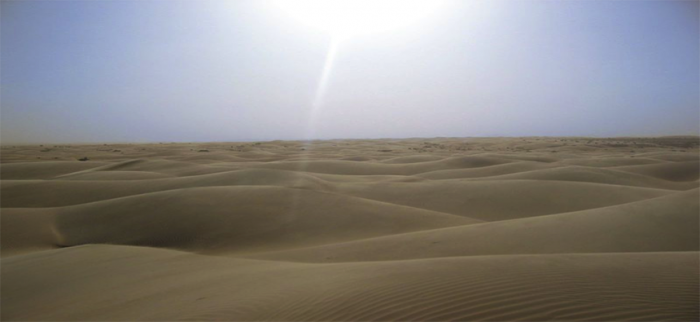
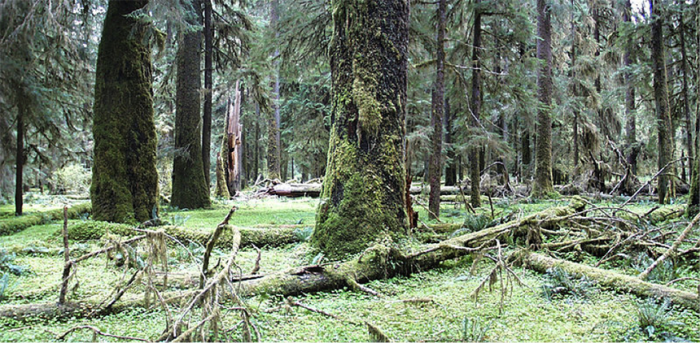
Droughts tend to be somewhat elusive phenomena, with severity gradually increasing over many days, weeks, months, or even years. The spatial extent of drought is also quite difficult to delineate, due to the spatial variability in precipitation. Therefore, they are much harder to define, monitor, and identify (relative to floods) within the ‘noisy’ background of natural wet and dry cycles. Yet the impacts of drought can be significant on many facets of the economy and environment. All types of drought originate from a deficiency of precipitation from an unusual weather pattern. If the weather pattern persists for a few to several weeks, it is said to be a short-term drought. However, if precipitation remains well below average for several months to years, the drought is considered to be a long-term drought.

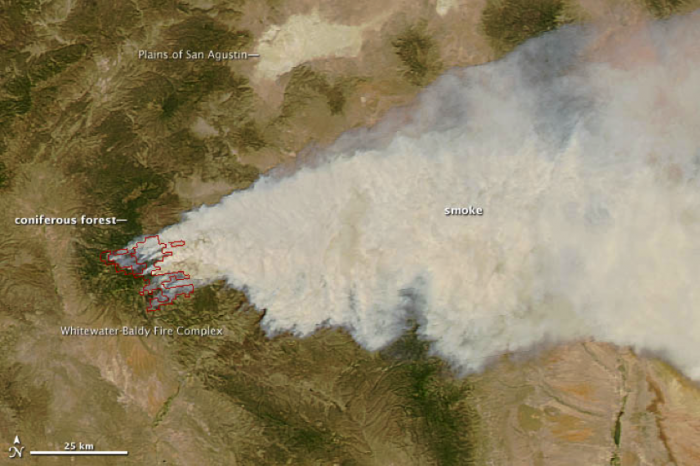
Related to the difficulty in defining drought, economic damages related to drought are also difficult to define. But only considering economic damages that can be directly related to drought, it is clear that they too can be costly natural disasters. In 2013, EM-DAT claims only 9 deaths worldwide that were directly attributed to drought (15 is global annual average from 2003-2012), but a total of nearly 8 million people were significantly affected by drought in 2013 (average is over 36 million per year from 2003-2012). Damages related directly to drought in 2013 were estimated in excess of $1 billion (average of nearly $5 billion per year from 2003-2012). However, these numbers do not include related effects of wildfire and indirect effects of decreased food production, water quality, etc.
| Phenomenona and direction of trend | Likelihood that trend occurred in late 20th century (typically post 1960) | Likelihood of a human contribution to observed trendb | Likelihood of future trends based on projections for 21st century using SRES scenarios |
|---|---|---|---|
| Warmer and fewer cold days and nights over most land areas | Very likelyc | Likelyd | Virtually certaind |
| Warmer and more frequent hot days and nights over most land areas | Very likelye | Likely (nights)d | Virtually certaind |
| Warm spells/heat waves. Frequency increases over most land areas | Likely | More likely than notf | Very likely |
| Heavy precipitation events. Frequency (or portion of total rainfall from heavy falls) increases over most areas | Likely | More likely then notf | Very likely |
| Area affected by drought increases | Likely in many regions since 1970s | More likely than not | Likely |
| Intense tropical cyclone activity increases | Likely in some regions since 1970 | More likely than notf | Likely |
| Increased incidence of extreme high sea level (excludes tsunamisg | Likely | More likely than notf,h | Likelyi |
Table notes:
a See table 3.7 for further details regarding definitions.
b See table TS.4, Box TS.5 and table 9.4.
c Decreased frequency of cold days and nights (coldest 10%).
d Warming of the most extreme days and nights of each year.
e Increased frequency of hot days and nights (hottest 10%).
f Magnitude of anthropogenic contributions not assessed. Attribution for these phenomena based on expert judgment rather than formal attribution studies.
g Extreme high sea level depends on average sea level and on regional weather systems. It is defined here as the highest 1% of hourly values of observed sea level at a station for a given reference period.
h Changes in observed extreme high sea level closely follow the changes in average sea level. {5.5} It is very likely that anthropogenic activity contributed to a rise in average sea level. {9.5}
i In all scenarios, the projected global average sea level at 2100 is higher than in the reference period. {10.6} The effect of changes in regional weather systems on sea level extremes has not been assessed.
There are four different kinds of drought.
- Meteorological drought refers to a deficit in precipitation that is unusually extreme and prolonged. By definition, meteorological drought must be identified relative to the typical precipitation regime of an area and could be defined as some point out on the long-tail of the distribution of, for example, a plot (histogram or probability density function) similar to Figure 4 [13], except with the x-axis indicating the number of consecutive dry days.
- Agricultural drought refers to a deficit in soil moisture that affects plant growth and productivity. While this term is most often used to refer to effects on agricultural crops, all plants can be affected by soil moisture drought. Paleoclimatologists (scientists who study past climate) examine the thickness of tree rings in woody plants to estimate the timing, duration, and severity of past droughts because water-stressed trees form relatively narrow rings in drought conditions.
- Hydrological drought refers to conditions in which stream discharge and/or lake, wetland and water-table elevations decline to unusually low levels.
- Socio-economic or operational drought refers to conditions when water supply is significantly below demand such that water/reservoir management must be altered. Typically, when meteorological drought occurs, the effects cascade sequentially to the other three types of drought. Likewise, when the meteorological drought ends, the effects cascade in the same sequence, first restoring soil moisture, then restoring other hydrological ‘stocks’ within the system, and hopefully restoring the balance between water supply and demand at key water management infrastructure (i.e., reservoirs).
Activate Your Learning
Go to the US Drought Monitor webpage [14] and answer the following questions:
1. Is the place where you live currently in a drought?
2. Looking back through historical maps, when was the last time your home town was in a drought?
ANSWER: The answer to this question will be different for everyone. Write your answers down and be prepared to talk about it with the class if it comes up.
Measuring the Severity of Drought
Measuring the Severity of Drought
Many different indices have been developed over the past several decades to indicate the occurrence and severity of drought. The simplest index relates precipitation amounts during a specific period of time to the historical average during that same time period. For example, precipitation for the month of June 2014 was 15% below the historical average for Wenatchee, Washington. While this statement conveys some useful information, it is not possible to determine whether or not that 15% deficit qualifies for any of the definitions of drought. The number of days with no precipitation is another simple index, but again must be considered in the context of historical data or water demand, and there is no standard definition for what number of days without precipitation would necessarily qualify under any of the four types of drought. Also, if an area receives a very small amount of precipitation (< 0.1 cm) during an otherwise unusually dry time period, a strict interpretation of this index would ‘reset the clock’, but in reality, the severity of the water deficit remains essentially unchanged. Complex phenomena, such as drought, require somewhat complex metrics to be measured in a meaningful way.
The Standardized Precipitation Index (SPI) is a slightly more complex measure of precipitation deficit that compares measured precipitation to the median historical precipitation over multiple timescales, ranging from one month to 24 months. As dry or wet conditions become more severe, SPI becomes more negative or positive, respectively. Several different indices of varying complexity have been developed to assess drought based on both water supply and demand using multiple environmental criteria. The most common index used to define and monitor drought is the Palmer Drought Severity Index (PDSI), which attempts to measure the duration and intensity of long-term, spatially extensive drought, based on precipitation, temperature, and available water content data. PDSI ranges from values exceeding 4.0, which are considered extremely wet, to values below -4.0, which are considered extreme drought (see Figure 12). Weekly maps of PDSI for the entire US (current and historical) can be viewed on the web page maintained by the National Weather Service Climate Prediction Center [15].
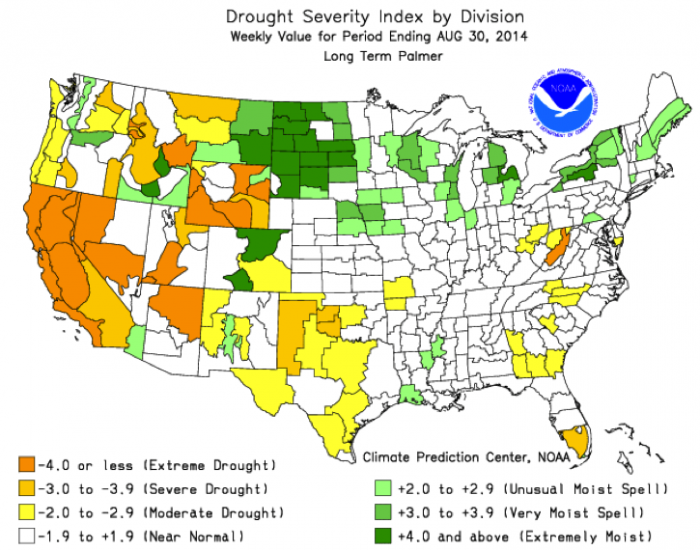
Related indices are the Palmer Z Index, which attempts to measure short-term drought on a monthly timescale, the Palmer Crop Moisture Index, which attempts to measure short-term drought and quantify impacts on agricultural productivity, the Palmer Hydrological Drought Index, which attempts to estimate the long-term effects of drought on reservoir levels and groundwater levels. An immense compilation of current and historical drought information for the entire US is freely available on the US Drought Monitor web page [14], maintained by the University of Nebraska National Drought Mitigation Center.
Increasingly, government and industry groups are using ‘cloud seeding’ techniques to induce precipitation and reduce the severity of a drought. One of the potentially limiting steps in the formation of precipitation is the presence of tiny particles (nuclei) on which water can condense and coalesce to form raindrops or ice crystals large enough to begin falling through the air. Cloud seeding is the practice of injecting nucleating agents, such as silver iodide (AgI), into clouds in an attempt to form precipitation. The effectiveness of these approaches is questionable, but under the right conditions, cloud seeding may increase the probability of rain and therefore it is practiced in some semi-arid regions, including the western US. However, questions remain regarding environmental and human health impacts as well as concerns regarding ‘stealing’ atmospheric moisture from would-be recipients downwind.
Learning Checkpoint
1. What was the Palmer Drought Severity Index for the week ending on Aug 30, 2014, for the following locations (see Figure 12 above):
St. Louis, Missouri
ANSWER: 0
Davis, California
ANSWER: -4
Miami, Florida
ANSWER: -3
2. Which of these three locations were likely experiencing socio-economic drought during this time, forcing them to actually change water use/management practices, at least temporarily?
St. Louis, Missouri
David, California
Miami, Florida
ANSWER: Definitely Davis, CA, probably Miami, Fl
Floods and Droughts Impact Ecosystems
Floods and Droughts Impact Ecosystems
How do floods and droughts impact ecosystems?
Variation in river flow (i.e., the river flow regime – see Module 3) exerts a strong influence on river and riparian ecosystem function. In particular, floods and droughts control the creation and maintenance of river and floodplain habitats and the sustainability of the high biodiversity observed along river systems. The temporal pattern of floods interacts with channel and floodplain topography to create a highly heterogeneous landscape of depressions, oxbows, gravel bars, and terraces (Figure 13). The hydro-geomorphic diversity means that the inundation frequency varies strongly over short distances on river floodplains, and creates habitats for a diverse suite of organisms adapted to a wide range of flooding frequencies.
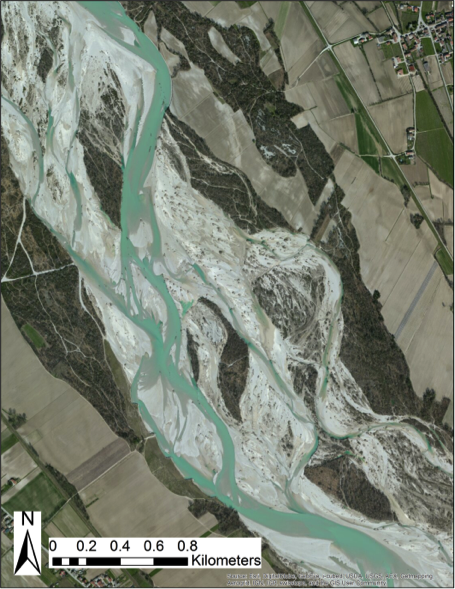
Both riparian and aquatic organisms have adapted to take advantage of flood-drought cycles in river ecosystems. For example, many fish species time spawning runs to coincide with predictable floods, because this allows large adult fish to access small streams that provide optimal habitat for egg development and growth and survival of young fish. In the Amazon River, many fish species can almost be considered forest-dwelling fish, because they feed directly on leaves, fruits, seeds, and insects that fall into the river when it floods surrounding forests during the annual rainy season. Trees of these seasonally flooded forests have in turn developed fruits and seeds that mature during the flooding season and that can survive fish digestive systems in order to take advantage of the seed dispersal ability of mobile fish species. In the western U.S., cottonwood trees time the release of seeds to coincide with the recession of flood peaks in order to access fresh sediment deposits with elevated water tables that provide ideal habitats for germination.
It may be less obvious that droughts could be beneficial for aquatic and riparian biota, but when coupled with periodic flooding, droughts play an important role in the survival of many river organisms. During droughts, resources such as organic material and nutrients can accumulate on floodplain surfaces, and when a flood does occur there is a pulse of greater resource availability than would occur under regular flooding, and this period of high resource availability can ensure the quick growth and survival of organisms, including young fish. In addition, periodic drying of rivers and floodplain wetlands eliminates competitors and predators for organisms that can quickly colonize areas when water returns. Such areas of refuge from predators are critical for the persistence of many aquatic organisms and would not exist without periods of drought.
The importance of floods and droughts to the integrity of river-floodplain ecosystems is apparent when alterations to the natural flow regime occur. Riverine organisms are often closely adapted to the local magnitude, frequency, duration, and predictability of extreme events, such that alteration of any one component can threaten species persistence. For example, recruitment of cottonwood trees along many dammed rivers in the western U.S. has essentially ceased, because the dams prevent flooding and creation of germination sites during the spring when cottonwood trees release their seeds. Excessive drought is also highly detrimental to river systems. One of the most famous examples of drought impacts is seen in the Colorado River delta in Mexico, which was once a highly productive floodplain forest and swamp, but due to prolonged drought conditions in the river basin and water infrastructure development, is now a dry desert.
Hydrologic Variability Versus the Human Need for Water Resource Reliability
Hydrologic Variability Versus the Human Need for Water Resource Reliability
Floods and droughts are natural phenomena throughout the world and natural systems have adapted to this variability over time. But human demands for water resources are not so adaptable to variable hydrologic patterns. What if you could only turn on the tap during and immediately after rainfall events? Hydroelectric dams also require a constant supply of water to respond to electricity demands on timescales of minutes and hours. Farmers in drier areas require a reliable supply of water to keep crops watered and soils from drying out. In response to societal needs for a reliable and sufficient supply of water, we have developed an extensive infrastructure to even-out variability in natural flow regimes and therefore reduce uncertainty associated with both floods and droughts.
In particular, dams and reservoirs have been constructed around the world to store water during times of flood and provide water during times of drought – as discussed in detail in the next module (Module 5) (Figure 14). Over half of the world’s large river systems (those holding 60% of the world river discharge) are impacted by dams. In fact, the construction of dams and associated filling of reservoirs slows the rotation of the Earth (though only adding ~0.1 microseconds to the length of a day)! However, as we will see in Module 5, the construction of dams and evening out of hydrologic patterns has profound impacts on geomorphic and ecological processes in river systems, and the manipulation of discharge leads to reduced variability in flow regime (e.g., Figures 15 and 16), among many other effects.
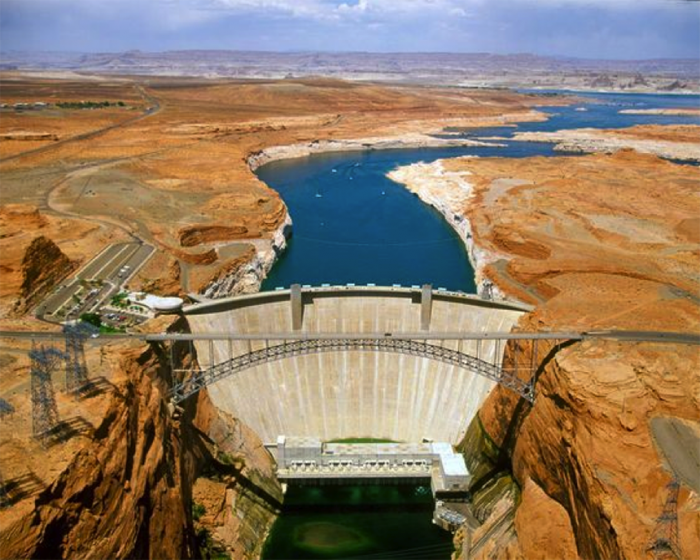
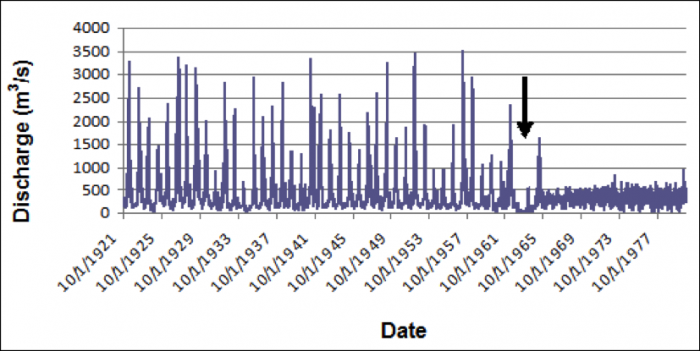
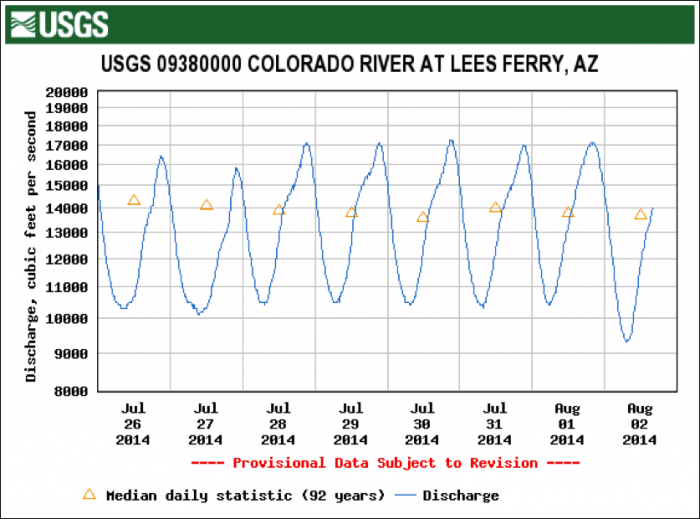
Non-Stationary Hydrology
Non-Stationary Hydrology
When ‘normal’ changes: non-stationary hydrology
As we have discussed at length above, floods and droughts can have significant impacts on society and the environment. However, as also discussed above, we can characterize the frequency, duration and magnitude of these rare or extreme events and both human and natural systems have mechanisms to deal with them. For example, we can estimate the magnitude of a 100-year flood and build a bridge sufficiently large to pass the flood with minimal risk of damage to the bridge or changes in water depth (i.e., from water backing up behind the bridge and therefore flooding additional land upstream). Similarly, we can compute the width of a floodplain that would be inundated from that 100-year flood and choose to not build within that flood corridor, or choose to require those who do build within the flood corridor to purchase flood insurance to cover costs of potential damages.
Similarly, as we discussed in module 3, river channels naturally adapt their width and depth to accommodate common floods. Thus, society and the environment naturally develop some amount of resiliency to historical climate extremes. However, all of the prediction methods we have discussed so far in this module rely on the assumption that the future will look statistically similar to the past (i.e., the distribution of events will not change and occurrence of events in the future will be consistent with the probabilities computed from the histograms or probability density functions such as those shown in Figures 3 and 4). This assumption is known as the Stationarity Assumption in hydrology. Specifically, stationarity implies that while there is considerable variability in precipitation and streamflow, that variability is bouncing around a relatively constant average value and has a relatively constant spread, as shown in the hypothetical plot of peak streamflow over time in the left panel of Figure 17. From left to right, the mean (µ) and standard deviation (s, i.e., the spread of the data around the mean) don't change. However, as climate changes, the magnitudes, durations, and frequencies of floods and droughts may occur that are outside the historical range of observations, resulting in a change in the average magnitude of floods (Figure 17, middle panel) or a change in the variability of floods (Figure 17, right panel). In either of these situations, the statistics from the left side of the graph don't provide a good basis for making predictions about the right side of the graph (or predicting what will happen in the future!). Understanding and accounting for such non-stationary patterns in precipitation and streamflow are among the greatest challenges in hydrology today because we need to make accurate future predictions for many decisions about flood and drought risk, infrastructure design (roads, bridges, culverts, ditches, parking lots, detention basins, sewers, etc.!) and water availability. So this is a hot topic in the field and many new techniques are emerging!
Non-stationarity will be common in the future as regional climates systematically change. According to the Intergovernmental Panel on Climate Change, climatic warming will increase the risk of both floods and droughts (Table SPM2 in IPCC, 2007; see also IPCC, 2014). The multitude of factors that combine to ultimately cause floods and droughts are exceptionally difficult to predict over the next few decades. Nevertheless, there is a high level of agreement among the competing IPCC climate simulation models regarding the general trends of several metrics. For example, precipitation intensity increases are expected in most places and especially at mid- and high-latitudes where mean precipitation also increases. Summer droughts are also expected to increase over low and mid-latitude continental interiors. Snowpack is expected to decline overall as more precipitation will fall as rain rather than snow, especially in areas with temperatures near 0°C in fall and spring. Relatedly, snowmelt is projected to occur earlier. The combination of less snowpack and earlier snowmelt increases risk of summer to fall drought in snowmelt dependent regions, such as the western US. Some regions outside the US are highly dependent on meltwater from glaciers for water supply. Accelerated melting due to climatic warming increases the risk of flooding downstream in the near-term. In the long-term, glaciers in many of these areas will shrink and ultimately cease to exist, posing a serious threat to the downstream water supply. This poses a serious risk to the hundreds of millions of people in China and India who depend on glacial meltwater from the Hindu Kush-Himalayas. In closing, there is a good reason to expect floods and droughts to become more severe in the coming decades, increasing the urgency for improved predictions, mitigation efforts, and adaptation strategies.
Module 5: Dam it All!
Module 5: Dam it All!
Introduction
In the preceding modules, we’ve discussed the uneven distribution of precipitation and water resources on Earth’s surface (Modules 1-2), and the dynamics of rivers and streams as the primary conduits for the return of water that falls over the continents to the oceans (Modules 3-4). One fundamental challenge to populations is that precipitation does not fall where we need it when we need it. This is amplified by the fact that many population centers are located in areas that are perennially dry, including those in the US Southwest.
How do we store water delivered by rivers to provide reliable and secure supply when we need it, where we need it, and tame the flow in abnormally wet conditions to mitigate flooding? The main solution is to dam rivers and fill the reservoirs behind them. This stores large volumes of water that ensure a stable supply, the reservoirs act as “capacitors” in the hydrologic system to absorb excess flow and thus prevent flooding downstream, and the dams simultaneously produce electric power as water is released in a steady, controlled discharge from the reservoir. However, dams and their reservoirs also profoundly impact the natural river system and can cause irreversible changes to the environment and to populations both near the dam and far up- and down-stream. In Module 5, we will explore the benefits and consequences of construction and removal of large dams, both in the US and globally, including a discussion of case studies along the Yangtze and Nile rivers.
Goals and Objectives
Goals and Objectives
Goals
- Describe the two-way relationship between water resources and human society
- Explain the distribution and dynamics of water at the surface and in the subsurface of the Earth
- Synthesize data and information from multiple reliable sources
- Identify strategies and best practices to decrease water stress and increase water quality
- Thoughtfully evaluate information and policy statements regarding the current and future predicted state of water resources
- Communicate scientific information in terms that can be understood by the general public
Learning Objectives
In completing this module, you will:
- Weigh the advantages and drawbacks of large dams, including economic, environmental, and cultural impacts
- Explain the reasons why dams are built, and the rationale for removing them
- Assess whether government agencies should be responsible for regulating new dam construction
- Debate whether a dam is the most appropriate solution to water needs and flood control in a particular location
Introduction to Dams
Introduction to Dams
Think about your impressions of dams and the reservoirs behind them that you have seen. Large concrete dams have grandeur, and the huge lakes that they contain are often sited in attractive canyon or valley settings and provide picnic, swimming, and boating facilities. If you had grown up in the arid southwestern U.S., you might have thought of these as oases—providing relief from summer heat and dryness; had you grown up in the eastern U.S., you may have appreciated the dam-impounded reservoirs as camping and fishing spots. It is likely that, when you were young, you did not appreciate the real purposes of these structures or the controversies that surrounded some of them as they were proposed and built.
Dams most importantly provide: 1) dependable water supplies in areas experiencing significant annual fluctuations in precipitation and runoff or lacking other water sources such as groundwater; 2) a flood control buffer for times of excessive precipitation and runoff; 3) hydraulic head for generating hydroelectric power; and 4) recreational opportunities including boating, fishing, and swimming. During the colonial settlement and expansion in eastern North America, dams provided direct hydropower primarily for mills. Later, during the settlement of the semiarid to arid west, small dams provided water storage for irrigation and watering livestock. These two contrasting uses of dams, one in a relatively water-rich region, and the other in arid lands led to different water laws, which have been outlined in Module 1. An estimated 75,000 dams (over 25 feet) have been constructed in the U.S. alone (Graf, 1999), providing water storage of about 4 acre-feet (5000 m3) per year per person. Please go to this video of U.S. dam building since the early 1800s to see the pace and geographic location of dam building.
Video: US dams (00:20) This video is not narrated.
If the video does not play, watch it on the CSDMS website [17].
Figure 1 illustrates the increase in water storage from 1900 to the present on a global basis. This compilation shows clearly the impact of the U.S. dam building era, beginning in the 1950s as well as the decrease in the rate of water storage beginning in the 1980s with reduced rates of dam construction and the onset of dam removal projects. With an estimated 22,000 large dams China's push to build more dams is creating controversy.
Reading
Please take some time to read about it China’s Great Dam Boom: A Major Assault on Its Rivers [18].
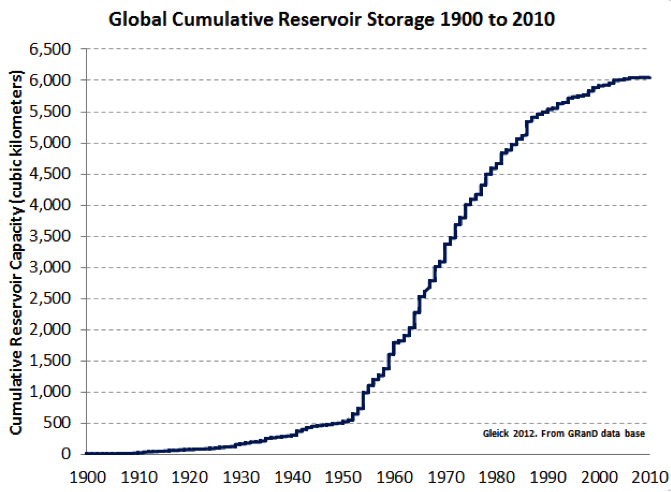
Activate Your Learning
1. Why are large dams constructed? List four reasons.
ANSWER: Flood prevention, water supply, power, recreation.
2. From inspection of Figure 1, during what time period was dam construction happening most rapidly?
ANSWER: Where the slope of the graph is steepest, reservoir capacity was increasing most rapidly; this is between around 1955-1990.
3. Globally, dam construction has tapered off since around 1990-1995. Can you think of any reasons why this would be the case?
ANSWER: There are probably several reasons. For the most part, the best and largest dam sites have already been developed. In addition, environmental impacts and concerns have become increasingly visible and led to more opposition and stricter regulation.
Dams are, at times, perceived as being environmentally benign, particularly because the generation of hydroelectric power involves no direct greenhouse gas emissions. But there are impacts of dams that are deleterious to the environment and human health. For example, one of the major impacts of having constructed large dams on active, high gradient river systems carrying large volumes of water and sediment is the buildup of sediment behind the dam(s) and the decrease in sediment supply to coastal regions. Many modern deltaic coasts, including the Mississippi Delta region and the Colorado River Delta in North America, have been receding rapidly as the result of a series of dams emplaced on the Missouri River and the Colorado River, respectively. There are also impacts of ponded waters on human health, particularly in tropical regions where diseases and parasites are harbored by the biota in warm, slowly circulated waters. In addition, dams commonly impede the upstream migration of anadromous fishes to spawn, including shad and herring on the east coast of the U.S. and steelhead and salmon in the west, thus limiting natural populations and reaches of these fishes. Controversy surrounds many older dams that impede fish migration. Dams also alter environmental conditions, including changing water temperatures, oxygen concentrations, and nutrient loads that can substantially alter the ecology of river systems, as can be seen in the case of the Colorado River below Glen Canyon Dam (see below).
Yet, dams do serve human needs and there is a rich history of dam building in the U.S. that has now diminished (Figure 1). Although dams are now rarely constructed in the U.S., other countries have continued to build dams to control floods and provide hydroelectric power. In the U.S. many hydroelectric dams require upgrades and recertification because of newer regulations. Such aging dams, many privately owned, face economic pressures in conforming to modern requirements that include studies of environmental impacts, possible additions of fish ladders that will allow fish to bypass dams, etc. These impacts are weighed against benefits (water storage, hydroelectric power generation) in recertification. Increasingly, dam owners assess costs and find it much less costly to remove a dam than to refit it to conform to requirements. A number of large dams have now been removed or are proposed for removal. Even though dam removal can be beneficial, there are also possible significant environmental issues to be confronted, including the amount and composition of sediment ponded behind the dam.
Ponding the Waters: Impacts of Dams
Ponding the Waters: Impacts of Dams
As we’ve covered in the first part of this module, the need for dams is largely driven by the uneven distribution of precipitation, resulting from river discharge, and thus water supply – in both time and space. Dams control river flows and provide capacitance in the river channel to satisfy demands for continuous water supply (i.e. for irrigation and domestic use, for flood control, and power generation). However, such large-scale alteration of the natural river has wide-ranging impacts both upstream and downstream, where the ecology, geology, hydrology, and human populations have evolved in tandem with undisturbed patterns of variable river discharge. Here we’ll briefly cover some of these impacts, and highlight using examples from well-known case studies including the Three Gorges and Aswan High Dams.
Nutrient Supply to Floodplains
Nutrient Supply to Floodplains
Flooding is a natural process that replenishes soil and nutrients to floodplains. Of course, floodplains are ideal sites for agriculture – they are flat, water is accessible, and – at least prior to modification of the system by levees or dams – the soils are among the most fertile on Earth due to recurring flooding that deposits nutrient-rich fine-grained sediments. Historically, these are the sites of major agricultural and population centers, including the “Fertile Crescent” along the Tigris-Euphrates floodplain (now largely barren due to long-term effects of irrigation-based agriculture and flood prevention), and the Nile Floodplain (see The Nile River and Aswan Dam below). Likewise, most major modern agricultural production is localized to floodplains - including the Central Valley of California, the Susquehanna River Valley, the upper Tigris-Euphrates basin, the Nile Valley, and the floodplains of the Mississippi and Missouri Rivers.
Prevention of flooding through the combination of dams (which control river discharge) and levees (which artificially channelize flow and shunt it downstream so that it cannot spill onto the floodplain) is a strategy to limit the loss of crops and property, and allow development in otherwise flood-prone areas. This approach, while generally effective in limiting short-term losses, affects soil fertility, groundwater systems, and the health of downstream waterways in the longer-term. For example, flood prevention eliminates a major source of recharge to aquifers in valley-fill sediments that lie below the floodplain. Recurring floods also serve to flush salts that accumulate naturally in soils due to evaporation and transpiration (i.e. water is transported to the atmosphere by these processes, but even small amounts of dissolved salts remain in the soil). Reduction or elimination of this flushing can lead to soil salinization, with negative effects on soil fertility.
Perhaps most notably, by eliminating or limiting the replenishment of nutrients to the floodplain, imported fertilizer is required to grow crops. Excess fertilizer application, in turn, leads to runoff enriched in Nitrogen and Phosphates that affects aquatic species and can cause eutrophication of lakes and estuaries downstream. This is a longstanding problem that leads to algal blooms at river mouths, consumption of Oxygen by organic matter (dead algae), and ultimately to “dead zones” in these regions that affect fisheries (Figure 2).
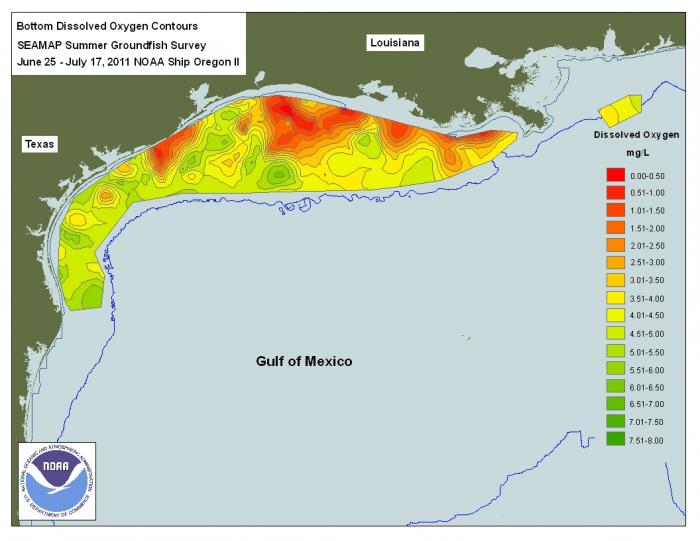
Learning Checkpoint
1. Why are floodplains historically ideal for agriculture? List three reasons.
ANSWER: Nutrient supply, soil replenishment, water supply, typically flat. Could also note that rivers provide transport pathway for produced goods.
2. What is the main negative effect of eliminating the replenishment of nutrients to floodplains on ecosystems and river health downstream?
ANSWER: It leads to the addition of fertilizers and nutrients to the land, which in turn runs off to the river and ultimately the ocean. This leads to algal blooms that extract dissolved oxygen from the water, and cause hypoxic, or “dead” zones that impact fisheries and ecosystem health.
The Nile River and Aswan Dam
The Nile River and Aswan Dam
Large rivers are difficult to control. The Nile River, so important to Egypt's populace, is no exception. But since the late 1960s, the Nile River has been under the control of humans because of the construction of the Aswan High Dam. Part of the rationale for this dam was to manage the natural cycles of flood and drought to produce dependable water supplies for farming and other uses. The consequences of cyclic climate variations on a decadal scale were buffered by the large storage capacity of the Nile Valley behind the High Dam, which is nearly six trillion cubic feet (157 km3) of water! This is about four times the amount of water stored behind Hoover Dam (USA, Lake Mead) and Three Gorges Dam (China) (Chao et al., 2008). In addition, the Aswan High Dam initially produced a significant amount of electrical power (about 50%, now less than 15% of Egypt's needs) that allowed electrification of "rural" Egypt.
Figure 3 shows the narrow Nile River Valley slicing northward through the Egyptian desert. The narrow green band of the Nile River Valley represents farmland irrigated by waters of the Nile River. Prior to the completion of Aswan High Dam, the Nile River would flood its valley annually during the rainy season in its higher altitude headwaters (Ethiopia, Sudan, Kenya, Uganda), bringing nutrient-rich silt to fields and renewing fertility. In addition, a substantial volume of sediment was carried down the Nile River Channel to its large delta, building out the delta into the Mediterranean Sea, providing additional fertile land for farming. This no longer happens because the Aswan High Dam effectively (an unintended consequence) traps sediment carried from the highlands behind it. Now, the delta region, which subsides naturally as the result of compaction of sediment (newly deposited sediments have water contents of 70% or more that are reduced by compaction by overburden), is diminishing in size because rates of coastal erosion exceed supply of sediment. Currently, almost 1/3 of the Nile Delta’s land area sits within a meter of sea level. Subsidence rates vary across the delta, but in some areas, the land surface is sinking as fast as 1 cm/yr. Control of the Nile’s flow has also lead to water quality problems. Because once-regular floods no longer flush salts, sewage, fertilizers, and waste from the delta, surface waters are polluted and those living near the Mediterranean coast increasingly rely on groundwater to meet demand for drinking water and domestic use. Extraction of groundwater, coupled with land subsidence, has led to saltwater intrusion in the aquifer as far as 30 km inland.
There have been other unintended consequences of the Aswan High Dam including the spread of disease (Schistosomiasis), a decrease in water quality and increase in algal blooms resulting from fertilization of farm fields and irrigation runoff, flooding of historical sites, and displacement of people from the regions flooded by the reservoir.
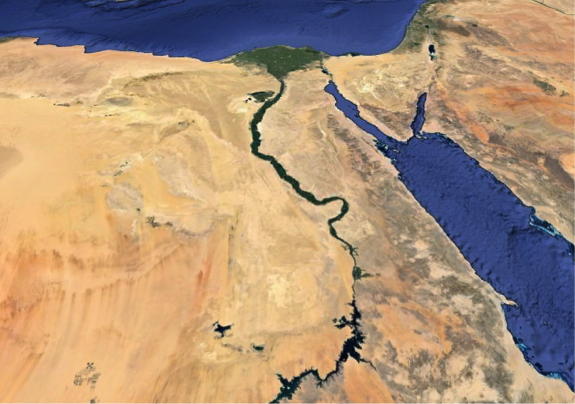
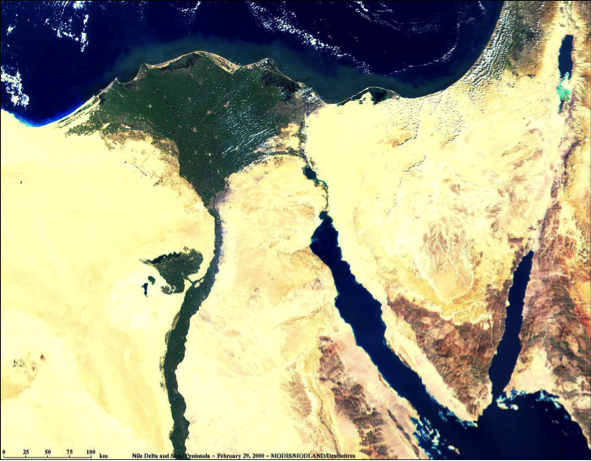
Sediment Trapping
Sediment Trapping
Because large reservoirs behind major dams are areas where water flow velocity is slowed (also often called “slackwater”), sediments are deposited where rivers enter the water body (Figure 5). Sedimentation in reservoirs behind dams has several consequences. Sediment deposition reduces reservoir water storage capacity and therefore limits the useful lifetime of the dam for flood control, water supply, and hydropower generation. Recent detailed studies of storage capacity and sedimentation rates for reservoirs in the U.S. suggest that average annual storage losses range from less than 0.5% to more than 2% (see supplemental reading: Graf et al., 2010; “Sedimentation and sustainability of western American Reservoirs, Water Resources Research”). The highest rates of storage loss are occurring in the American West, and the lowest in the Northeast.
For example, almost 20 million tons of sediment are deposited annually in reservoirs along the Mississippi River (UNESCO, 2011). China’s Three Gorges Dam alone (one of several along the Yangtze River) traps 34 million tons of sediment per year, or 31% of the river’s sediment load (Hu et al., 2009). Globally, the amount of sediment trapped behind dams is estimated to be 73 km3 (Syvitsky & Kettner, 2011). This sediment accumulation slowly reduces reservoir capacity behind dams and is one factor that limits their useful life expectancy. Recent studies of sediment accumulation suggest that the life expectancy of Lake Powell is ~300-700 yr, and that of the Three Gorges Reservoir in China is ~150 yr.
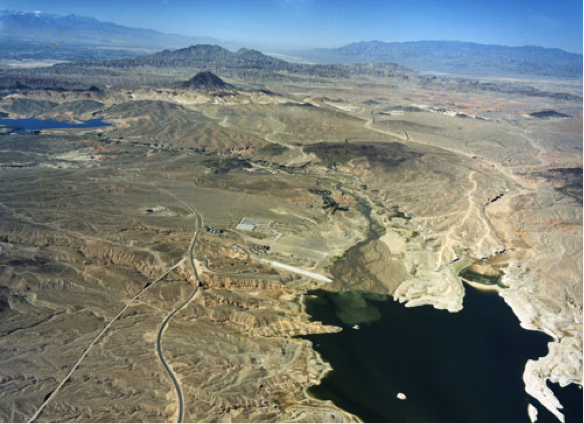
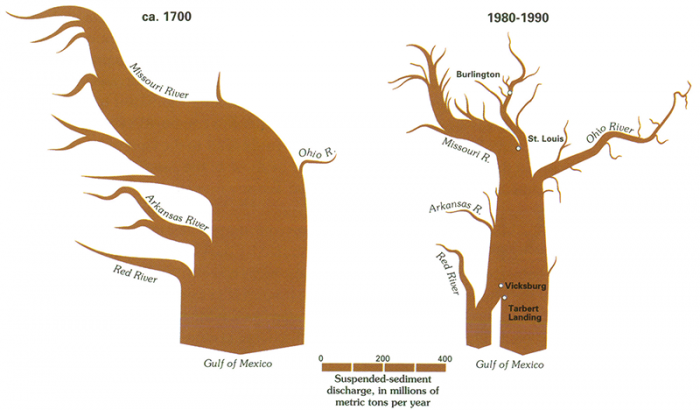
The concomitant reduction in sediment delivery to downstream areas also has several consequences (Figures 5-6). Ultimately the decreased sediment supply to the river mouth translates to net erosion of beaches and loss of land in coastal regions, as natural coastal erosion by currents and subsidence caused by compaction of delta sediments is not offset by delivery of sediment. For example, prior to construction of the Aswan High Dam began in 1960, the annual sediment flux to the Nile Delta was ~100 million tons. This sediment supply was enough to offset erosion and natural subsidence.
Consequences of Concomitant Reduction
Consequences of Concomitant Reduction
The concomitant reduction in sediment delivery to downstream areas also has several consequences (Figures 7-9). Ultimately the decreased sediment supply to the river mouth translates to net erosion of beaches and loss of land in coastal regions, as natural coastal erosion by currents and subsidence caused by compaction of delta sediments is not offset by delivery of sediment. For example, prior to construction of the Aswan High Dam began in 1960, the annual sediment flux to the Nile Delta was ~100 million tons. This sediment supply was enough to offset erosion and natural subsidence.
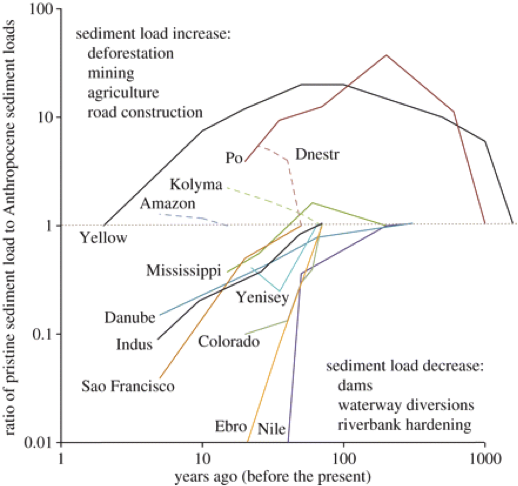
Without continued sediment delivery, subsidence and coastal erosion lead to significant losses of land area (Three Gorges: A “Mega-Dam” and its Impacts), much of which is prized for agriculture or development. Currently, parts of the Nile Delta are subsiding at up to 1 cm/yr. This phenomenon is common to most of the world’s major river systems, including the Mississippi, Colorado, Yangtze, and Indus Rivers (Figure 7). For example, much of New Orleans is subsiding at over a half-centimeter per year, with some areas sinking more than 2.5 cm/yr (Figure 9). The combination of subsidence, coastal erosion, and sea-level rise has led to land loss from the Mississippi Delta of almost 1100 acres per year since the mid-1970s.
The same processes also place these areas at especially high risk for flooding in major storm events. Much of the inundation of the Gulf Coast caused by Hurricane Katrina in 2005 occurred in areas that lie below sea level due to subsidence. The effects of subsidence are compounded by the loss of barrier islands as their sediment supply is not replenished. Further, extraction of groundwater from the subsurface – and in some cases oil and gas - exacerbates land subsidence, and can also lead to saltwater intrusion in coastal aquifers.
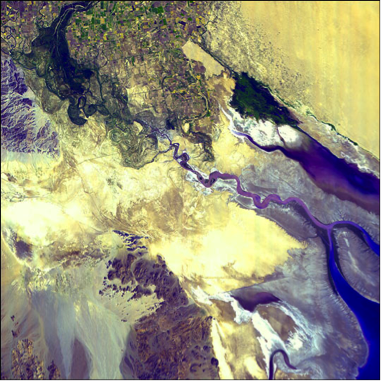
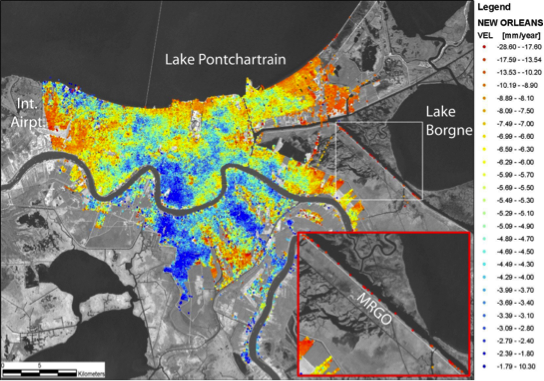
Consequences of Release of Water
Consequences of Release of Water
Release of water from the downstream side of reservoirs at dams affects the ecology of the river downstream because there is little or no entrained sediment to replenish alluvial deposits along the river, and, in fact, the now sediment-starved river is more likely to erode existing bars, beaches, and riverbeds. In many cases, the clear water released from dams can erode fine-grained sediments (silts and clays) from river banks and bars, leaving behind the coarser sand and gravel deposits that would require higher flow velocities to mobilize (as we covered in Module 3…remember?). Increased scouring can also lead to destabilization and landsliding along the river banks.
Erosion of sandbars and beaches poses a threat to native fish species that depend on sheltered waters for spawning or their fry. For example, the population of the humpback chub, a fish species native to the Colorado River system, has decreased by an estimated 75% since 1982. The chub was uniquely adapted to thrive in the sediment-laden, low-visibility and naturally turbulent waters of the Colorado River. Since the construction of Glen Canyon Dam, the clear, colder, and more stable flow has favored non-native predatory species like brown and rainbow trout.
Deposition and storage of sediments behind dams also lead to the buildup of organic material and nutrients adsorbed to sediment grains or trapped in pore spaces that will be released if the dam is decommissioned. As discussed in the next part of this module (“Bringing Down the Dams”), if or when dams are decommissioned, many years’ worth of sediment, nutrients, and carbon must be managed. Release of the stored sediment can lead to:
- inundation of the river system with suspended sediment that increases water turbidity
- introduction of nutrients to the river mouth that can lead to eutrophication and dead zones
- the potential release of toxins, including metals and volatile organic compounds adsorbed to fine sediment, to downstream areas
Recent controlled water releases have been conducted to explore the possibility of delta and downstream habitat renewal. In 1996, a seven-day-long experimental release of 1290 m3/s (that’s about 20 million gallons per minute) from Glen Canyon Dam was conducted to evaluate the prospects for the restoration of stream habitat through the rebuilding of sandbars and beaches. The experiment yielded mixed results – most notably that sand was initially deposited on bars and beaches, but only during the first couple of days of the release. There was not enough sediment load in the released water to sustain deposition, partly because the experiment was not synchronized with the natural seasonal sediment flux from upstream tributaries; as a result, existing bars were eroded and remobilized in the late stages of the controlled flood. In March 2014, a “pulse flow” of 105,000 acre-feet (about 1% of the River’s annual discharge) lasting until mid-May was released from Morelos Dam to bring water to the Colorado River Delta through a joint US-Mexico initiative. You can listen to a brief news story about the experiment: Well, I'll be Un-Dammed: Colorado River (Briefly) Reached The Sea [23]. The pulse flow was designed to mimic natural spring floods that disperse seeds, nourish the delta, and provide habitat for waterfowl. These experiments suggest that partial restoration may be possible, but will likely require a better understanding of the dynamics of stream habitats and sediment delivery and transport processes.
Other Impacts
Other Impacts
In this section, we will consider other impacts of dams.
Pollution
Pollution
In addition to the increased nutrient concentrations from agricultural return flow downstream of dams, the reduction in flow velocity in slackwater behind dams leads to reduced flushing of pollutants that enter the river. In areas subject to high rates of municipal or industrial wastewater discharge, or to agricultural runoff, this can lead to significant impairment of water quality in the reservoir itself, and in upstream tributaries (for example, see Three Gorges: A “Mega-Dam” and its Impacts). High nutrient fluxes can also lead to eutrophication of the reservoir. Additionally, the increased surface area of reservoirs leads to large evaporative losses and subsequent increases in water salinity, especially in arid and semi-arid climates.
Fish Spawning and Migration
Fish Spawning and Migration
As noted previously, dams have wide-ranging effects on downstream habitat through changes they cause to water turbidity and sedimentation and erosion patterns. These changes threaten certain species that have evolved to thrive in the natural system – like the humpback chub – through a combination of decreased or degraded breeding habitat and increased predation by non-native species. Additionally, because water released from dams through intakes flows from the deep part of the reservoir, it is commonly colder than the natural river flow – and its temperature is less variable than in the river’s natural state. For example, prior to construction of the Glen Canyon Dam, water temperature in the Colorado River varied from ~0 to 27° C over the course of the year; water discharged from the dam now averages ~8°C and varies little seasonally. The changes in water temperature and its variability impact some fish species, which rely on temperature cues to trigger key lifecycle events. The lower oxygen levels in waters released from storage behind dams also impact fish downstream.
Finally, dams present physical barriers to catadromous and anadromous fish species (those that spawn in saltwater and live in freshwater, and vice-versa, respectively). These fish migrate either upriver from the ocean (anadromous), or downriver to the ocean (catadromous) to spawn. After hatching, the young fish migrate in the opposite direction. Of these, perhaps the best known is the salmon, which migrates up-river to spawn, commonly over hundreds or thousands of km – for example, although greatly reduced due to major dams along the Columbia and Snake Rivers, Chinook salmon runs commonly extend from the Pacific Ocean all the way to Idaho! Structures designed to allow fish to navigate dams, such as fish ladders, are one solution, but they still present a barrier that reduces the likelihood of safe passage, and thus fish numbers.
Diseases – A Tropical Malady
Diseases – A Tropical Malady
The large reservoirs impounded by dams provide breeding grounds for some water-borne diseases and parasites, especially in tropical climates. Among the most prevalent of these is schistosomiasis, a disease caused by parasitic worms. The parasite is spread by freshwater snails, and has come to be known as the “disease of hydroelectric dams”. It infects an estimated 200 million people per year (with 200,000 fatalities), primarily in Asia, Africa, and South America. Through the expansion of habitat for the disease vector by large slackwater reservoirs, the incidence of this and other diseases is greatly increased. For example, in the Yangtze River Basin, the incidence of schistosomiasis is near 5%, versus less than 1% in less or undeveloped areas.
Dams and major irrigation projects also provide expanded breeding habitat for insects (mosquitos) that serve as vectors of Dengue fever, malaria, and West Nile virus, among others. The World Health Organization (WHO) estimates that malaria cases in villages near the Bargi reservoir in India increased more than twofold following the dam’s construction, and up to four-fold in villages closest to the dam itself. Likewise, malaria incidence increased by seven times in proximal Ethiopian villages following the construction of small dams on the Tigray River. A similar increased incidence of West Nile virus has been documented as a result of increased mosquito breeding area in many parts of the world, including the Midwestern U.S., California, and Oregon.
Earthquakes and Structural Failures
Earthquakes and Structural Failures
Impoundment of water behind major dams changes the distribution of stress in the Earth’s crust, and in combination with downward percolation of impounded water, can trigger seismicity. For the most part, this phenomenon is restricted to increased numbers of small (magnitude <3.5) earthquakes triggered by the increased load of millions of m3 of water, associated warping – or flexure – of the crust, and diffusion of water pressure from the reservoir along fractures and fault lines (Figure 10). Although hotly debated, reservoir-induced seismicity has even been invoked as a possible mechanism for the devastating 2008 magnitude 7.9 Wenchuan earthquake that killed an estimated 80,000 people (see one news article discussing this issue here [24]). The reservoir impounded behind the 156 m-tall Zipingpu Dam lies above the Beichuan- Yinxiu fault, which extends to the Northeast to the earthquake hypocenter, located ~50 km away.
Although remote, there is also a potential risk of dam failure to life and property downstream. In some cases, the causes of such failures are not known with much certainty. For example, the collapse of the St. Francis Dam Northeast of Los Angeles in 1928 resulted in the catastrophic release of over 12 billion gallons of water. The flood wave, which was over 140 feet high, killed an estimated 600 people and scoured the valley below, transporting fragments of the dam as large as 10,000 tons for almost a mile downstream. In other cases, upstream flooding or inadequate ability to release water and relieve pressure on the dam are the culprit, as in the famous collapse of the South Fork dam and resulting 1889 Johnstown PA flood that killed over 2000 people and triggered changes to liability laws in the U.S. In 1986, a similar disaster at the Glen Canyon Dam was narrowly avoided.
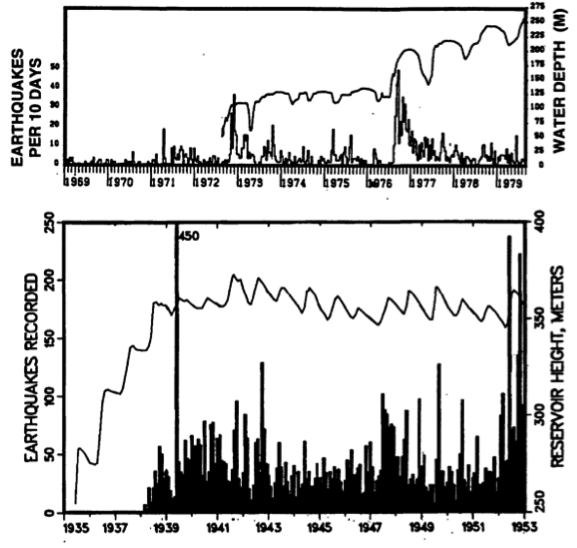
Politics and Control of Flow Across Borders
Politics and Control of Flow Across Borders
Rivers are not restricted by state and national borders, whereas dams are rarely constructed or managed by collaboration between governments. As a result, alteration, interruption, and control of river discharge by dams naturally leads to political and legal conflict. In the case of the Colorado River, which we will cover in more detail in Module 8 (Cities in Peril), the allocation of water between states within the drainage basin is governed by the 1922 Colorado River Compact. Allocation of water between the U.S. and Mexico is governed by an international treaty established in 1944 and recently revised in 2012. Even though well established, the water allocation of the Colorado, and its fairness are widely debated. The compact is also the focus of lawsuits over water rights for Native American reservations, which were not explicitly included in the original agreement. Court battles have also arisen over other river flows in recent years (for example in Florida and Georgia, and along the San Joaquin and Sacramento Rivers) pitting access for communities or farmers against minimum limits on flow required to support endangered species.
Globally, other rivers and dams are the source of equal – or more – controversy. As one example, at the 1992 opening ceremonies for the Atatürk Dam on the Euphrates River in Turkey, the president of Turkey is reported to have said, "Neither Syria nor Iraq can lay claim to Turkey’s rivers any more than Ankara could claim their oil. This is a matter of sovereignty. We have a right to do anything we like. The water resources are Turkey’s, the oil resources are theirs. We don’t say we share their oil resources, and they can’t say they share our water resources." The conflict over waters of the Tigris-Euphrates continues (you can listen to a story about this dispute here [25]). Dams and control of river flows in the headwaters of the river system, and subsequent impacts on water access to supply populations with drinking water, to grow food, and support industry in the downstream nations of Iraq and Syria, are at the heart of the dispute. Similar tensions are now arising along the Mekong River between China (upstream) and downstream neighboring countries of Myanmar, Thailand, Laos, Cambodia, and Vietnam that rely on the river.
Three Gorges: A “Mega-Dam” and Its Impacts
Three Gorges: A “Mega-Dam” and Its Impacts
The Yangtze River is the longest river in Asia and is the world’s 3rd longest (only the Nile and Amazon are longer). It flows for ~6300 km from its headwaters on the Tibetan Plateau to its delta at Shanghai, where it discharges to the East China Sea. The Yangtze watershed encompasses approximately 1/5 of China’s land area. The river serves the water demand of millions of people and the delta alone supports almost 20% of China’s GDP. However, the Yangtze is also notorious for its frequent and devastating floods. Floods in the twentieth century alone led to the loss of an estimated 300,000 lives, including 145,000 drowning deaths in a 1931 flood, and 30,000 deaths in 1954 from flooding and diseases that followed. In addition to loss of life, these floods inundated hundreds of thousands of acres of productive farmland and caused billions of dollars of damage.
To protect over 15 million people in Shanghai and the lower Yangtze floodplains, and control flooding of almost 15,000 square km of land, construction of the Three Gorges Dam began in 1994. The dam, constructed at a cost of between ~$28-60 billion dollars (exact cost is not known because the project has been funded by a combination of government subsidy and private investment), is nearly 200 m high, spans more than 2 km across the river, and was engineered to withstand a magnitude 6.0 earthquake (Figure 11). The long, narrow Three Gorges Reservoir extends ~600 km upstream and has a capacity of almost 40 billion m3 of water (equivalent to about 32 million acre-feet) (Figure 12). At the time of construction, the dam was the largest hydroelectric power plant on Earth, with a generating capacity of over 20,000 megawatts - more than 20 times that of Hoover Dam, equivalent to 18 nuclear power plants, and enough to supply almost 10% of China’s power demand. According to the Chinese government, if this amount of electricity were generated using coal-fired power plants instead, 100 million tons of additional carbon dioxide would be released into the atmosphere. The dam also increases the navigability of the Yangtze, allowing large freighters to transport goods far into China’s interior.
Despite the obvious benefits of the dam for the economy and generation of renewable energy, the Three Gorges Dam has been mired in controversy since its inception. Concerns about the dam include an array of environmental impacts, the forced relocation of over a million residents, initiation of large landslides and earthquakes by the rising reservoir, and flooding of important historic and cultural sites in the gorge upstream of the dam. The chief environmental issues center on impacts to river ecology and already threatened species increased chances for waterborne diseases, and water quality degradation associated with the slowed flow of the river in the backwaters of the dam, in tributaries, and in downstream regions. Indeed, in the wake of pollution concerns, during construction, an additional $4.8 billion was budgeted for new treatment plants and garbage disposal sites along the river’s upstream reaches.
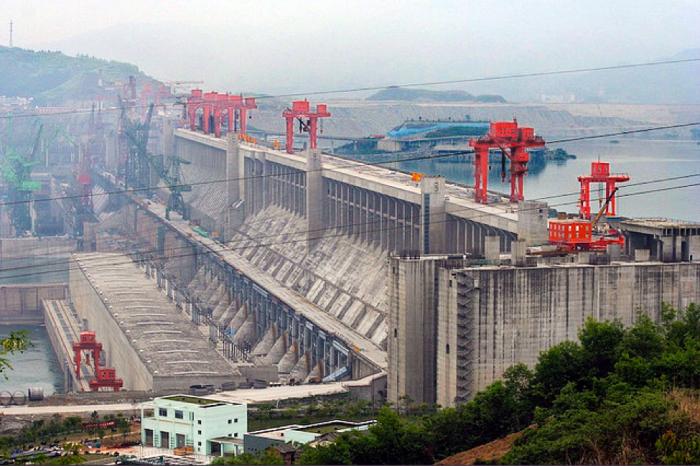
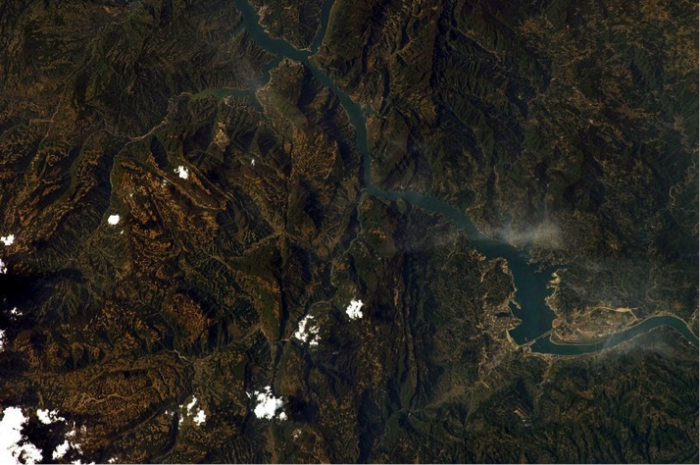
Bringing Down the Dams
There are clear cases for which the decision to remove a dam is virtually unquestioned except perhaps for its historical significance, said dam having outlived its usefulness. However, most proposals for dam removal are controversial because such decisions must evaluate benefits of retaining the dam against benefits of removing it. Certainly, these are complex decisions because of the conflict between ethical, economic, and legal aspects.
Enhancement of Populations of Anadromous Fishes
Enhancement of Populations of Anadromous Fishes
Dam removal has become increasingly popular, particularly as regards enhancement of populations of anadromous fishes--salmon and steelhead in the western U.S. and shad, herring and other species in the eastern U.S. Figure 13 illustrates the dams that have been removed in the lower 48 states (Figure 14 expands the eastern U.S.) from 1936 to 2013 on the basis of data tabulated by American Rivers [26]. These dams have been removed largely to improve the ecological conditions of river systems and to allow migratory fish to pass unimpeded for spawning in the upper reaches of rivers. Dam removal is commonly cited as a way of increasing stocks of imperiled fishes (Chesapeake Quarterly: Those Dammed Old Rivers [27]), allowing them to spawn in rivers that have been inaccessible to fish migration for as much as a century. Others argue that dam removal from coastal rivers is only part of the solution for fisheries improvements. Although numbers of anadromous fish may increase, the size of individual fish may not as long as fishing pressure remains the same (Oregon State University: Department of Fisheries and Wildlife [28]). This has been argued in the case of Elwha Dam removal in the Olympic National Park watershed (Crosscut: Elwha dams: Will bringing down NW dams really help salmon? [29]). In some cases, the benefits will accrue to native Americans who formerly depended on fishing for their nutrition and livelihood.
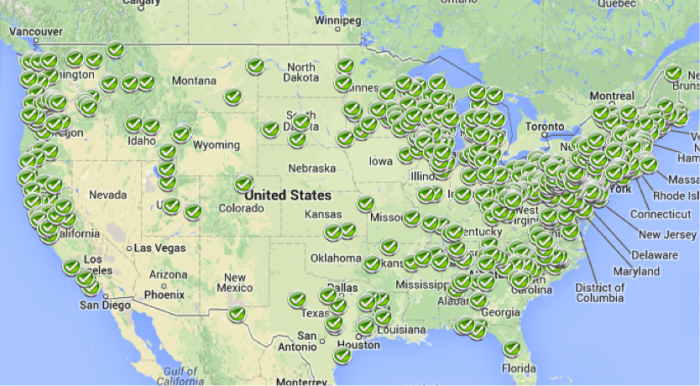
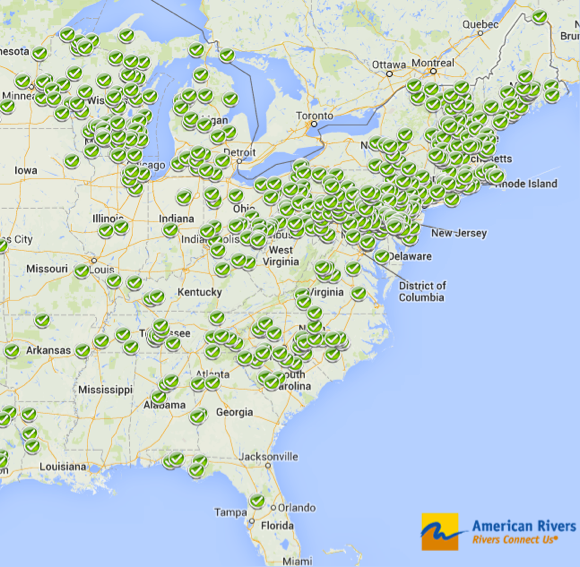
Esthetic Improvements
Esthetic Improvements
Arguments have also presented for esthetic improvements as the result of dam removal. An example of this approach is the argument for the removal of Hetch Hetchy (O'Shaughnessy) Dam on the Tuolomne River in the Sierra Nevada Mts. of California (Restore Hetch Hetchy [32]). This dam and its reservoir flooded a canyon much like Yosemite just to its south beginning in 1923, even though Hetch Hetchy was included in Yosemite National Park in 1890 by President W.H. Harrison. President Wilson, in 1913, signed the Raker Act that allowed San Francisco to dam the valley. Proponents of this dam removal argue for ecological improvements as well as access to once-spectacular scenery eliminated as the result of the water project. Hetch Hetchy provides some 20 percent of hydroelectric power generation to San Francisco as well as significant water supplies. Nonetheless, proponents of the dam removal argue that impacts on water or electrical power availability would be minor (Hetch Hetchy Today [33]).
Issues Accompanying Dam Removal
Issues Accompanying Dam Removal
One of the issues accompanying dam removal is the potential impact of the large volume of sediment that accumulated behind some dams over time. This so-called "legacy sediment" is commonly very fine-grained and contains stored nutrients and organic matter, among other possible pollutants. When dams are destroyed, efforts must be made to avoid a large flux of this sediment downstream as the newly released river cuts down to its natural base level. This requires careful engineering and significant funding. Merritts and Walter (2010) have suggested that most rivers and streams in eastern Pennsylvania and Maryland run through floodplains and levees of legacy sediment, not natural river valleys, created by the plethora of small dams built to impound water for hydropower in the past. And, even now, some large dams serve as a buffer against sediment transport that would create broad mudflats and high turbidity in coastal bays such as the Chesapeake Bay. Conowingo Dam in Maryland is one such structure that is estimated to trap as much as 50% of the sediment carried by the Susquehanna River before it empties into the Chesapeake Bay. There are concerns that this dam only has a bit more than a decade of useful life before it is filled to the brim with sediment, thus imperiling Chesapeake ecosystems (Langland, USGS, 2012). For an example of the engineering and costs of removing a dam, check out the San Clemente Dam Removal & Carmel River Reroute Project [34] in central California.


Many dam removal projects are proposed, but await funding from federal sources—Congress must appropriate funds. Projects on the Snake River and the Klamath River in the west remain controversial, but at least in the case of the Klamath, the Department of the Interior has recommended removal to allow salmon to reinhabit this river. Figure 9 illustrates the consequences of waiting for funding of dam removal using the Olmstead Dam example.
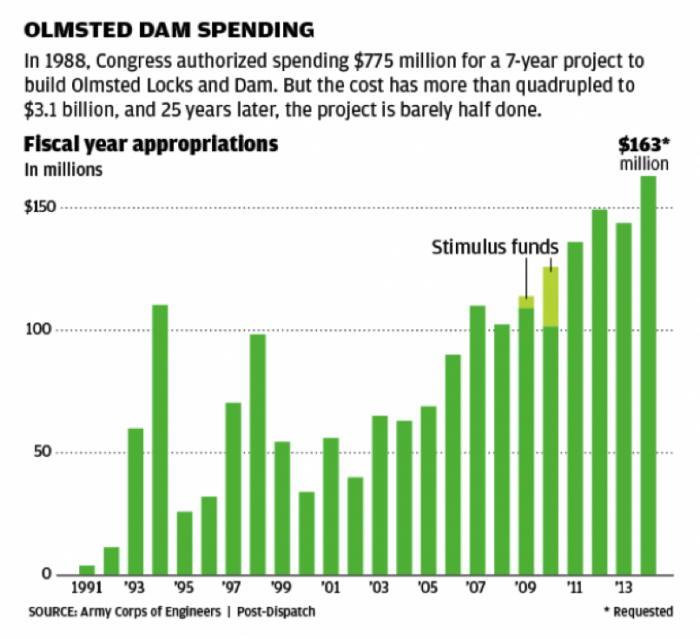
In 1988, Congress authorized spending 775 million dollars for a 7-year project to build Olmsted Locks and Dam. But the cost has more than quadrupled to 3.1 billion dollars, and 25 years later, the project is barely half done.
| Year | Funds in millions |
|---|---|
| 1991 | 5 |
| 1993 | 60 |
| 1995 | 35 |
| 1997 | 70 |
| 1999 | 55 |
| 2001 | 60 |
| 2003 | 70 |
| 2005 | 75 |
| 2007 | 115 |
| 2009 | 115 + 5 in stimulus funds |
| 2011 | 140 |
| 2013 | 145 |
| 2014 | 163 |
The Future of Dams: Developing Nations
The Future of Dams: Developing Nations
As may be evident from a re-examination of Figure 1 above, the era of major dam building is winding down, at least in the U.S. This is primarily because the best sites for large dams are now already being used; and because the impacts are more widely understood and, as a result, proposed dam construction projects face major challenges from environmental groups. Construction of large dams (defined as those higher than four stories) in North America and Europe peaked in the 1970’s - and the average age of the worlds large dams is 35 years. Nonetheless, in parts of the world, mainly in developing nations in Africa, Asia, and South America, there is substantial untapped potential for hydroelectric power.
During the 1900s, in the so-called “golden age” of dam building, one large dam was commissioned somewhere on Earth every day (World Commission on Dams, 2000). On the one hand, dams are effective and powerful tools for water distribution and management, power generation, and flood control - and thus indirectly facilitate economic development, food production, and industrialization. Indeed, major dams are often viewed as symbols of modernization and progress - although a work of fiction, you may recall this quote from the movie “O Brother Where Art Thou”, as the protagonist, Ulysses Everett McGill, and his sidekicks are saved by the onset of a flood:
“Out with the old spiritual mumbo jumbo, the superstitions, and the backward ways. We're gonna see a brave new world where they run everybody a wire and hook us all up to a grid. Yes, sir, a veritable age of reason.”
Human Intervention in the Global Water Cycle
Human Intervention in the Global Water Cycle
On the other hand, as discussed above in Ponding the Waters: Impacts of Dams, the effects of large-scale alteration of river systems and the hydrologic cycle have become increasingly clear in the past few decades. The scale of human intervention in the global water cycle is also becoming apparent, including restriction of river flows such that they no longer reach the ocean in many years, associated two- or three-fold increases in the residence time of runoff, decreased sediment delivery to the oceans, and a long-term measurable effect on global sea level caused by the impoundment of thousands of cubic km of water (Vörösmarty et al., 2004). As a result, new large dam projects have been heavily scrutinized and faced political and environmental opposition. At the same time, the efficiency and economics of energy production, and the net offset of greenhouse gas emissions from increased hydropower generation have been increasingly questioned (World Commission on Dams, 2000). One way to minimize environmental impacts is to design “run of the river” systems, in which no reservoir is created and instead the natural flow of the river in its channel is harnessed to generate power. However, these systems have several drawbacks: they rely on natural flows, so the power generating capacity fluctuates dramatically as a function of seasonal rainfall patterns and climate change; and there are no added benefits of flood control or water supply.
Dams and Economic Development
Dams and Economic Development
Despite the controversy, in many developing nations, major dam projects remain important engines for economic development and hold substantial potential for renewable energy generation. As of 2012, hydroelectric power constituted as much as 16.5% of global electricity production (and 75% of estimated renewable energy generation) (REN21, 2013). Of this, ~23% is in China, ~12% in Brazil, ~10% in Canada, and ~7.5% in the United States; combined, these four nations generate over half of the world's hydropower!
Moreover, globally, estimates suggest that up to two-thirds of economically viable dam sites have yet to be exploited. Undeveloped sites are especially abundant in Latin and South America (79% of renewable water remains unused), Africa (96%), India and China (48% is unused in Asia) (UNEP, 2013). Rapidly growing energy demand in India, China, and the Amazon Basin have driven the construction of hundreds of large dams as of 2002 (Figures 10-11; Table 1). This development may be a harbinger of things to come on the African continent. Africa has the second-highest population (after Asia), and the fastest-growing (See Module 1.3); it also has the lowest per capita energy use (UNEP, 2013). Looking to the future as demand for energy, water, and food in developing nations continue to grow – both per capita and in total as populations swell - it seems inevitable that demand for large dams will persist well into the 21st century.
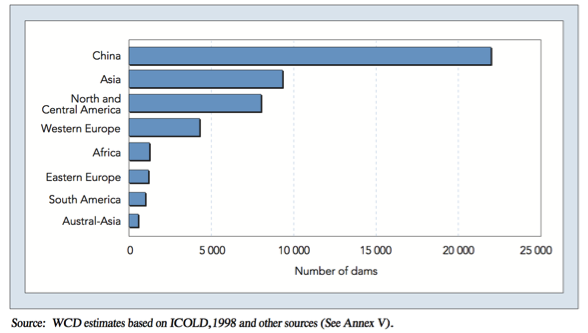
| Region | Number of dams |
|---|---|
| China | 22000 |
| Asia | 9000 |
| North and Central America | 8000 |
| Western Europe | 4000 |
| Africa | 1000 |
| Eastern Europe | 1000 |
| South America | 800 |
| Austral-Asia | 500 |
| Country | Number of Dams | Purpose |
|---|---|---|
| India | 695-960 | Irrigation, multipurpose |
| China | 280 | Flood control, irrigation, power |
| Turkey | 209 | Water supply, hydropower |
| South Korea | 132 | Irrigation, hydropower, flood control |
| Japan | 90 | Flood control |
| Iran | 48 | Irrigation, multipurpose |
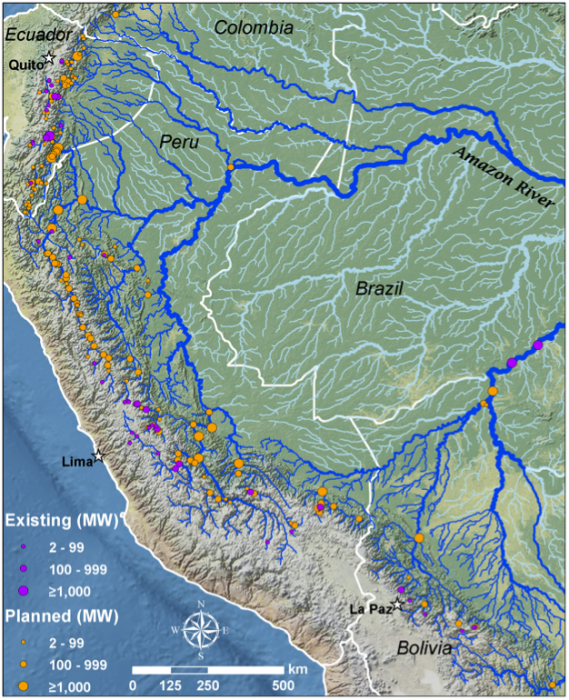
Summative Assessment: Dam Debate
Instructions
We will build upon the online module content and written assignments for the Aswan High (Nile River), Three Gorges (Yangtze River), and Glen Canyon (Colorado River) Dams, and hold three in-class debates centered on the positive and negative impacts of each of three well known large dams. Students will break up to form small teams (2-3 members each) for each position (pro and con) for each of the three dams. At the end there should be 6 teams of 2-3 students, each taking the "pro" or "con" side on one of the dams. Each team will present their arguments in a format detailed below that allows for an exchange of views.
Thinking About Systems
Note that dammed rivers are complex systems, with many interlinked processes occurring up and down stream. When considering building a dam, all of these combined processes must be considered at once, making this a very tricky issue. Although you are trying to make a clear case for or against damming a river in the debate, resist the temptation to over-simplify the issue. Instead, force yourself to delve into the cascade of consequences building or not building a dam could have for a region - including agriculture, industry, energy, public health, etc.
Details
- Each team will have the opportunity to present their primary argument(s) [8 minutes].
- The arguments will be followed by a rebuttal [6 minutes].
- At the conclusion of each of the debates, the rest of the group will render their “opinions”.
- At the end of the class period, we will tally and discuss the outcomes.
We will consider a scenario in which the Three Gorges, Aswan High, and Glen Canyon Dams have yet to be built.
- Choose one of the three dams. Take a position for or against its construction, and develop the arguments to support your position. Draw upon the written assignments you completed as part of the online module.
- Your arguments and supporting material should reflect a clear understanding of the feedbacks between processes in the river system, and how dam construction would alter them. If your group is “against” dam construction, you’ll need to explain the negative aspects of disruption of the system. If your group is “for” dam construction, you’ll need to be ready to articulate and evaluate the effects of dams on inter-linked components of the river system, and construct arguments that weigh these against the benefits of dams.
- For whichever position you choose, articulate a plan to address the issues that you anticipate will arise if your course of action is adopted [i.e. be prepared to present a rebuttal of the opposing team’s arguments]. For example, if you argue against the Three Gorges Dam, how would you handle issues of flood control and potential loss of life and property? Would you attempt to offset the non-renewable energy generation that would replace hydroelectric power? If you argue for it, how would you address the range of environmental impacts?
- Prior to coming to class, prepare a one-page note sheet with factual information derived from the module and external reading (see References at the end of the Module) that you can use to support your argument. Be sure to include the source of each piece of information in case you are challenged!
- As an observer of other groups' debates, write a brief opinion (~1/2 page) with your “judgment” or “vote” on each of the debates you were not involved in. In each debate, which team convinced you of their position, and which arguments swayed you most? Do these apply to all large dam projects, or just those discussed in the debate?
Deliverables
1 page fact sheet (with references) supporting your argument
~1/2 page judgement or vote paper explaining which team made a stronger argument in each of the other two debates
Submitting Your Paper
Turn in your papers at the end of class.
Grading and Rubric
A scoring rubric will be provided by your instructor.
Module 6: Groundwater Hydrology
Module 6: Groundwater Hydrology
Overview
In this two-part module, we will focus on the occurrence and movement of groundwater. Key topics will include an overview of aquifer types and nomenclature, and the physical properties and processes that govern the storage, transport, rate of flow, and budgets of water in these systems. In addition, we will examine some examples of large-scale aquifer systems in the U.S., including those underlying the Valley & Ridge province and in the semi-arid American West. The module has two parts and is designed as a two-week course. The first section (Module 6.1) focuses on aquifers and their properties, with a series of case studies that outline the geometry and geology of highly-used regional aquifers. The second section (Module 6.2) focuses on the dynamics of aquifers, including the driving forces for water movement, flow rates, flow to pumping wells, and water budgets.
6.1 Aquifers and Properties
6.1 Aquifers and Properties
In the first part of this module, we will focus on the properties of aquifers: What characteristics of a rock or sediment make it a good aquifer? What are the different kinds of aquifers? Fundamentally, the ability to store and transmit water are the two key ingredients that make a subsurface geological formation useful as an aquifer. In Module 6.1, we will explore the detailed physical properties of rocks and sediments that ultimately affect the storage and movement of groundwater. We'll also illustrate with a series of well-known examples of large aquifers tapped for drinking, industrial, and agricultural uses.
Goals and Objectives
Goals and Objectives
Goals
- Explain the distribution and dynamics of water at the surface and in the subsurface of the Earth
- Interpret graphical representations of scientific data
Learning Objectives
In completing this lesson, you will:
- Identify the properties of artesian wells and describe the conditions under which they form
- Explain the difference between porosity and permeability
- List and describe the properties of aquifers that control the movement and storage of groundwater
- Explain the role of fractures in determining the transmission properties of aquifers
- Use Darcy's Law to explain the roles of aquifer properties and driving forces in governing the rate of groundwater flow
Aquifers Explained
Aquifers Explained
Aquifers come in many shapes, sizes, and “flavors”. For example, some aquifer systems span hundreds – or even thousands – of kilometers across several states or nations and may include multiple individual layers of rock or sediment that total thousands of meters in thickness. Other aquifers may be restricted to a few kilometers within a stream valley, and be only a few meters thick.
Nonetheless, there are some important common features of different kinds of aquifers. In this section of the module, we provide a basic overview of aquifers: What is an aquifer? What are the different types of aquifers, and what is their anatomy?
Overview and Nomenclature
Overview and Nomenclature
Aquifers are geologic formations in the subsurface that can store & transmit water (Figures 1 and 2). As we will see later in the section titles Basic Aquifer Properties, there are specific rock and soil properties that govern these two functions. Adequate storage requires that there be sufficient void space between particles, in fractures, or generated by compressing the aquifer under pressure, to provide usable quantities of water. Adequate transmission requires that the void spaces where water occurs be well enough connected that it can percolate or flow under either natural or pumping-driven conditions, at a rate that will support sustained use.
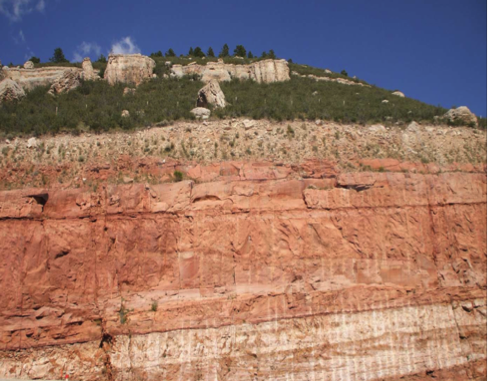
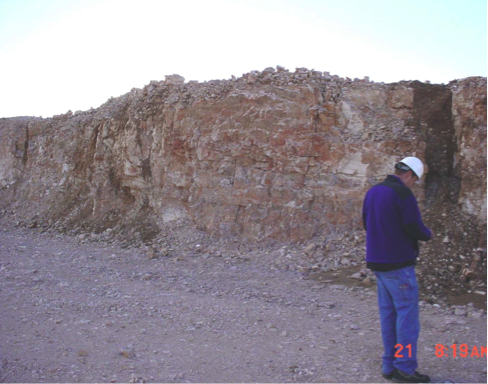
These definitions are intentionally vague because they depend on the scale of intended use. For example, an aquifer that provides water for a large city will need to sustain higher pumping rates at wells (on order of tens of thousands of gallons per minute) than one that provides for a single-family (a few to perhaps ten gallons per minute). For reference, Penn State University relies almost exclusively on groundwater pumping for its water supply at the University Park campus, with a total extraction of ~2.5 million gallons per day (about 1750 gallons per minute) distributed among several pumping well fields.
In contrast to an aquifer, an aquitard, often also termed a confining layer or aquiclude, is a geologic formation in the subsurface that does not transmit water effectively – and therefore acts as a barrier to groundwater flow. In general, aquifers are usually composed of sediments or sedimentary rocks with grain sizes larger than fine- to medium sand (>~125 µm diameter), or of fractured rock. Aquitards are typically composed of fine-grained sediments or sedimentary rocks or those in which the pore spaces have been filled by mineral cements (silts, siltstones, shales, clays, cemented sandstones, or unfractured limestones).
Aquifer Anatomy
Aquifer Anatomy
In the simplest sense, you might imagine an aquifer formation that may be covered by a veneer of soil, and which extends downward from a few feet below the surface for several tens or even hundreds of feet (Figure 3). At some depth below the land surface, the interstices between soil or sediment particles, or the fractures in the rock, will be water-filled or saturated. Shallower than that depth, these interstices, or pore spaces, will be filled with air, water vapor, and some liquid water bound to the surfaces of the rock (Figures 3-5). This zone is the unsaturated zone, also known as the “zone of soil moisture” or the vadose zone. The water table marks the top of the ground water system and is formally defined as the depth at which the pressure in the subsurface is equal to the atmospheric pressure. Immediately above the water table, there is a narrow zone of saturation termed the capillary fringe. In this zone, water is wicked upward in pore spaces due to capillary forces. This is analogous to capillary tube experiments you may have seen or performed in physics or chemistry classes in high school; it occurs due to interaction between the polar water molecule and the surfaces of the solids, and is directly related to the fact that water has a surface tension (as you may remember from Module 1!). In the capillary fringe, pores are saturated, but pressures are sub-atmospheric, meaning that the water is under suction as it is pulled or wicked upward. The nomenclature “fringe” reflects the fact that slight variations in grain size lead to variations in the height that water is drawn (again, think to the capillary tube experiment, and effects of different tube sizes) (Figure 5).
Any precipitation or surface water that infiltrates to the water table must percolate through the vadose zone in order to recharge the aquifer. As we will see later in this module infiltration and recharge typically constitute only a small fraction – rarely more than 10% - of precipitation, because most water that falls in events is returned to the atmosphere by transpiration or evaporation, becomes runoff (i.e., if the capacity for infiltration is exceeded by the rate of precipitation), or is bound by soils in the vadose zone.
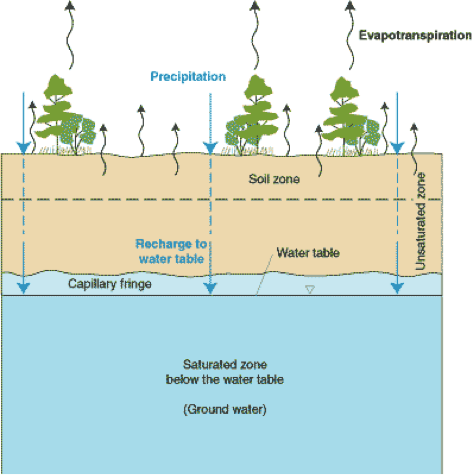
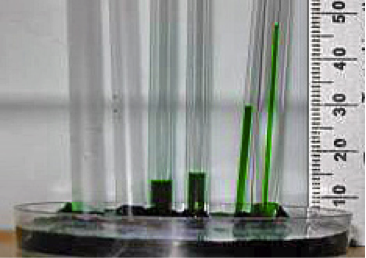
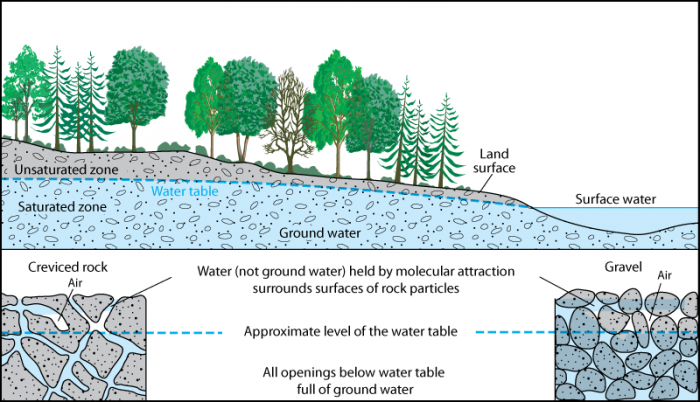
Water (not ground water) held by molecular attraction surrounds surfaces of rock particles. All openings below the water table are full of ground water. The Unsaturated Zone is on the land surface and above the water table which contains the saturated zone, surface water, and ground water.
Types of Aquifers
Types of Aquifers
In more detail, there are three main classifications of aquifers, defined by their geometry and relationship to topography and the subsurface geology (Figures 6-9). The simple aquifer shown in Figure 6 is termed an unconfined aquifer because the aquifer formation extends essentially to the land surface. As a result, the aquifer is in pressure communication with the atmosphere. Unconfined aquifers are also known as water table aquifers because the water table marks the top of the groundwater system.
A second common type of aquifer is a confined aquifer, which is isolated from pressure communication with overlying or underlying geologic formations – and with the land surface and atmosphere – by one or more confining layers or confining units. Confined aquifers differ from unconfined aquifers in two fundamental and important ways. First, confined aquifers are typically under considerable pressure, which may be derived from recharge at a higher elevation or from the weight of the overlying rock and soil (known as the overburden). In some cases, the pressure is high enough that wells drilled into the aquifer are free-flowing. This condition requires that the water pressure in the aquifer is sufficient to drive water up the wellbore and above the land surface, and such wells are called artesian wells (Figure 7). Second, confined aquifers typically remain saturated over their entire thickness, even as water is removed by pumping wells. Water extracted from the aquifer comes only from the depressurization of the aquifer – a combination of depressurization and expansion of the water itself, and relaxation of the aquifer formation upon reduction in pressure (Figure 8).
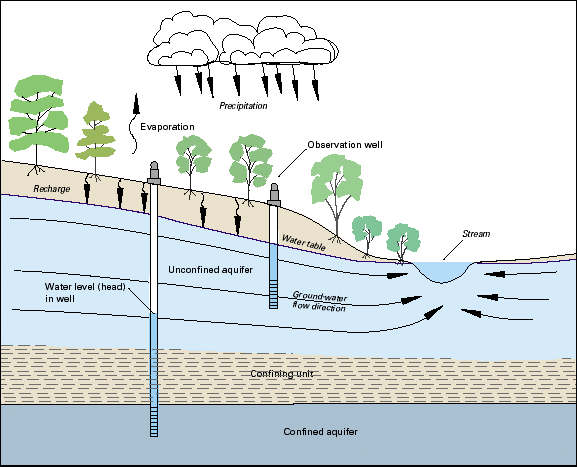
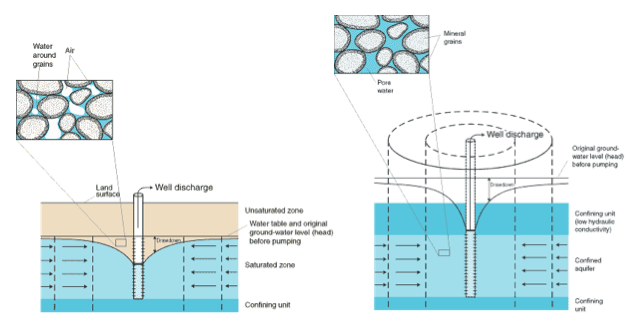
The third main type of aquifer is a perched aquifer (Figure 6). Perched aquifers occur above discontinuous aquitards, which allow groundwater to “mound” above them. Thee aquifers are perched, in that they sit above the regional water table, and within the regional vadose zone (i.e. there is an unsaturated zone below the perched aquifer). The dimensions of perched aquifers are typically small (dictated by climate conditions and the size of aquitard layers), and the volume of water they contain is sensitive to climate conditions and therefore highly variable in time.
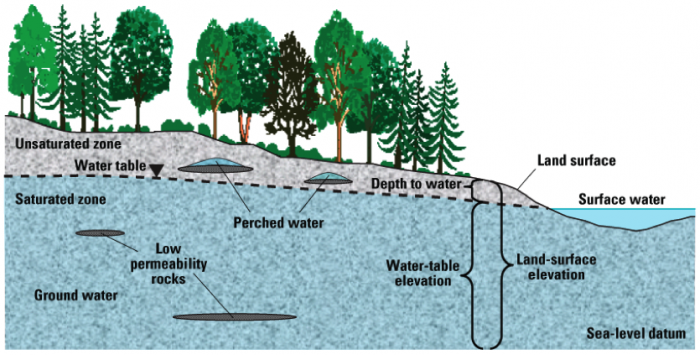
Aquifer Properties
Aquifer Properties
In the previous section, you’ve learned about the different types of aquifers, and the basic characteristics that define an aquifer – namely the ability to store and transmit water. But what, exactly, about a rock or sediment beneath the ground determines whether the rock can hold water, or whether water can percolate through it? In the following section, we will explore this question in more detail, to define the important individual properties of the rock.
Storage
Porosity (usually denoted by the symbol η, which is Greek letter 'eta') is the primary aquifer property that controls water storage, and is defined as the volume of void space (i.e., that can hold water in the zone of saturation) as a proportion of the total volume (Figure 10).
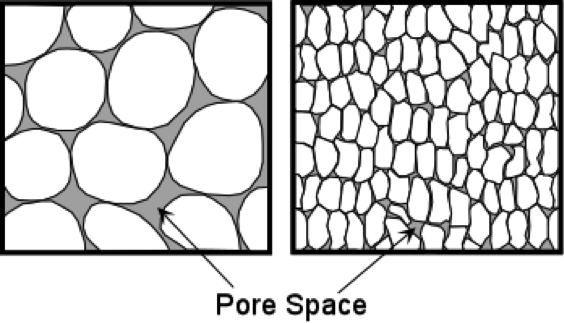
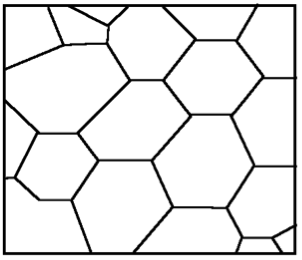
Porosity is expressed as either a fraction, or a percentage:
, or if reported as a percentage,
For aquifers composed of sedimentary rocks or sediments, porosity is usually in the range of ~10-35%. For unfractured crystalline rock, porosity is quite a bit lower - on order of a few percent - because there is little porosity between individual grains other than the vary narrow interfaces along their boundaries (Figure 10).
Several factors can affect porosity. In sedimentary rock and sediments, controls on porosity include sorting, cementation, overburden stress (related to burial depth), and grain shape. Poorly sorted sedimentary deposits, in which there is a wide distribution of grain sizes, typically have lower porosity than well-sorted ones (Figure 11). This is because the finer particles are able to fill in spaces between the larger grains. Cementation caused by precipitation of minerals (typically calcium carbonate or silica) at grain boundaries also reduces porosity (Figure 11). Angular grains generally allow more efficient packing of particles than rounded or spherical ones, also leading to slightly lower porosity. Finally, the more deeply sediments or sedimentary rock are buried, the larger the weight of the overburden; the higher stress leads to compaction, tighter packing of the grains, and lower overall porosity.
Secondary processes that act on the rock or sediment after its formation, primarily weathering by physical or chemical mechanisms, can also affect porosity. Physical weathering by wind or water movement can remove fine clay-sized particles from the sediment (a process termed winnowing), leading to increased porosity near the Earth’s surface. Chemical weathering of certain rock types can lead to clay and oxide formation; depending on the environment and initial composition of the aquifer grains, the clays and oxides may subsequently be removed (porosity increase), or they may grow at the boundaries of other particles and reduce the porosity.
In fractured rock (whether fractured crystalline or cemented sedimentary rock), porosity is typically ~2-5%. The pore space is almost entirely composed of the fractures or cracks themselves, which are typically a millimeter or less in aperture (Figure 12). Two primary factors control porosity – and the connectedness of porosity – in fractured rock. First, increased stress, related to the depth of burial and the weight of the overburden, exerts a clamping force that causes the closure of cracks or fractures (decreases fracture aperture). In some types of rock – most notably limestones – chemical weathering occurs via dissolution as water flows along and through fractures. This leads to increased fracture aperture. Significant enlargement of fractures can lead to the development of karst, typified by large open fractures, caves, and caverns, as well as sinkholes and hummocky topography that ensue as the underlying rock is gradually dissolved (Figure 13).
Interestingly, grain size does not affect porosity. For example, consider a box filled with spherical particles packed as tightly as possible. The proportion of empty space (porosity) would be the same whether the particles are marble-sized, pea-sized, or golf ball-sized; the porosity is controlled entirely by the geometry of the particles – not their dimensions. As we’ll see in the next section, however, grain size does strongly affect the ability of aquifers to transmit water because it directly controls the size of the pore spaces where the water percolates. For example, unconsolidated clays (grain sizes of a few to tens of microns) commonly have porosities of over 50-60%, but they transmit water only one-thousandth to one millionth as well as sands with porosities of 20-30% (grain sizes of a few hundred microns).
Specific Yield (denoted as Sy) is another important quantity for water storage in unconfined aquifers. Sy is defined as the proportion of water occupying void spaces that drains under gravity. Because some water is bound, or adsorbed, to the aquifer particles or fractures, the specific yield is always lower than the porosity (take a look at Figure 8 [42], inset at top left). The attraction between water molecules and the aquifer is due – you guessed it! – to the polar nature of water and surface tension. In sands and fractured rock, Sy is typically a large fraction (>90%) of the porosity, whereas in fine-grained sedimentary deposits Sy may be as low as a few percent because the surface area interacting with water molecules is higher, and pores are smaller, allowing the aquifer to retain more water. In unconfined aquifers, Sy controls the amount of water that can be extracted by pumping.
In confined aquifers, the compressibility of the aquifer is the dominant control on water storage and release. As described above (see Figure 8, right panel), when water is extracted from confined aquifers by pumping or flow to natural springs, the aquifer remains saturated, but the water pressure decreases. Upon depressurization, the aquifer itself can compress slightly. If water is recharged or injected, the opposite occurs: pressure increases and the aquifer expands very slightly. Essentially, by increasing water pressure, more water mass is being “crammed” into the pore space in the aquifer, and vice versa. Although exaggerated, one way to visualize this is to think of pores in the rock or aquifer as a juice box. By changing the pressure inside the box, it will expand or contract. In the same way that a soft juice box will deform more than a stiff one for a given change in pressure, a more compressible aquifer will yield more water than a stiffer aquifer, for the same depressurization. The storage of water in confined aquifers is termed the specific storage, and reported in units of Volume of water/Volume of aquifer per change in water level (so the units are 1/length; e.g., 1/m or 1/ft).
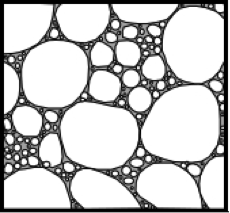
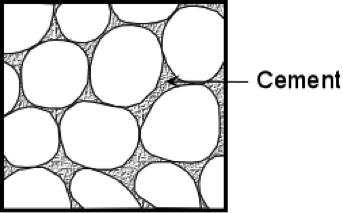
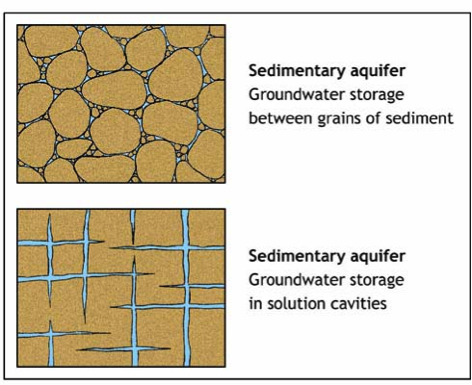
Sedimentary aquifers with intergranular porosity have groundwater storage between grains of sediment. Sedimentary aquifers with fracture porosity have groundwater storage in solution cavities.
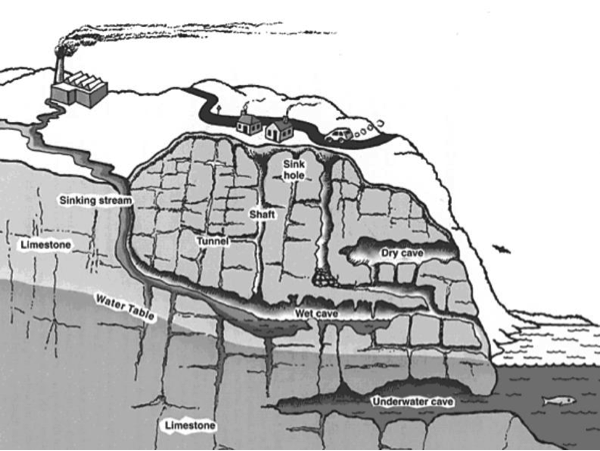
Transmission
Transmission
The ability of an aquifer to transmit water – or of an aquitard to slow the flow of water – is the second essential ingredient controlling groundwater movement. It is also the most variable in natural materials; distances in astronomy are the only other quantity in nature that varies over a similar range! For example, the difference in groundwater flow rate for shale vs. gravel is a factor of 1,000,000,000,000 (yup…one trillion). That’s the difference between the size of an iPhone and the distance from the Earth to the Sun.
Groundwater transport properties are described by two related quantities. Hydraulic Conductivity, denoted by K, is a measure of the ability of a particular fluid (usually water) to flow through the rock or sediment. Permeability, denoted by a lower-case k, is often also termed “intrinsic permeability” and describes the ability of the geologic formation alone to transmit fluid. Although related, the key difference is that hydraulic conductivity combines properties of the geologic formation and the fluid, whereas permeability describes only the rock properties. As described in Sidebar 1, the basic concept of hydraulic conductivity emerged from a series of ingenious experiments conducted in the mid-1880s by Henri Darcy, a French Engineer. These experiments led to Darcy’s Law, which forms the foundation for much of modern hydrogeology and petroleum engineering.
To illustrate the difference between K and k, consider the sandstone in Figure 14 below. The sandstone itself has a permeability, which is controlled by the size of the grains and pore spaces through which water can percolate, and the connectedness and geometry of the pores (more on that in a moment!). That permeability is a characteristic of the sandstone, regardless of whatever fluid might be moving through it, the temperature, or anything else. But the flow rate of water through this sandstone will be different than for oil, or for air, or any other fluid. So the same sandstone also has a hydraulic conductivity specific to a given fluid of interest.
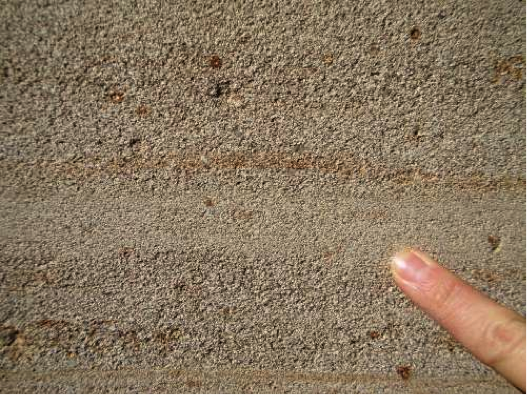
Viscosity and Density
Viscosity and Density
More specifically, it is the viscosity and density of the fluid that matter. More viscous fluids will flow more slowly through the same rock than less viscous ones. This is important for comparing different fluids (say, oil vs. water – whether you are thinking about an oil reservoir or contamination of groundwater by a gasoline spill). It is also important in considering the effects of temperature, because water viscosity decreases with increasing temperature: it’s less than half as viscous at 90° than at 32° F. So even for the same aquifer, the hydraulic conductivity goes up if it is warmer! This makes some sense – if the water is less viscous (i.e. “thinner”), it will flow more easily through the aquifer.
So…that’s how we define permeability and hydraulic conductivity. But what controls their magnitude? The main factors are grain size and shape, sorting, porosity (degree of compaction or fracture aperture), particle orientation or alignment that affects the tortuosity of the flow path, and cementation. Tortuosity is a measure of how far fluid must go to “circumnavigate” its way around particles: higher tortuosity indicates that water must go farther to get to its destination (a more tortuous path). For all of these mechanisms, the key underlying control on groundwater movement is the viscous resistance resulting from the interaction of the fluid with solid surfaces in the aquifer (grain edges or fracture walls).
Importance of Fractures
Importance of Fractures
Fractured aquifers are one important and widely used class of aquifer because they are commonly both highly permeable and rapidly recharged. For example, groundwater recharge to the limestone aquifer beneath Nittany Valley in the Spring Creek watershed is around 30-45% of the annual precipitation (in comparison to typical recharge of <10% of precipitation). Fractured aquifers are permeable despite their overall low porosity (usually <5%) because natural fractures usually form in consistent orientations and are well connected in networks over hundreds of meters to tens of kilometers or more (Figures 15-16). The preferred orientation of major fractures leads to anisotropy in permeability, in which the aquifer may be more permeable parallel to the dominant fracture directions than in other orientations.
The rapid flow rates and direct pathways for recharge from the land surface also lead to concerns specific to fractured aquifers. In the absence of confining layers or thick soils, rapid recharge along fractures that extend to or nearly to the land surface increase vulnerability of contamination by surface activity, including fertilization of fields, pesticide application, or spills. Direct connections between surface water bodies and groundwater through major fracture systems also increase the potential for water-borne pathogens to enter the groundwater system, especially during periods of high flow or if confining layers along stream beds are breached. Compounding this risk, if contamination does occur, flow along fracture networks can be very rapid and the direction and rates of contaminant transport difficult to predict - unless the fracture network in the subsurface is extraordinarily well known, which is rarely the case. Because of their potential for contamination, fractured aquifers are a subject of highly active research, including dedicated large-scale field programs (e.g., check out the U.S. Geological Survey’s Mirror Lake project [44]).
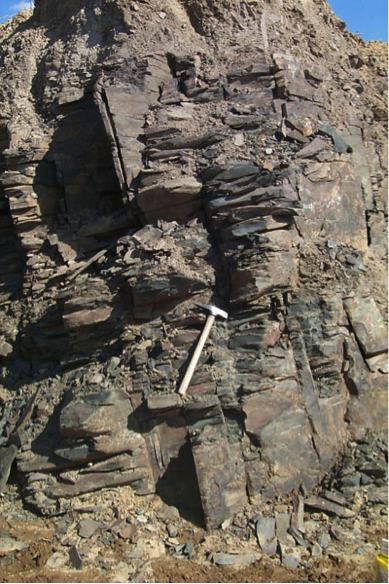
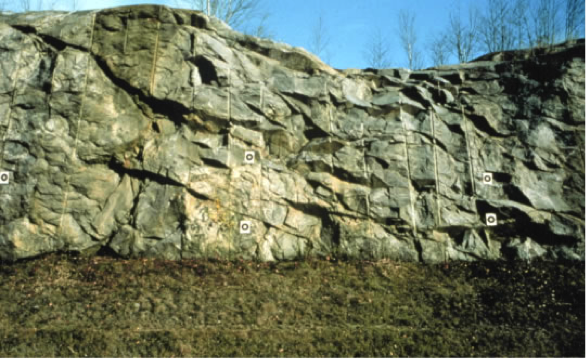
Regional Aquifer Systems: Examples
Regional Aquifer Systems: Examples
Ground water flow systems extend over a wide range of scales, from small perched aquifers that may supply water for a single-family, to regional rock formations that span thousands of km and cross several states (Figure 18). These regional systems supply water for irrigation and domestic uses in many areas, especially in semi-arid and arid parts of the American West and coastal population centers along the East coast (remember Module 1, figures 10-12?). These regional systems commonly consist of several layered sedimentary formations and may extend to several kilometers in depth. The U.S. Geological Survey has compiled detailed studies of regional aquifer systems across the U.S., with useful information about climate, recharge, subsurface geology, use, and problems related to water quality or quantity (a list and links for each of the principal regional aquifers in the U.S can be found at USGS Groundwater Information [46]. A detailed atlas with information about the major aquifer systems in particular regions of the U.S. can be viewed at USGS Ground Water Atlas of the United States [47]. In this module, we will focus on a few example regional aquifer systems of particular relevance to the Northeastern and mid-Atlantic U.S. and the Central Valley of CA.
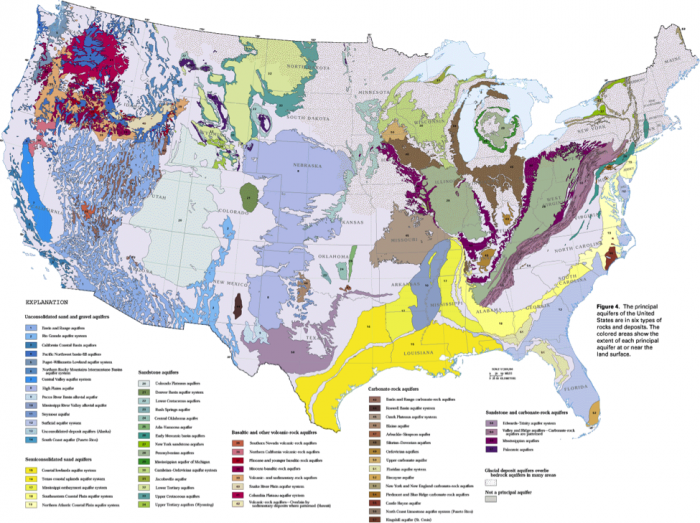
Valley and Ridge Aquifer System
Valley and Ridge Aquifer System
The Valley and Ridge aquifer system extends SW-NE across Central PA, West VA, and VA (Figure 19, purple area), and is the main water supply for much of this region. It is composed of layered Paleozoic sedimentary strata (shales, sandstones, and limestones) that were folded and deformed by a series tectonic collisions over 200 million years ago. The modern valleys in the Valley and Ridge province have formed where limestone, which is most susceptible to erosion, was exposed in the core of anticlines, or upfolds (Figure 20). The more resistant sandstones and shales form the regional ridges, like Mt. Nittany and Bald Eagle Ridge.
The principal aquifer unit in this system is the fractured limestone that underlies the valleys. As noted above, because it is fractured, it recharges rapidly, has a high fracture permeability, and wells drilled along the fractures are highly productive (c.f. Figure 17). Recharge is focused on the flanks of the ridges, where runoff flows over the less permeable shale and sandstone units and enters the groundwater through fractures or sinkholes above the limestone at the valley edges. Groundwater flow is generally toward the center of the valleys, and springs commonly feed the surface water systems. The water is characterized by a high hardness (Mg and Ca content; we’ll cover this in more detail in Module 7), derived from limestone dissolution. Dissolution of the limestone has formed extensive karst features (caves, caverns, sinkholes) throughout the region.
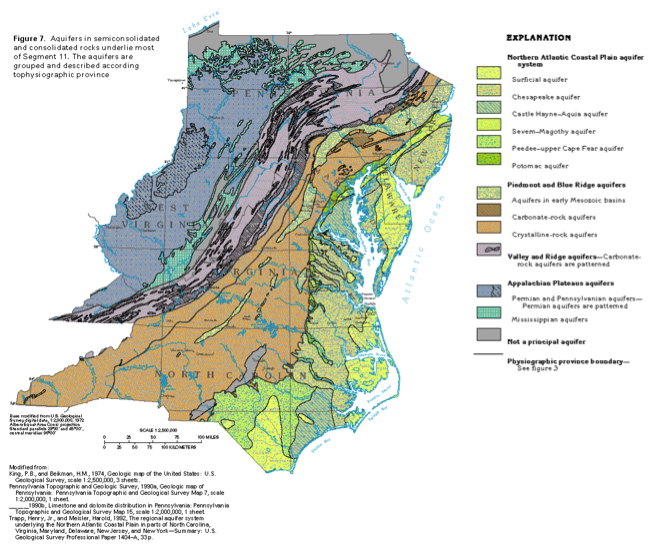
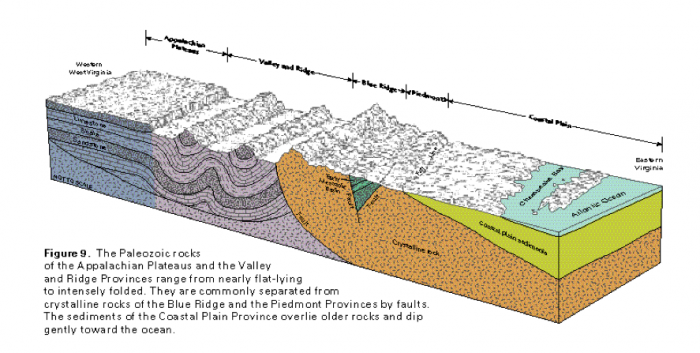
The Paleozoic rocks of the Appalachian Plateaus and the Valley and Ridge Provinces range from nearly flat-lying to intensely folded They are commonly separated from crystalline rocks of the Blue Ridge and the Piedmont Provinces by faults. The sediments of the Coastal Plain Province overlie older rocks and dip gently toward the ocean.
Atlantic Coastal Plain Aquifer System
Atlantic Coastal Plain Aquifer System
The Atlantic Coastal Plain aquifer system extends North-South along much of the Eastern portions of New Jersey, Delaware, Pennsylvania, Virginia, and North Carolina (Figure 19). It consists of a sequence of layered sedimentary aquifers (sands and gravels) separated by series of aquitards, all deposited starting around 100 million years ago and continuing today. The layers slope, or dip, to the East and extend offshore for tens of km beneath the continental shelf (Figure 21).
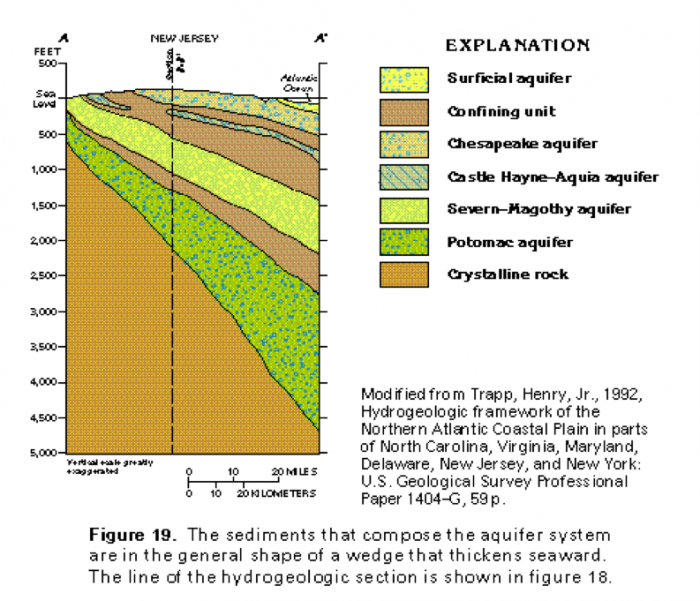
Recharge occurs by both natural and managed infiltration on land across much of the coastal plain; groundwater flow in the subsurface is mainly to the East along the sediment layers. One interesting consequence of this flow pattern is that there may be a sizable freshwater resource offshore that could be accessed by drilling in relatively shallow water on the continental shelf. During the last ice age, when conditions were substantially wetter than today and a nearly mile-thick ice sheet covered the northern extent of the aquifer system, recharge was probably even larger - and thus may have forced fresh water several tens of km offshore, where that “fossil” water may remain today!
The Atlantic Coastal Plain system is an important water source for domestic/municipal supply and industry in population centers throughout coastal North Carolina, Maryland, Virginia, Delaware, and New Jersey. However, concentrated, localized pumping has led to a reversal of flow direction (toward the wells instead of Eastward) in some of the aquifer units throughout the region. In addition to overarching concerns about the sustainability of withdrawals that exceed recharge rates, the flow reversal has led to local salt-water intrusion, whereby saline ocean water infiltrates the aquifer and in some cases renders it non-potable.
Central Valley/San Joaquin Valley Aquifer System
Central Valley/San Joaquin Valley Aquifer System
The Central Valley Aquifer system of Central CA lies in a large structural basin running approximately North-South, between the Coast Ranges to the West and the Sierra Nevada mountains to the East (Figure 22). The deep elongate basin is infilled with marine and continental sediments, primarily composed of interlayered sands and clays. The basin itself is formed by tectonic processes caused by East-West extension (these are the same forces that are causing continued uplift of the major mountain chains throughout the Basin and Range province of the Southwestern US, and which are one major control on orographic precipitation patterns in that region).
The continental deposits (Figure 22, orange) comprise the main aquifer units and range from one-half to over two miles in thickness. As is the case in the Valley and Ridge, the recharge is primarily focused around the valley perimeter as runoff over the flanks of surrounding high topography infiltrates and enters the groundwater system. Groundwater flow is primarily inward, toward valley center, with a component of flow down-valley to the North, parallel to surface water flow in the San Joaquin River.
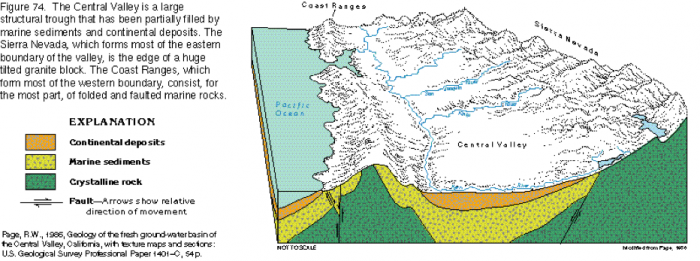

The thick sedimentary sequence has formed a vast expanse of flat topography on the natural floodplain of the San Joaquin River. This, in combination with a mild climate that allows a year-round growing season, has made the Central Valley one of the most productive and largest agricultural centers in the world. The Central Valley aquifer system is highly utilized, primarily to augment limited allocations of surface water for irrigation. Since the mid-1920s, groundwater withdrawals have generally outpaced natural recharge to the aquifer, leading to dropping water levels, irreversible aquifer compaction, and land subsidence (as will be discussed in more detail next week, in Module 6.2). Until recently, groundwater withdrawals were neither heavily monitored nor regulated. However, in the face of an ongoing multi-year drought, a new bill was signed into law in mid-September, 2014 that restricts pumping (See What to Know about California's New Groundwater Law [49]; see also New California Groundwater Pumping Rules Signed Into Law [50]). Shallow aquifer units in the valley are also plagued by a wide range of water quality concerns associated with irrigation and return flow of irrigation water to the aquifer via infiltration; these include leaching of selenium, boron, and other constituents from soils; salinization; and high concentrations of pesticides and fertilizers. We’ll discuss all of these issues in more detail in upcoming modules about water quality and the effects of climate change.
Darcy’s Experiments and Darcy’s Law
Darcy’s Experiments and Darcy’s Law
In 1855, Henri Darcy, a French hydraulic engineer (Figure 24), oversaw a series of experiments aimed to understand the rates of water flow through sand layers, and their relationship to pressure loss along the flow paths. Darcy’s experiments consisted of a vertical steel column, with a water inlet at one end and an outlet at the other. The water pressure was controlled at the inlet and outlet ends of the column using reservoirs with constant water levels (Figure 25) (denoted h1 and h2). The experiments included a series of tests with different packings of river sand, and a suite of tests using the same sand pack and column, but for which the inlet and outlet pressures were varied. For part of our in-class activity this week, we will perform our own set of “Darcy Tube” experiments, and also work with the original dataset generated by Darcy in his experiments.

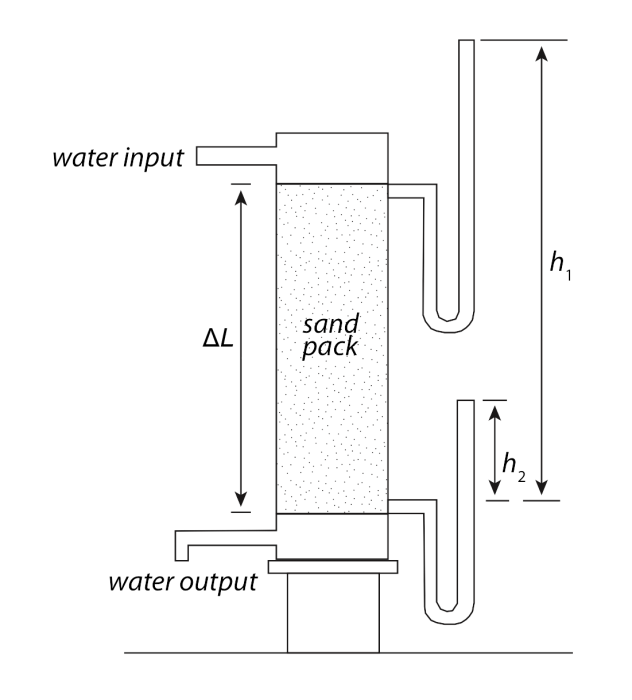
Darcy’s findings laid the foundation for the modern science of hydrogeology by quantifying the relationships between volumetric groundwater flow rate, driving forces, and aquifer properties. Specifically, Darcy’s experiments revealed proportionalities between the flux of water, Q, through the laboratory “aquifer” and different characteristics of the experimental system (refer to Figure 25 above):
(1) Q was directly proportional to the difference in water levels from inlet to outlet, h1 - h2 = Δh:
Q ∝ Δh
(2) Q was directly proportional to the cross sectional area of the tube:
Q∝ A
(3) Q was inversely proportional to the length of the column:
Q ∝ 1/ΔL
Combining these proportionalities leads to Darcy’s Law, the empirical law that describes groundwater flow:
Q = KA(Δh/ΔL)where K is a constant of proportionality that defines the water flux for a given hydraulic gradient (Δh/ΔL). The above equation can also be recast in terms of the water volume flux per unit area, Q/A (also called "Darcy flux" or "Darcy velocity" with units of length per time):
Q/A = K(Δh/ΔL)Note that in Darcy’s Law, the other terms all describe the driving forces or geometry of the experimental system; none of them would change if the sand pack in the tube were changed to gravel, silt, or another material. This is where the constant of proportionality, K, comes in: it describes the ability of the material in the column to transmit water (sound familiar?). Indeed, the constant of proportionality and hydraulic conductivity (also K) are one and the same! For example, consider the same experimental geometry, but with silt or clay in the tube rather than sand. The flow rate would be lower, and this would be described in Darcy’s Law by a smaller value of K.
6.2 Aquifer Processes and Dynamics
6.2 Aquifer Processes and Dynamics
In the first half of the module, we’ve explored the properties of aquifers. But, of course, that is only half of the story! In order for groundwater to flow, there must be a driving force. The same is true for surface water like streams or rivers: in that case, the driving force is gravity. In the case of groundwater, the driving force is a bit more complicated because it includes the combined effects of gravity and pressure.
As we will see, these driving forces are partly determined by the natural system but can be perturbed by pumping or injection in wells. When we pump water from wells, we alter the natural driving forces to move water toward the well. One important issue in aquifers is accounting for the flows in to and out of the aquifer in a groundwater budget. In extreme cases, the amount of water extracted at wells may exceed the amount introduced to the aquifer through recharge. As we’ll discuss, this tenuous condition is known as an overdraft.
Goals and Objectives
Goals and Objectives
Goals
- Describe the two-way relationship between water resources and human society
- Explain the distribution and dynamics of water at the surface and in the subsurface of the Earth
- Thoughtfully evaluate information and policy statements regarding the current and future predicted state of water resources
- Interpret graphical representations of scientific data
Learning Objectives
In completing this lesson, you will:
- Apply the concept of hydraulic head to draw flowlines on maps and cross-sections
- Interpret the current and historical balance between groundwater recharge and water extraction from well hydrographs
- Propose a course of action to address overdraft in an aquifer
Driving Forces for Groundwater Flow
Driving Forces for Groundwater Flow
The driving forces that control groundwater flow are a bit more complicated than those controlling flow in rivers and streams. As you learned in Module 3, surface water flows downhill due to gravity, and the flow direction is defined by the topography. Water flows downhill because gravity is a form of potential energy – and the water, or anything that falls or rolls downward – flows in response to differences in potential energy (from high to low).
In contrast to surface water, groundwater is separated from the atmosphere, and as a result, it can be under considerable pressure. Therefore, the potential energy that drives groundwater movement includes both pressure and gravity. In this section, you will learn about these driving forces, how we define them, and how they translate to the direction and rate of groundwater movement in the subsurface.
Potential Energy and Hydraulic Head
Potential Energy and Hydraulic Head
The flow of both surface water and groundwater is driven by differences in potential energy. In the case of surface water, flow occurs in response to differences in gravitational potential energy caused by elevation differences. In other words, water flows downhill, from high potential energy to low potential energy. In groundwater systems, things are a bit more interesting. Unlike surface water, which is in contact with the atmosphere and therefore rarely under pressure, water in groundwater systems is isolated from the land surface. This means that groundwater can also have potential energy associated with pressure. In extreme cases, water in confined aquifers may be under sufficient pressure to drive flow upward, against gravity. Artesian wells are one manifestation of this.
Fundamentally, groundwater and surface water are similar in that flow is in the “downhill” direction. But what does “downhill” mean in a groundwater system? To define the flow direction, we need to account for the two types of potential energy. Unfortunately, the potential energy of the water cannot be measured directly. However, we can measure a proxy for the potential energy by measuring the hydraulic head, or level to which water rises in a well (Figures 26 and 27). The hydraulic head combines two components: (1) potential energy contained by the water by virtue of its elevation above a reference datum, typically mean sea level; and (2) additional energy contributed by pressure. In a well, the value of hydraulic head represents the potential energy of the water at a particular point in three dimensions – at the depth where the well is open to the aquifer (Figures 26-27). This is analogous to a temperature reading taken at the tip of a thermometer, which provides a proxy for heat energy. Hydraulic head can be written as:
h = z + Ψ,
where z is the elevation energy, and Ψ is the pressure energy.
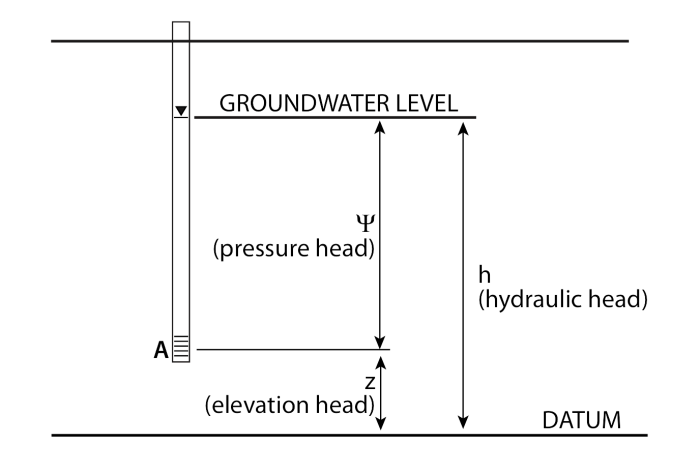
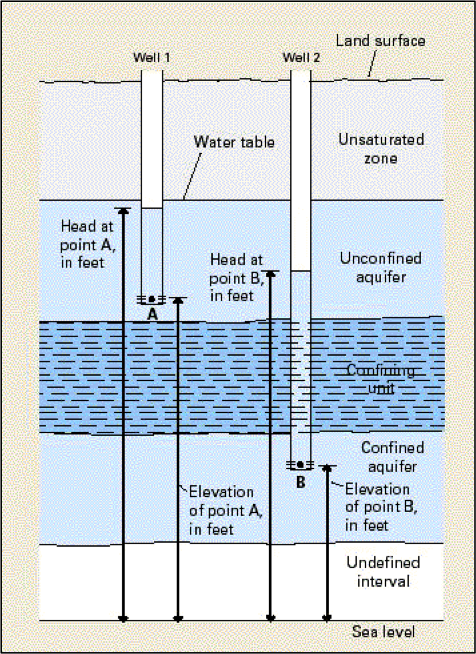
Click to expand to provide more information
Hydraulic Head and the Direction of Groundwater Flow
Hydraulic Head and the Direction of Groundwater Flow
In order to define groundwater flow directions and rates through aquifers, individual measurements of hydraulic head are combined to generate contour maps of water level – or potential energy (Figure 29). These maps define the potentiometric surface, which is much like a topographic contour map but defines the distribution of potential energy in the groundwater system. Each contour, or equipotential, represents a line of equal hydraulic head.
To first approximation, groundwater flows down-gradient (from high to low hydraulic head). As is the case with surface water, or a ball rolling down a hill, the water flows in the direction of the steepest gradient, meaning that it flows perpendicular to equipotentials. There are exceptions to this – for example, if the hydraulic conductivity of the aquifer is much higher in one direction than another, or dominated by fractures with particular orientations, then these can redirect groundwater flow askew to the maximum gradient.
The potentiometric map also provides clues about the rate of groundwater flow. If you think back to Darcy material and our in-class activity from last week, you will recall that groundwater flow rate depends on the head gradient (i.e. the hydraulic gradient) and hydraulic conductivity. In a simple one-dimensional Darcy tube experiment, the head gradient is just the difference (h1-h2)/L. In two dimensions, the head gradient is defined by the slope of the potentiometric surface – just as the slope of the land surface is defined on a topographic map. The path that water takes in the aquifer, defined as a continuous line tracing the maximum gradient on a map of the potentiometric surface, is known as a flowline.
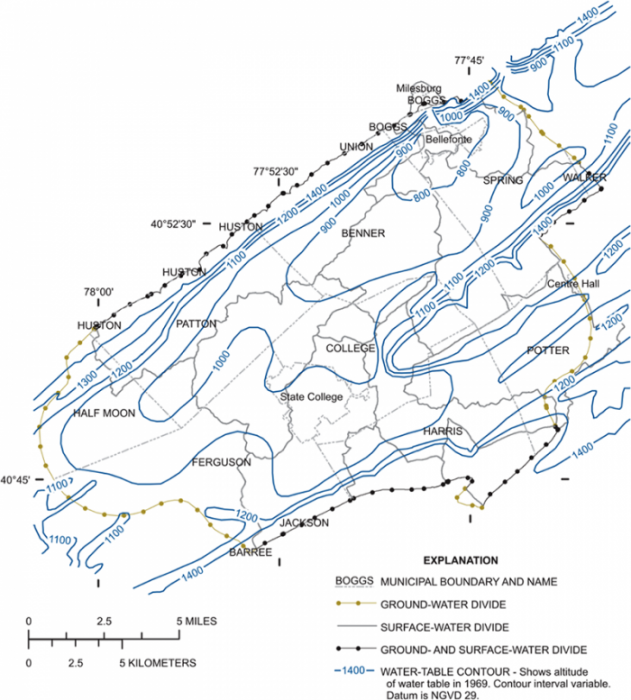
Well Hydrographs
Well Hydrographs
Just as river hydrographs are used to record and visualize variations in flow with time (as discussed in Module 4), a well hydrograph is a time series of hydraulic head recorded in a well. This provides information about the fluctuation of hydraulic head (equivalent to the water table in an unconfined aquifer), which reflects the combined effects of temporal variations in climate, recharge, and pumping (Figures 30-31). The U.S. Geological Survey maintains a database of active monitoring wells [52] in major aquifer systems across the United States. Hydrographs provide information about seasonal patterns that may be associated with pronounced wet and dry seasons typical of some regions (for example, Central CA), as well as long-term trends driven by climate change, decadal-scale climate patterns like el nino, prolonged groundwater extraction, or human-induced modifications to natural recharge. We’ll cover examples of the latter two processes in the next section of the module (Module 6.2: Water budgets).
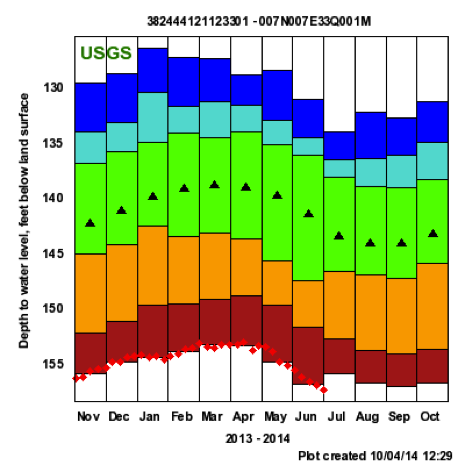
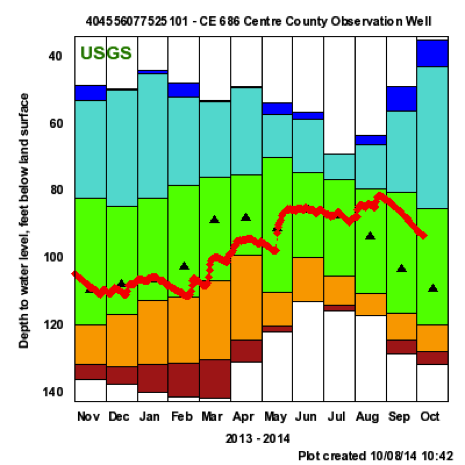
Effects of Pumping Wells
Effects of Pumping Wells
Groundwater is accessed by either pumping from wells drilled into the aquifer (Figure 33), or by developing natural springs where the potentiometric surface intersects the land surface (Big Spring in Bellefonte, PA is one example of a relatively large spring that is used for municipal supply). Although springs are relatively inexpensive to develop, they are not always present, nor are the flow rates always sufficient to support demand. As a result, most groundwater extraction occurs by pumping wells, or in many cases “fields” of wells concentrated in a small area.


Cones of Depression: Pumping at a well, or at a wellfield, pulls water toward the well from all directions – in other words, it induces radial flow (around the radius of the well). In doing so, pumping causes a reduction in hydraulic head, known as drawdown. This drawdown generates a cone- or funnel-shaped depression called a cone of depression (Figure 35). The reduction in hydraulic head drives groundwater flow to the well (in the down-gradient direction), as shown in the example from Long Island in Figure 36.
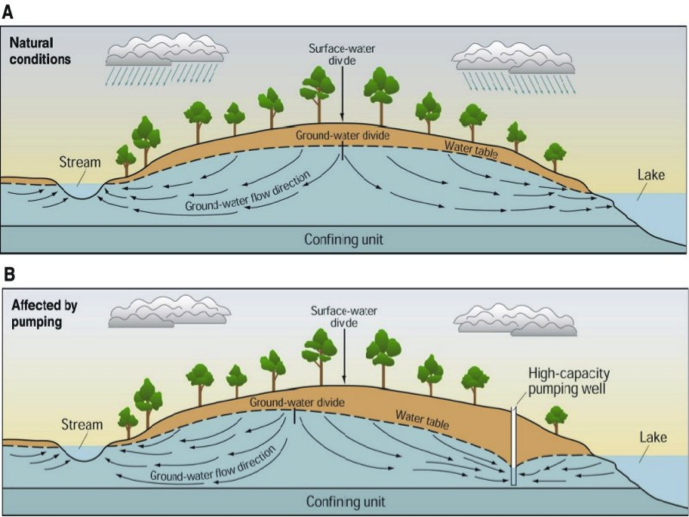
Click for more information
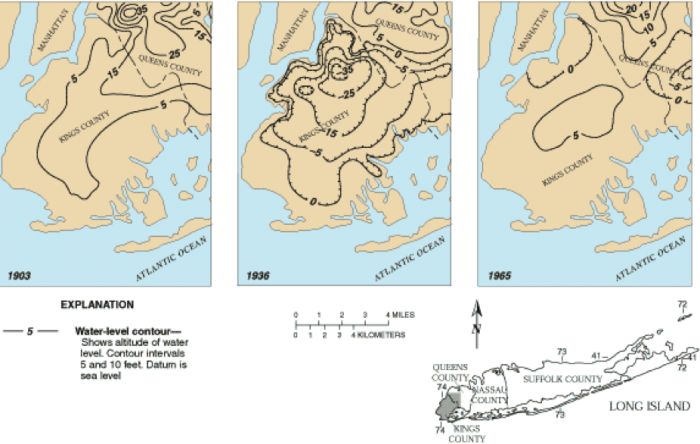
Both the width and the depth of the cone of depression scale with the rate of pumping, the aquifer permeability, and storativity, and the duration of pumping. In general, larger cones of depression result from larger pumping rates, higher permeability or lower storativity, and longer elapsed time. If cones of depression from two separate pumping wells grow large enough to overlap, it is known as well interference. When well interference occurs, the respective drawdowns are added together. The result is that drawdown is accelerated when multiple cones of depression interact. This is generally not desirable, and is one important consideration in the design, permitting, and operation of wells.
Not only does the cone of depression draw water to the well, but if the pumping rate is large enough or pumping is sustained for a long time, it can reverse the natural hydraulic gradient hundreds of meters to several tens of km away from the well(s). In some cases, this may result in interception of groundwater that would normally feed a stream or river as baseflow, and even in the interception of streamflow itself by inducing infiltration in the stream bed or banks (Figure 35B). In other cases, large cones of depression (up to a few miles wide!) associated with industrial or municipal well fields may reverse regional topographically-driven hydraulic gradients and lead to problems like saltwater intrusion (Figure 35B).
Groundwater Budgets
Groundwater Budgets
Now that you are an expert on how groundwater flows, we will apply that knowledge to the important problem of groundwater budgets. As groundwater flows through and exits an aquifer, for example at springs or at extraction wells, those losses of water may be balanced by recharge that percolates from the land surface. As you’ll investigate in the following section, and through a case study of the famous Ogallala aquifer in the American Midwest, understanding the budget of inflows and outflows to an aquifer is critical to evaluating the sustainability of groundwater use.
Fluxes (Inflows and Outflows) in Groundwater Systems
Fluxes (Inflows and Outflows) in Groundwater Systems
Fluxes (inflows and outflows) in Groundwater Systems: In order to define the water balance or water budget of an aquifer system, the individual processes that bring water into or out of the system must be quantified (Figure 37 on the next page).
Common inflows of water to a groundwater system include:
- Infiltration through the vadose zone that is not intercepted by evaporation, transpiration, or bound in the unsaturated zone, and thus becomes recharge. Infiltration may be distributed over large areas, or may be focused beneath surface water bodies or at geological features (e.g., sinkholes). Recharge may occur naturally or can be induced or enhanced by excavation and removal of low-permeability soils, and the construction of recharge pits, typically lined or filled with permeable sands (Figure 38 on the next page).
- Injection at wells, either for disposal of treated wastewater or as part of managed aquifer storage and recovery (ASR) programs. The latter is growing in popularity as one way to “bank” excess water in times of surplus, for example, wet seasons or wet years, and then tap the stored water when needed. Although energy-intensive because it requires pumping, ASR is not affected by evaporative losses whereas reservoirs are.
- Groundwater flow from areas outside of the region of interest – areas that are either up-gradient or above or below (i.e. flow across a confining layer).
Outflows from groundwater systems typically include:
- Evaporation or transpiration; this typically occurs in areas where the water table is shallow. Although direct evaporation of water from the water table is possible (in detail, this would occur by evaporation from the capillary fringe, and subsequent “wicking” of water upward from the water table), the upward flux (loss) of water from unconfined aquifers to the atmosphere is dominated by a family of plants known as phreatophytes, characterized by deep roots that extend to and below the water table.
- Water withdrawal by pumping from wells. As discussed in the previous section, pumping at wells induces radial flow toward the well. As the cone of depression grows, the well accesses water over a larger region of the aquifer. In some cases, as the cone of depression grows it may intercept water that would otherwise exit the aquifer via natural seeps or springs (e.g., Figure 37 on the next page), thus “redirecting” a flux that would have been an outflow somewhere else.
- Natural groundwater flow or discharge at springs or seeps, or to surface water bodies.
Surface Water-Groundwater Interaction
Surface Water-Groundwater Interaction
One specific class of inflow or outflow from groundwater systems results from surface water–groundwater interaction, water flows from aquifers into surface water bodies at seeps or springs, or infiltrates from rivers or lakes into aquifers (Figure 39; also note the dual-sided arrow between the aquifer and stream in Figure 37 indicating that the flux may be either to or from groundwater to surface water). If there is a net groundwater flux to surface water, the surface water body is said to be gaining (for example, a gaining stream is one that is fed by groundwater). As you may recall from Module 4, the component of streamflow derived from groundwater influx is termed baseflow. Alternatively, if the water table lies below the surface water body, the potential energy (hydraulic head) in the surface water body will be higher than in the groundwater system and water will percolate downward to the aquifer. In this configuration, the surface water body is said to be losing (i.e. a losing stream), because the stream or river discharge decreases downstream. While the land surface and stream channel generally remain at the same elevation, the water table commonly fluctuates over time (see Figures 32-33). As a result, it is common for streams to alternate between gaining to losing due to major recharge events, seasonality in precipitation and recharge, and variations in pumping rates.
Although water rights and policies are sometimes constructed with the implicit assumption that surface water and groundwater systems act independently, this is clearly not the case. A number of interesting situations arise from their interaction. As noted above in the Effects of Pumping Wells section, pumping at wells can reverse groundwater flow, and change a gaining stream to a losing one. In such a scenario, it isn’t always clear whether surface water rights are violated by groundwater pumping – even though groundwater extraction directly causes a reduction in surface water discharge, the water is withdrawn from the groundwater system, not the river. In large aquifer systems, the intercepted baseflow may impact users far downstream, across county and state borders. In other cases, also as noted earlier in this module, substantial or rapid influxes of surface water to groundwater systems, for example through fractures or sinkholes, can lead to groundwater contamination. If a direct connection between surface water and groundwater is demonstrated by the presence of microorganisms or increased water turbidity (cloudiness indicating suspended particles) in well water, additional treatment of groundwater is required before it is considered suitable for domestic or municipal use.
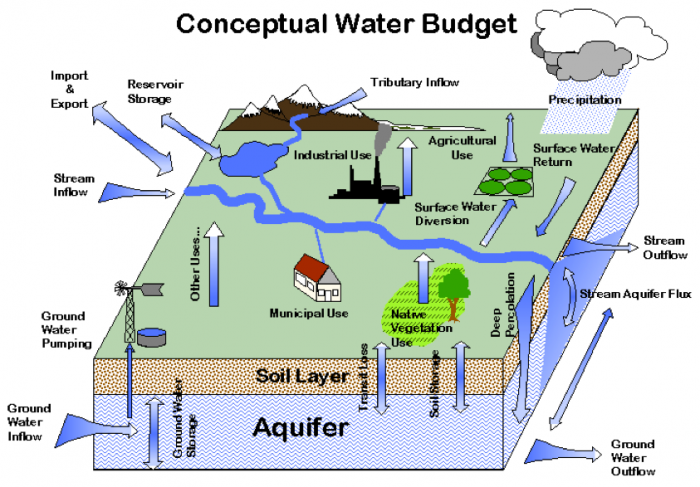
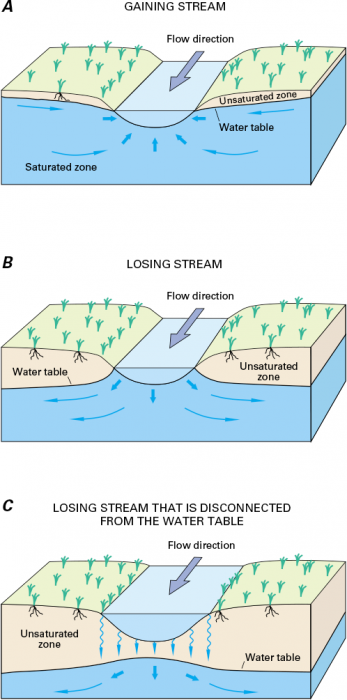
Water Budgets
Water Budgets
The balance of water inflows and outflows, or water budget, for a groundwater system, is described by a simple equation:
where I is the total of the inflows to the system, O the total outflows and ΔS is the change in storage. The water balance equation is no different than a bank statement: the difference between deposits (inflows) and withdrawals (outflows) is equal to the change in the account balance (storage). In the case of groundwater systems, changes in storage are manifested as changes in the potentiometric surface, either due to drop in the water table (in unconfined aquifers) or reduction in elastic storage as aquifer is depressurized (in confined aquifers).
In a steady state, or equilibrium condition, inflows and outflows are perfectly balanced (i.e. I = O in the budget equation above), and ΔS is zero. In other words, the potentiometric surface is steady. Often, groundwater systems are considered to be at steady state if inflows and outflows balance over a yearly or decadal timescale. This is because, in many aquifers, both recharge and extraction may be strongly seasonal. For example, recharge in many aquifers in the western US is mostly restricted to the winter months when precipitation is highest, and withdrawal rates are highest in the summer and early fall dry season. As a result, the potentiometric surface may fluctuate over the course of the year but is more-or-less constant over the long-term.
A variety of processes can lead to non-steady state conditions. Most notably in aquifers that are used heavily for irrigation, industry, or municipal supply, pumping may significantly exceed recharge, leading to net decreases in storage. In other cases, reduced recharge – for example due to urbanization and construction of impervious surfaces that do not allow infiltration, removal of leach fields upon installation of sewers (Figure 30), or long-term climate trends that drive changes in the amount or timing of precipitation – also results in negative changes in storage. Reductions in groundwater extraction, or periods of increased precipitation, will have the opposite effect and lead to increases in storage.
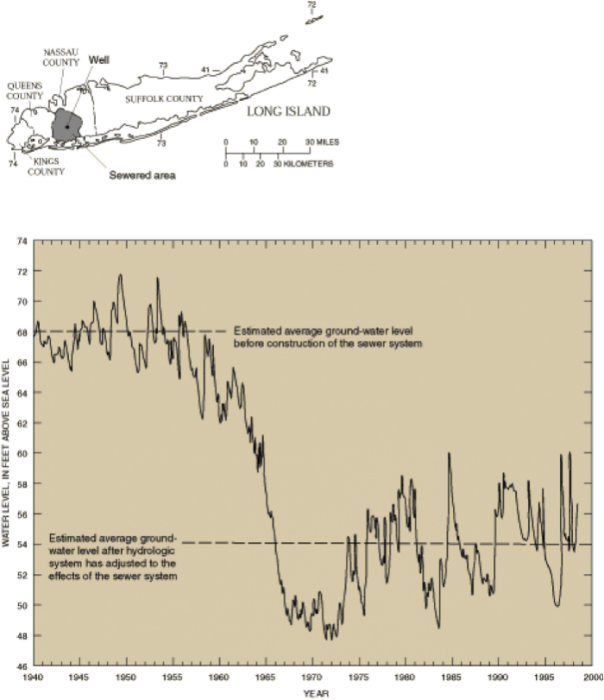
Overdraft
Overdraft
Groundwater overdraft is a specific condition in which extraction greatly exceeds the influxes of water (mainly recharge). This produces an unsustainable condition characterized by sustained declining water levels. Much like overdraft of a bank account, groundwater overdraft is not a desirable state of affairs. Not only is it unsustainable in terms of management of the groundwater resource, but it also leads to long-lasting damages (a lot like what happens to your credit rating if your bank account is overdrafted!).
Depressurization of the aquifer, if large enough, may cause irreversible collapse and compaction. This reduces both storage (porosity) .and hydraulic conductivity. It can also lead to land subsidence, especially in cases where the magnitude of overdraft is large and the aquifer units are thick and highly compressible, as is common for unconsolidated or uncemented sedimentary aquifers. One well-known example of groundwater overdraft is the Central Valley of California (Figure 41). Another is the Ogallala aquifer, a major groundwater system spanning across eight states in the American Midwest (Figure 43; see The High Plains Aquifer section). Substantial overdraft and subsidence also occur in widespread areas of the southeastern U.S., the Gulf Coast, and parts of Arizona and Las Vegas (Figure 44).
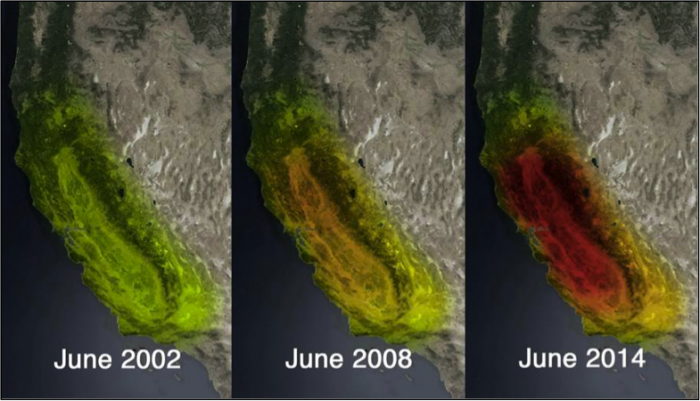
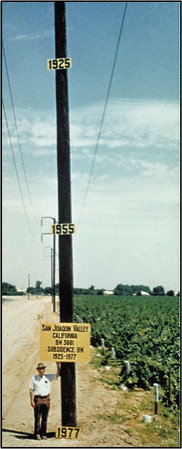
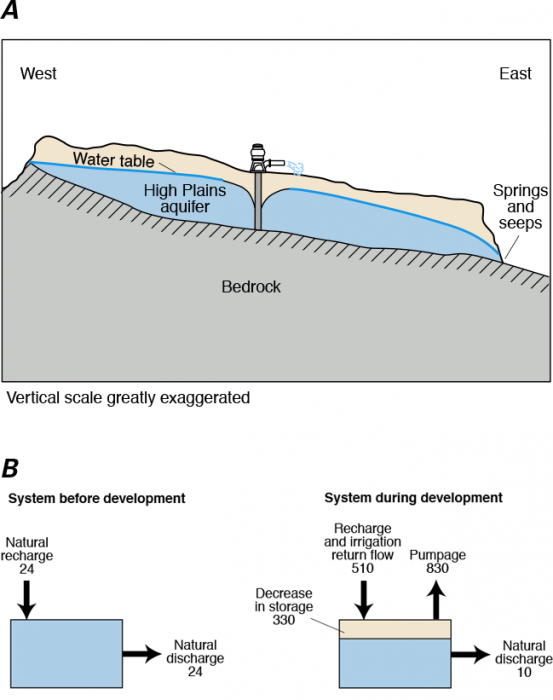
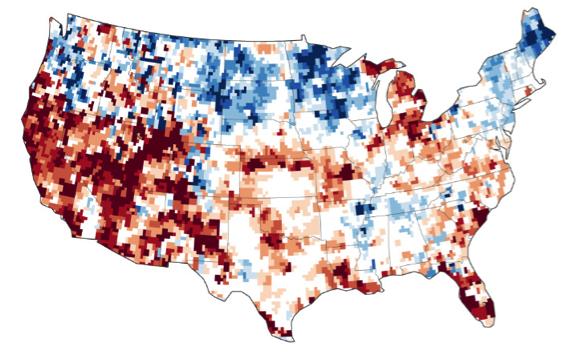
The High Plains Aquifer
The High Plains Aquifer
The High Plains Aquifer system consists of Tertiary sedimentary rock, dominantly sandstone and gravel (Figure 45), eroded from the ancient Rocky Mountains and deposited in the Tertiary period (from about 31 to 5 million years ago). The Ogallala Formation is the primary aquifer unit in the system. The aquifer underlies almost 175,000 mi2 and spans eight states, with most of its area in Nebraska, Texas, and Kansas. This region is among the largest and most productive croplands in the U.S. and is the source of almost 20% of our corn, wheat, and cotton production, as well as a significant portion of our soybeans, sorghum, and alfalfa. It is also host to almost 20% of the cattle raised in the US. Because the climate is semi-arid, with mean annual precipitation ranging from 12 inches in the West to 33 inches in the East, growing economically viable crops requires substantial irrigation. If you have ever flown over the Midwest on a clear day you may have seen circular “patches” of irrigated land - the hallmark of center-pivot irrigation systems (Figure 46).
Although farming has been a major part of the economy in the region since the late 1800s, in the 1960’s new technology in electrical pumps allowed access to deeper groundwater and ushered in an era of rapidly expanding irrigated acreage (Figure 47). Accompanying this expansion, aquifer-wide groundwater withdrawals increased from a few million acre-feet (M-AF) per year to almost 20 M-AF. Water level declines began in the 1950s, with the onset of intensive groundwater extraction for irrigation-based agriculture. The total overdraft of the aquifer is almost 250 million acre-feet, from pre-development (ca. 1950) to 2011 – this is almost 17 times the annual flow of the Colorado River.
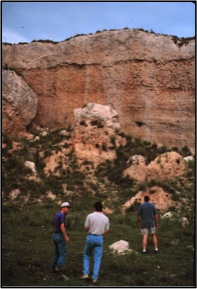
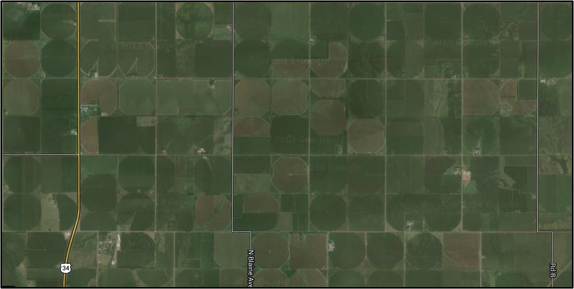
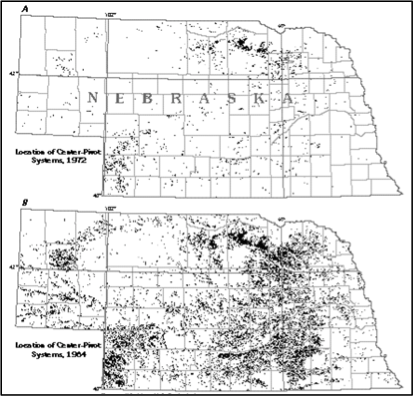

As a consequence of sustained overdraft for several decades (see Figure 42 above), water levels in the aquifer have dropped substantially, by more than 100 feet in many areas (Figure 48). Over half of this decline has occurred since 2000. Water level declines are not evenly distributed, however. The highest rates of decline are focused in the southern reaches of the aquifer system, where recharge rates are low and irrigation demand is highest. In the northern portions of the aquifer system, water level declines are considerably smaller – and in some cases, the water table has actually risen – primarily due to locally higher recharge focused along the Platte River (Figure 48).
Capstone Project Introduction
Capstone Project Introduction
Looking Forward: Capstone Project Expectations
For your Capstone Project in this class, you will be developing a water plan for a water-critical city of your choosing. The assignment includes a 10-slide presentation (no more) and written report (including at least 5 significant references). If you would like to read a more detailed description of the Capstone Project, you can look ahead to the Capstone Project [60] at the end of Unit 3. For right now, the critical thing is that you choose the city for which you would like to develop a water plan and submit your selection in Canvas using the discussion thread in the Unit 2 Reflection module [week 9] module. A list of cities to choose from is provided below. Requests for other cities will be considered if you can provide justification for your selection.
Instructions
- Pick a city from the list below or propose one: (note: if you are proposing a new city, you must check with us first by sending an email via Canvas including the name of the city and the water concerns.
- Los Angeles, CA
- San Diego, CA
- San Francisco, CA
- Las Vegas, NV
- Tucson, AZ
- Denver, CO
- Flint, MI
- Miami, FL
- Delhi, India
- Dubai, UAE
- Mexico City, Mexico
- Sao Paolo, Brazil
- Khartoum, Sudan
- Nairobi, Kenya
- Beijing, China
- Cairo, Egypt
- London, England
- Bangalore, India
- Tokyo, Japan
- Tehran, Iran
- Submit your selection via Canvas using the discussion thread in the Week 9 folder.
